Quick filters:
Theban triad Stock Photos and Images
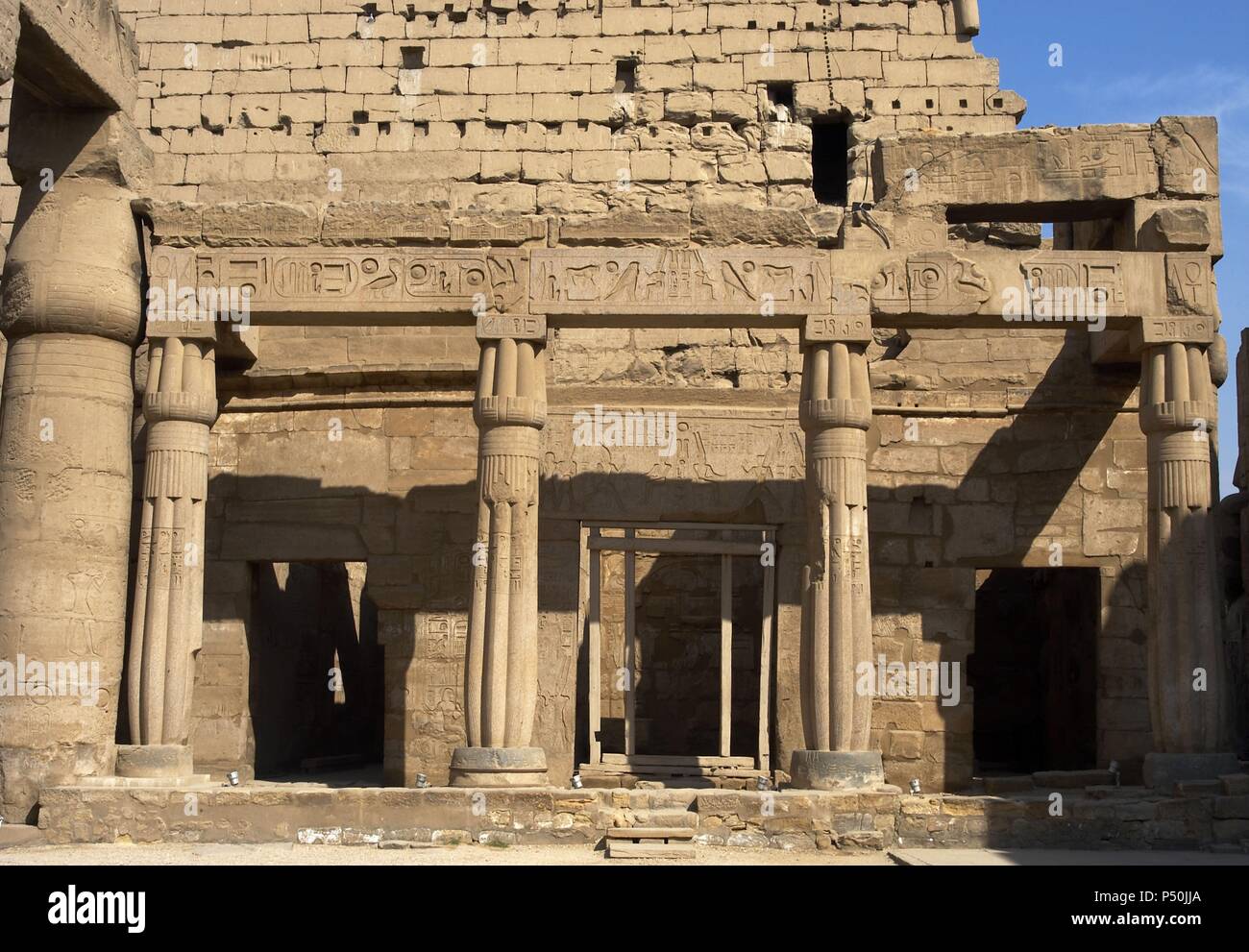 Luxor temple. Chapel dedicated to the Theban triad formed by the gods Amun, Mut and Khonsu. North side of the first court of Ramses II. New Empire. Egypt. Stock Photohttps://www.alamy.com/image-license-details/?v=1https://www.alamy.com/luxor-temple-chapel-dedicated-to-the-theban-triad-formed-by-the-gods-amun-mut-and-khonsu-north-side-of-the-first-court-of-ramses-ii-new-empire-egypt-image209612322.html
Luxor temple. Chapel dedicated to the Theban triad formed by the gods Amun, Mut and Khonsu. North side of the first court of Ramses II. New Empire. Egypt. Stock Photohttps://www.alamy.com/image-license-details/?v=1https://www.alamy.com/luxor-temple-chapel-dedicated-to-the-theban-triad-formed-by-the-gods-amun-mut-and-khonsu-north-side-of-the-first-court-of-ramses-ii-new-empire-egypt-image209612322.htmlRMP50JJA–Luxor temple. Chapel dedicated to the Theban triad formed by the gods Amun, Mut and Khonsu. North side of the first court of Ramses II. New Empire. Egypt.
 Amulet of the Theban Triad, Amun, Mut, and Khonsu, Late Period, Dynasty 26–31 (664–332 BC), Egyptian, Egypt, Faience, 4.4 × 2.5 × 0.3 cm (1 3/4 × 1 × 1/8 in Stock Photohttps://www.alamy.com/image-license-details/?v=1https://www.alamy.com/amulet-of-the-theban-triad-amun-mut-and-khonsu-late-period-dynasty-2631-664332-bc-egyptian-egypt-faience-44-25-03-cm-1-34-1-18-in-image328615384.html
Amulet of the Theban Triad, Amun, Mut, and Khonsu, Late Period, Dynasty 26–31 (664–332 BC), Egyptian, Egypt, Faience, 4.4 × 2.5 × 0.3 cm (1 3/4 × 1 × 1/8 in Stock Photohttps://www.alamy.com/image-license-details/?v=1https://www.alamy.com/amulet-of-the-theban-triad-amun-mut-and-khonsu-late-period-dynasty-2631-664332-bc-egyptian-egypt-faience-44-25-03-cm-1-34-1-18-in-image328615384.htmlRM2A2HM7M–Amulet of the Theban Triad, Amun, Mut, and Khonsu, Late Period, Dynasty 26–31 (664–332 BC), Egyptian, Egypt, Faience, 4.4 × 2.5 × 0.3 cm (1 3/4 × 1 × 1/8 in
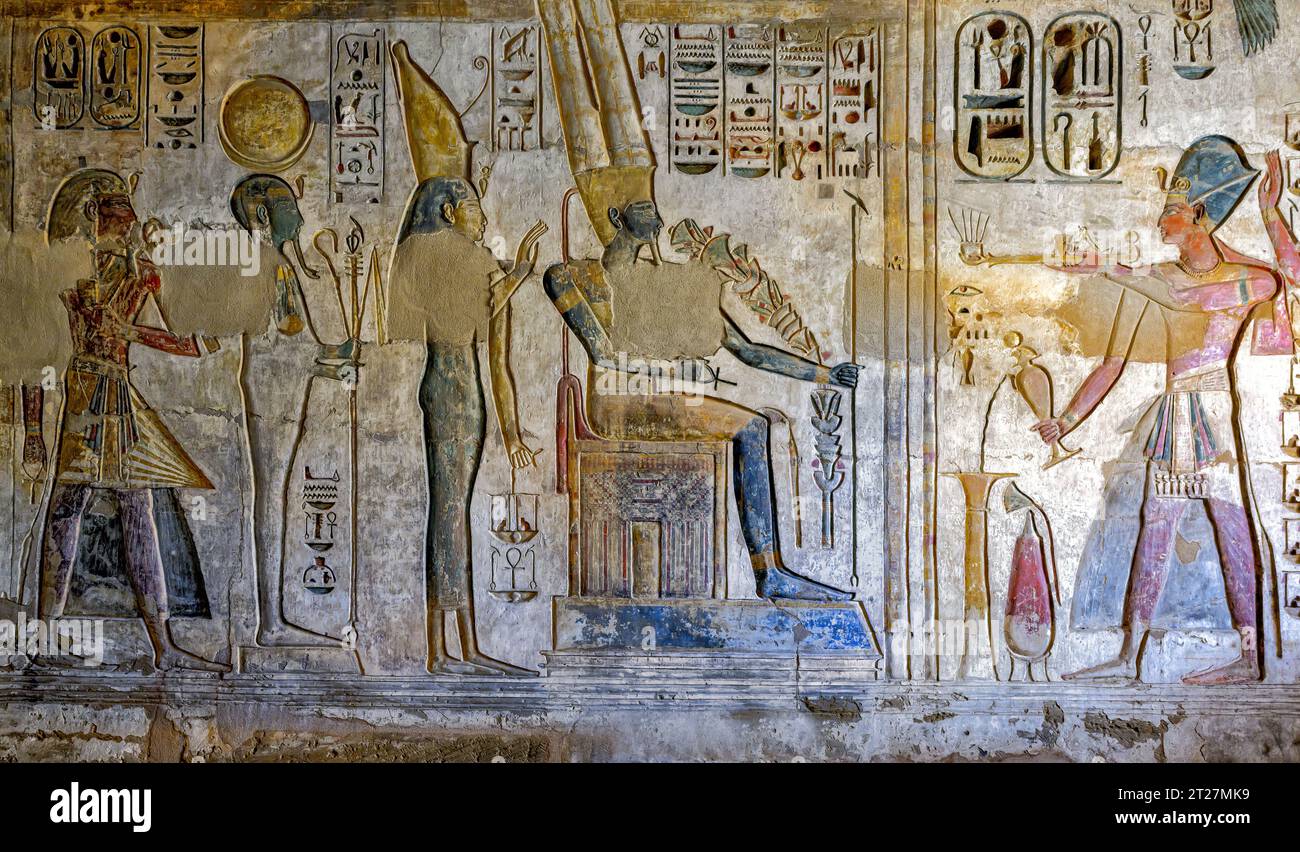 Ramesses III makes an offering to his ancestor, Ramesses II, before the Theban Triad of Amun-Ra, Mut and Khonsu Stock Photohttps://www.alamy.com/image-license-details/?v=1https://www.alamy.com/ramesses-iii-makes-an-offering-to-his-ancestor-ramesses-ii-before-the-theban-triad-of-amun-ra-mut-and-khonsu-image569341341.html
Ramesses III makes an offering to his ancestor, Ramesses II, before the Theban Triad of Amun-Ra, Mut and Khonsu Stock Photohttps://www.alamy.com/image-license-details/?v=1https://www.alamy.com/ramesses-iii-makes-an-offering-to-his-ancestor-ramesses-ii-before-the-theban-triad-of-amun-ra-mut-and-khonsu-image569341341.htmlRM2T27MK9–Ramesses III makes an offering to his ancestor, Ramesses II, before the Theban Triad of Amun-Ra, Mut and Khonsu
 Karnak Temple Complex, in Luxor, Egypt. Construction at the complex began during the reign of Senusret I in the Middle Kingdom and continued into the Ptolemaic period, although most of the extant buildings date from the New Kingdom. The area around Karnak was the main place of worship of the eighteenth dynasty Theban Triad with the god Amun as its head. It is part of the monumental city of Thebes. Stock Photohttps://www.alamy.com/image-license-details/?v=1https://www.alamy.com/karnak-temple-complex-in-luxor-egypt-construction-at-the-complex-began-during-the-reign-of-senusret-i-in-the-middle-kingdom-and-continued-into-the-ptolemaic-period-although-most-of-the-extant-buildings-date-from-the-new-kingdom-the-area-around-karnak-was-the-main-place-of-worship-of-the-eighteenth-dynasty-theban-triad-with-the-god-amun-as-its-head-it-is-part-of-the-monumental-city-of-thebes-image328340283.html
Karnak Temple Complex, in Luxor, Egypt. Construction at the complex began during the reign of Senusret I in the Middle Kingdom and continued into the Ptolemaic period, although most of the extant buildings date from the New Kingdom. The area around Karnak was the main place of worship of the eighteenth dynasty Theban Triad with the god Amun as its head. It is part of the monumental city of Thebes. Stock Photohttps://www.alamy.com/image-license-details/?v=1https://www.alamy.com/karnak-temple-complex-in-luxor-egypt-construction-at-the-complex-began-during-the-reign-of-senusret-i-in-the-middle-kingdom-and-continued-into-the-ptolemaic-period-although-most-of-the-extant-buildings-date-from-the-new-kingdom-the-area-around-karnak-was-the-main-place-of-worship-of-the-eighteenth-dynasty-theban-triad-with-the-god-amun-as-its-head-it-is-part-of-the-monumental-city-of-thebes-image328340283.htmlRM2A255AK–Karnak Temple Complex, in Luxor, Egypt. Construction at the complex began during the reign of Senusret I in the Middle Kingdom and continued into the Ptolemaic period, although most of the extant buildings date from the New Kingdom. The area around Karnak was the main place of worship of the eighteenth dynasty Theban Triad with the god Amun as its head. It is part of the monumental city of Thebes.
 Luxor temple. Chapel dedicated to the Theban triad. Stock Photohttps://www.alamy.com/image-license-details/?v=1https://www.alamy.com/stock-photo-luxor-temple-chapel-dedicated-to-the-theban-triad-27236981.html
Luxor temple. Chapel dedicated to the Theban triad. Stock Photohttps://www.alamy.com/image-license-details/?v=1https://www.alamy.com/stock-photo-luxor-temple-chapel-dedicated-to-the-theban-triad-27236981.htmlRMBG8N19–Luxor temple. Chapel dedicated to the Theban triad.
 . Amun-Re, chief god of the Theban Triad. Relief from the Karnak temple complex. . circa 1450BC. Anonymous 42 Amun-Ra Stock Photohttps://www.alamy.com/image-license-details/?v=1https://www.alamy.com/amun-re-chief-god-of-the-theban-triad-relief-from-the-karnak-temple-complex-circa-1450bc-anonymous-42-amun-ra-image184882903.html
. Amun-Re, chief god of the Theban Triad. Relief from the Karnak temple complex. . circa 1450BC. Anonymous 42 Amun-Ra Stock Photohttps://www.alamy.com/image-license-details/?v=1https://www.alamy.com/amun-re-chief-god-of-the-theban-triad-relief-from-the-karnak-temple-complex-circa-1450bc-anonymous-42-amun-ra-image184882903.htmlRMMMP40R–. Amun-Re, chief god of the Theban Triad. Relief from the Karnak temple complex. . circa 1450BC. Anonymous 42 Amun-Ra
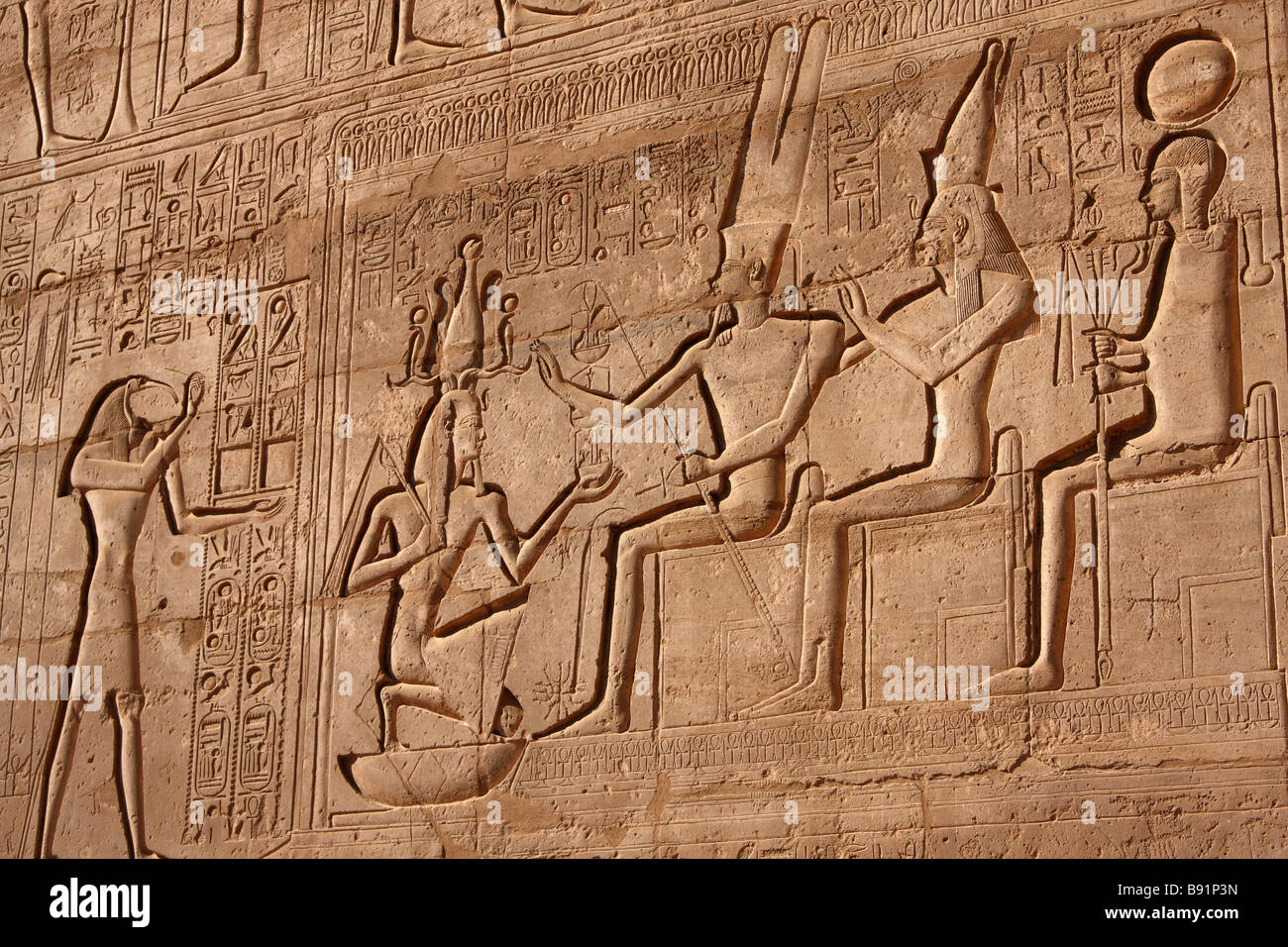 Egyptian wall relief scene. God Thoth, Ramses II, Theban family triad of Amun, Mut and Khonsu. Ramesseum Temple, Luxor, Egypt Stock Photohttps://www.alamy.com/image-license-details/?v=1https://www.alamy.com/stock-photo-egyptian-wall-relief-scene-god-thoth-ramses-ii-theban-family-triad-22781577.html
Egyptian wall relief scene. God Thoth, Ramses II, Theban family triad of Amun, Mut and Khonsu. Ramesseum Temple, Luxor, Egypt Stock Photohttps://www.alamy.com/image-license-details/?v=1https://www.alamy.com/stock-photo-egyptian-wall-relief-scene-god-thoth-ramses-ii-theban-family-triad-22781577.htmlRMB91P3N–Egyptian wall relief scene. God Thoth, Ramses II, Theban family triad of Amun, Mut and Khonsu. Ramesseum Temple, Luxor, Egypt
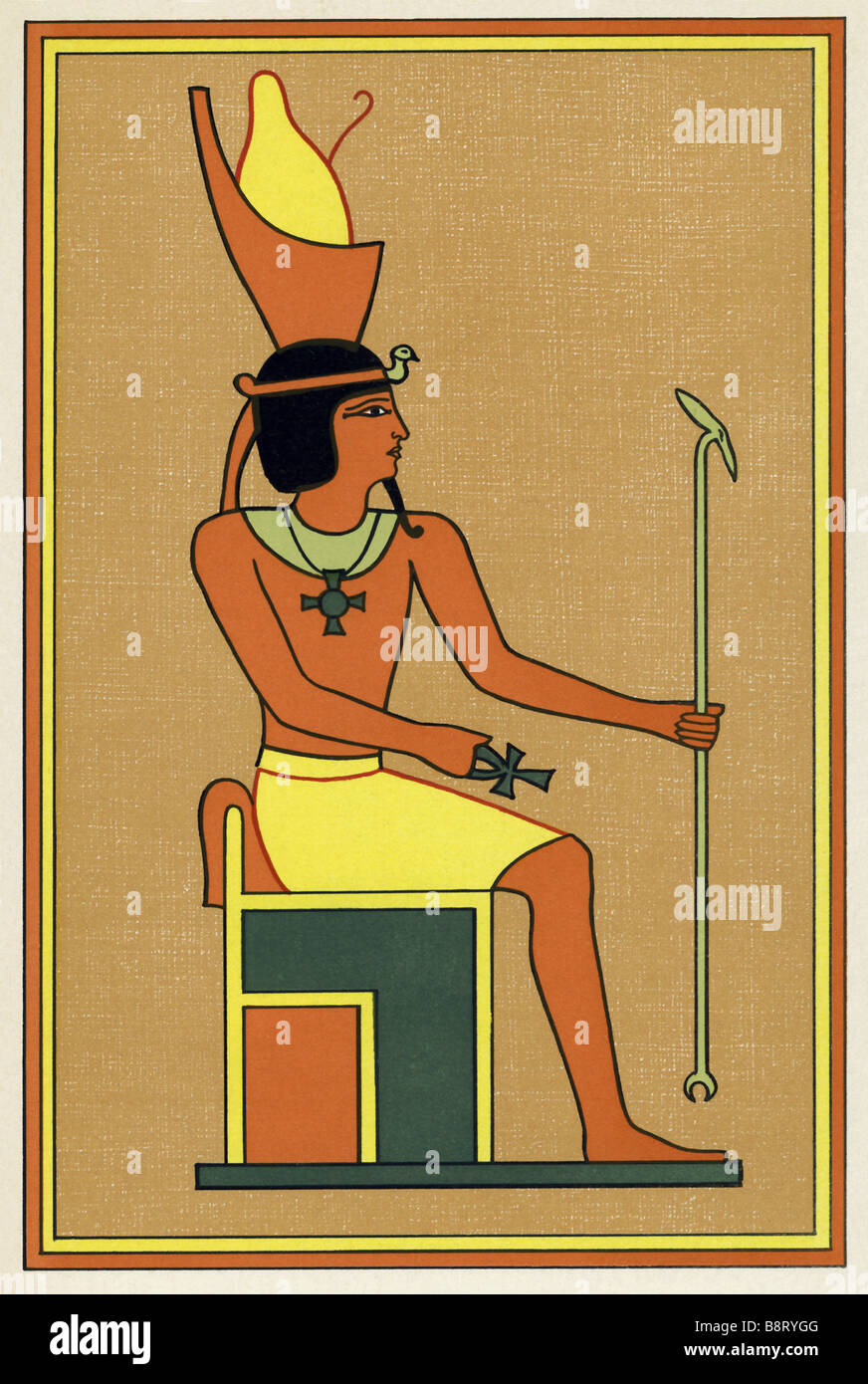 God Khons Nefer hotep Stock Photohttps://www.alamy.com/image-license-details/?v=1https://www.alamy.com/stock-photo-god-khons-nefer-hotep-22654144.html
God Khons Nefer hotep Stock Photohttps://www.alamy.com/image-license-details/?v=1https://www.alamy.com/stock-photo-god-khons-nefer-hotep-22654144.htmlRFB8RYGG–God Khons Nefer hotep
 The first pylon of the Temple of Khonsu, Karnak Temple, Luxor, Egypt Stock Photohttps://www.alamy.com/image-license-details/?v=1https://www.alamy.com/stock-photo-the-first-pylon-of-the-temple-of-khonsu-karnak-temple-luxor-egypt-23461174.html
The first pylon of the Temple of Khonsu, Karnak Temple, Luxor, Egypt Stock Photohttps://www.alamy.com/image-license-details/?v=1https://www.alamy.com/stock-photo-the-first-pylon-of-the-temple-of-khonsu-karnak-temple-luxor-egypt-23461174.htmlRFBA4MY2–The first pylon of the Temple of Khonsu, Karnak Temple, Luxor, Egypt
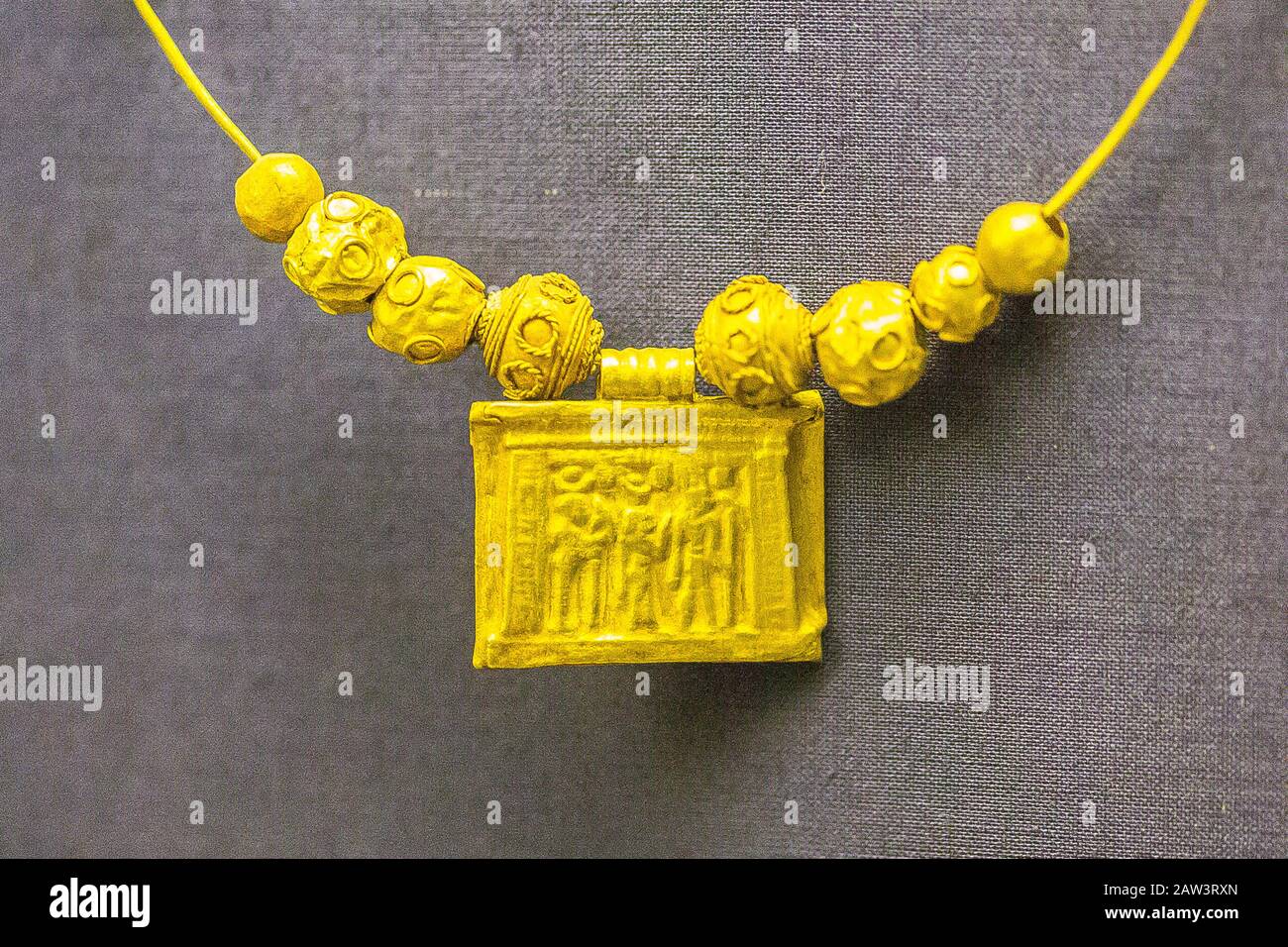 Egypt, Cairo, Egyptian Museum, a pendant, in gold, found in Dendera, Ptolemaic period. It depicts a naos with the theban triad (Amon, Mut, Khonsu). Stock Photohttps://www.alamy.com/image-license-details/?v=1https://www.alamy.com/egypt-cairo-egyptian-museum-a-pendant-in-gold-found-in-dendera-ptolemaic-period-it-depicts-a-naos-with-the-theban-triad-amon-mut-khonsu-image342448029.html
Egypt, Cairo, Egyptian Museum, a pendant, in gold, found in Dendera, Ptolemaic period. It depicts a naos with the theban triad (Amon, Mut, Khonsu). Stock Photohttps://www.alamy.com/image-license-details/?v=1https://www.alamy.com/egypt-cairo-egyptian-museum-a-pendant-in-gold-found-in-dendera-ptolemaic-period-it-depicts-a-naos-with-the-theban-triad-amon-mut-khonsu-image342448029.htmlRM2AW3RXN–Egypt, Cairo, Egyptian Museum, a pendant, in gold, found in Dendera, Ptolemaic period. It depicts a naos with the theban triad (Amon, Mut, Khonsu).
 Ancient Egyptian. Amulet of the Theban Triad, Amun, Mut, and Khonsu. 664 BC–332 BC. Egypt. Faience Stock Photohttps://www.alamy.com/image-license-details/?v=1https://www.alamy.com/ancient-egyptian-amulet-of-the-theban-triad-amun-mut-and-khonsu-664-bc332-bc-egypt-faience-image337939852.html
Ancient Egyptian. Amulet of the Theban Triad, Amun, Mut, and Khonsu. 664 BC–332 BC. Egypt. Faience Stock Photohttps://www.alamy.com/image-license-details/?v=1https://www.alamy.com/ancient-egyptian-amulet-of-the-theban-triad-amun-mut-and-khonsu-664-bc332-bc-egypt-faience-image337939852.htmlRM2AHPDMC–Ancient Egyptian. Amulet of the Theban Triad, Amun, Mut, and Khonsu. 664 BC–332 BC. Egypt. Faience
 Egyptian cartouche with the name of Alexander to the Theban triad Amun-Ra, Mut and Jonsu, and where he appears adorned with the attributes of a pharao Stock Photohttps://www.alamy.com/image-license-details/?v=1https://www.alamy.com/egyptian-cartouche-with-the-name-of-alexander-to-the-theban-triad-amun-ra-mut-and-jonsu-and-where-he-appears-adorned-with-the-attributes-of-a-pharao-image619261178.html
Egyptian cartouche with the name of Alexander to the Theban triad Amun-Ra, Mut and Jonsu, and where he appears adorned with the attributes of a pharao Stock Photohttps://www.alamy.com/image-license-details/?v=1https://www.alamy.com/egyptian-cartouche-with-the-name-of-alexander-to-the-theban-triad-amun-ra-mut-and-jonsu-and-where-he-appears-adorned-with-the-attributes-of-a-pharao-image619261178.htmlRF2XYDNXJ–Egyptian cartouche with the name of Alexander to the Theban triad Amun-Ra, Mut and Jonsu, and where he appears adorned with the attributes of a pharao
 Ramesses-Nakht,High Priest of Amun,kneels to present a small shrine upon which are represented the Theban Triad of Amun,Mut,and their son Khons.From K Stock Photohttps://www.alamy.com/image-license-details/?v=1https://www.alamy.com/ramesses-nakhthigh-priest-of-amunkneels-to-present-a-small-shrine-upon-which-are-represented-the-theban-triad-of-amunmutand-their-son-khonsfrom-k-image428893039.html
Ramesses-Nakht,High Priest of Amun,kneels to present a small shrine upon which are represented the Theban Triad of Amun,Mut,and their son Khons.From K Stock Photohttps://www.alamy.com/image-license-details/?v=1https://www.alamy.com/ramesses-nakhthigh-priest-of-amunkneels-to-present-a-small-shrine-upon-which-are-represented-the-theban-triad-of-amunmutand-their-son-khonsfrom-k-image428893039.htmlRF2FWNNCF–Ramesses-Nakht,High Priest of Amun,kneels to present a small shrine upon which are represented the Theban Triad of Amun,Mut,and their son Khons.From K
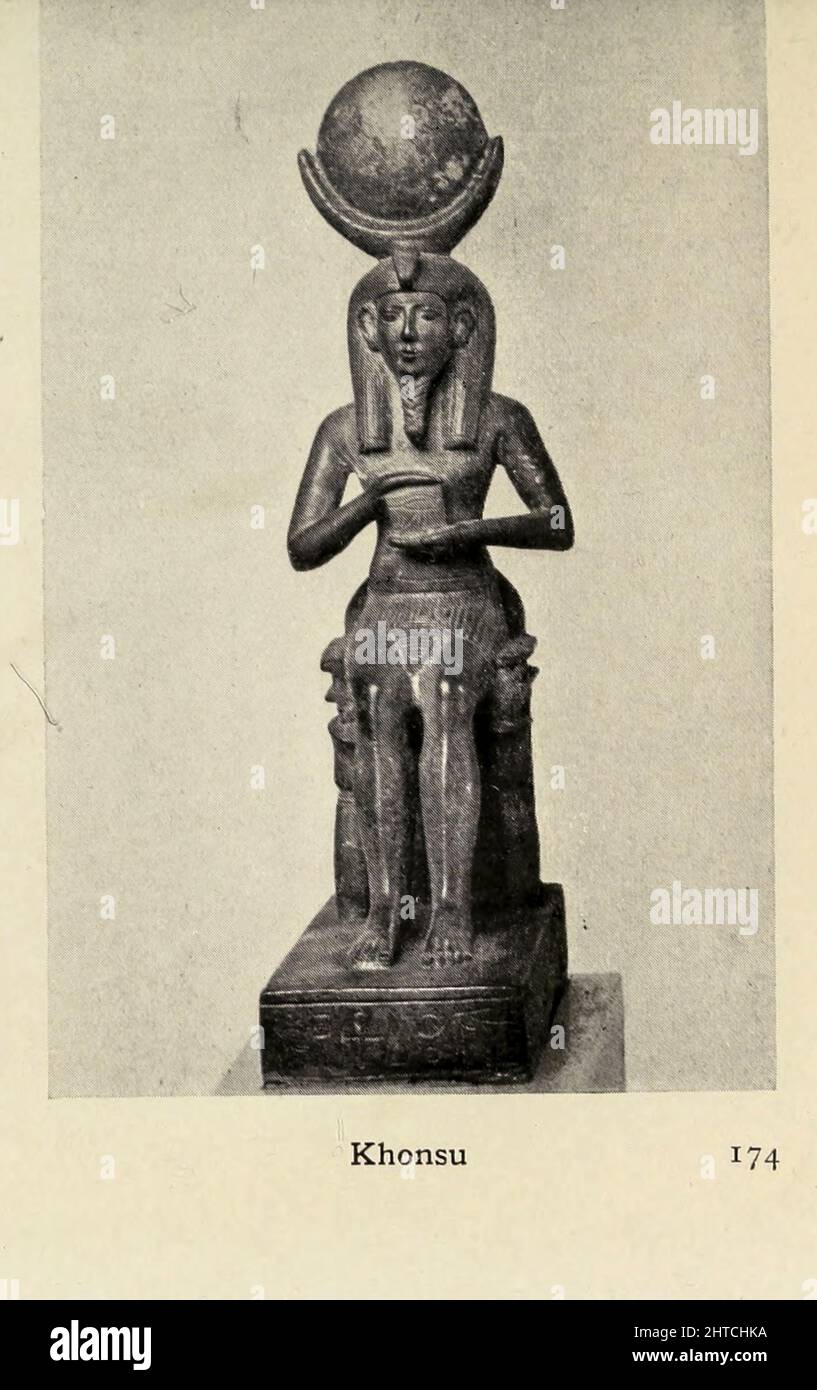 Khonsu (also transliterated Chonsu, Khensu, Khons, Chons or Khonshu) is the ancient Egyptian god of the Moon. His name means 'traveller', and this may relate to the perceived nightly travel of the Moon across the sky. Along with Thoth he marked the passage of time. Khonsu was instrumental in the creation of new life in all living creatures. At Thebes he formed part of a family triad (the 'Theban Triad') with Mut as his mother and Amun his father. From the book ' Myths and legends : ancient Egypt ' by Lewis Spence, Published Boston : D.D. Nickerson 1910 Stock Photohttps://www.alamy.com/image-license-details/?v=1https://www.alamy.com/khonsu-also-transliterated-chonsu-khensu-khons-chons-or-khonshu-is-the-ancient-egyptian-god-of-the-moon-his-name-means-traveller-and-this-may-relate-to-the-perceived-nightly-travel-of-the-moon-across-the-sky-along-with-thoth-he-marked-the-passage-of-time-khonsu-was-instrumental-in-the-creation-of-new-life-in-all-living-creatures-at-thebes-he-formed-part-of-a-family-triad-the-theban-triad-with-mut-as-his-mother-and-amun-his-father-from-the-book-myths-and-legends-ancient-egypt-by-lewis-spence-published-boston-dd-nickerson-1910-image462498606.html
Khonsu (also transliterated Chonsu, Khensu, Khons, Chons or Khonshu) is the ancient Egyptian god of the Moon. His name means 'traveller', and this may relate to the perceived nightly travel of the Moon across the sky. Along with Thoth he marked the passage of time. Khonsu was instrumental in the creation of new life in all living creatures. At Thebes he formed part of a family triad (the 'Theban Triad') with Mut as his mother and Amun his father. From the book ' Myths and legends : ancient Egypt ' by Lewis Spence, Published Boston : D.D. Nickerson 1910 Stock Photohttps://www.alamy.com/image-license-details/?v=1https://www.alamy.com/khonsu-also-transliterated-chonsu-khensu-khons-chons-or-khonshu-is-the-ancient-egyptian-god-of-the-moon-his-name-means-traveller-and-this-may-relate-to-the-perceived-nightly-travel-of-the-moon-across-the-sky-along-with-thoth-he-marked-the-passage-of-time-khonsu-was-instrumental-in-the-creation-of-new-life-in-all-living-creatures-at-thebes-he-formed-part-of-a-family-triad-the-theban-triad-with-mut-as-his-mother-and-amun-his-father-from-the-book-myths-and-legends-ancient-egypt-by-lewis-spence-published-boston-dd-nickerson-1910-image462498606.htmlRF2HTCHKA–Khonsu (also transliterated Chonsu, Khensu, Khons, Chons or Khonshu) is the ancient Egyptian god of the Moon. His name means 'traveller', and this may relate to the perceived nightly travel of the Moon across the sky. Along with Thoth he marked the passage of time. Khonsu was instrumental in the creation of new life in all living creatures. At Thebes he formed part of a family triad (the 'Theban Triad') with Mut as his mother and Amun his father. From the book ' Myths and legends : ancient Egypt ' by Lewis Spence, Published Boston : D.D. Nickerson 1910
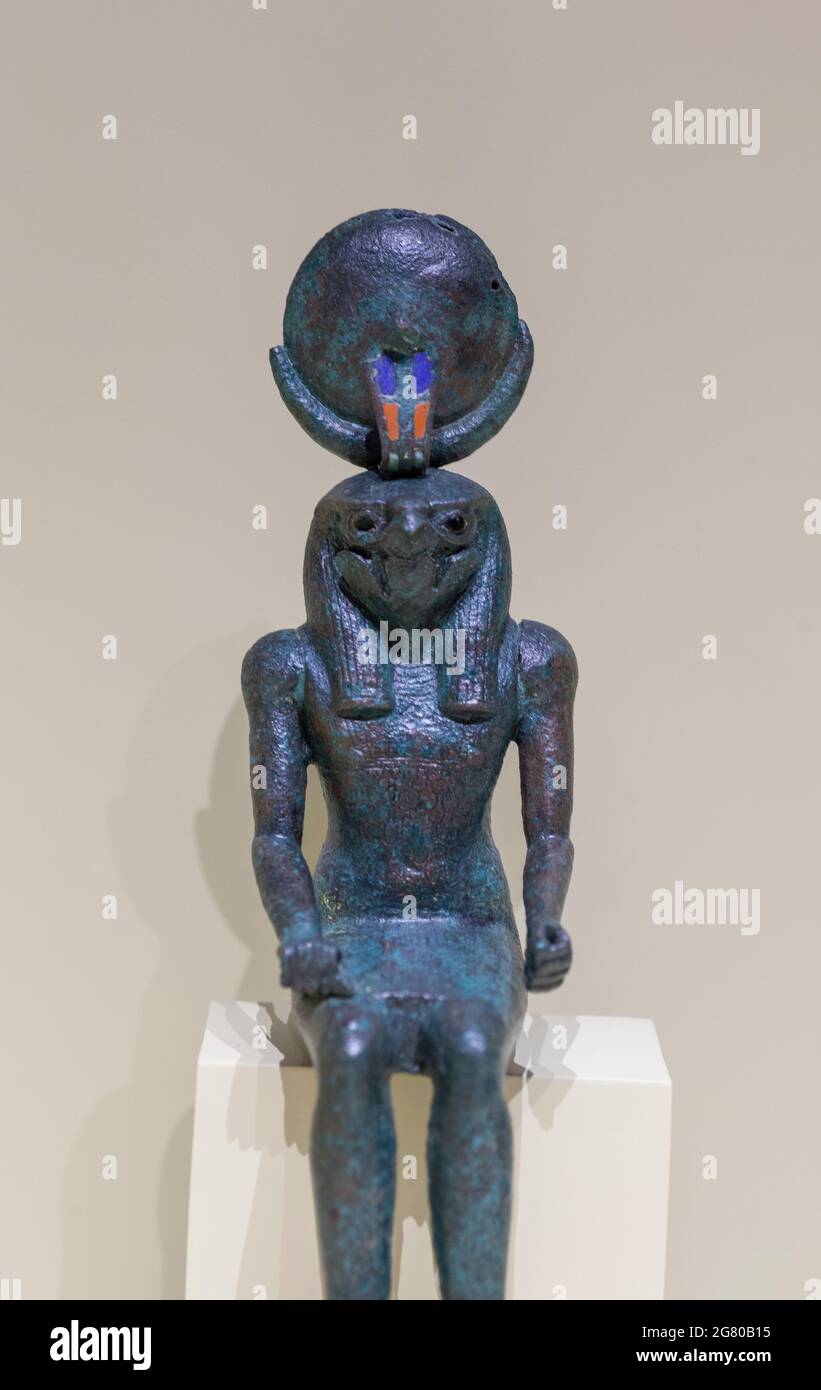 Ancient Egypt God Khonsu, son of Amun and Mut. Bronze. Late period. National Archaelogical Museum, Spain. Depicted as a falcon wearing the moon Stock Photohttps://www.alamy.com/image-license-details/?v=1https://www.alamy.com/ancient-egypt-god-khonsu-son-of-amun-and-mut-bronze-late-period-national-archaelogical-museum-spain-depicted-as-a-falcon-wearing-the-moon-image435185105.html
Ancient Egypt God Khonsu, son of Amun and Mut. Bronze. Late period. National Archaelogical Museum, Spain. Depicted as a falcon wearing the moon Stock Photohttps://www.alamy.com/image-license-details/?v=1https://www.alamy.com/ancient-egypt-god-khonsu-son-of-amun-and-mut-bronze-late-period-national-archaelogical-museum-spain-depicted-as-a-falcon-wearing-the-moon-image435185105.htmlRM2G80B15–Ancient Egypt God Khonsu, son of Amun and Mut. Bronze. Late period. National Archaelogical Museum, Spain. Depicted as a falcon wearing the moon
 Amulet of the Theban Triad, Amun, Mut, and Khonsu, Egypt, Late Period, Dynasty 26-31 (664-332 BCE). Stock Photohttps://www.alamy.com/image-license-details/?v=1https://www.alamy.com/amulet-of-the-theban-triad-amun-mut-and-khonsu-egypt-late-period-dynasty-26-31-664-332-bce-image444291900.html
Amulet of the Theban Triad, Amun, Mut, and Khonsu, Egypt, Late Period, Dynasty 26-31 (664-332 BCE). Stock Photohttps://www.alamy.com/image-license-details/?v=1https://www.alamy.com/amulet-of-the-theban-triad-amun-mut-and-khonsu-egypt-late-period-dynasty-26-31-664-332-bce-image444291900.htmlRM2GPR6RT–Amulet of the Theban Triad, Amun, Mut, and Khonsu, Egypt, Late Period, Dynasty 26-31 (664-332 BCE).
 KARNAK TEMPLES IN EGYPT Stock Photohttps://www.alamy.com/image-license-details/?v=1https://www.alamy.com/karnak-temples-in-egypt-image387132891.html
KARNAK TEMPLES IN EGYPT Stock Photohttps://www.alamy.com/image-license-details/?v=1https://www.alamy.com/karnak-temples-in-egypt-image387132891.htmlRF2DDRBXK–KARNAK TEMPLES IN EGYPT
 Detail of hieroglyphs showing ancient armies at the Temple of Amun at Karnak, Luxor, Nile Valley, Egypt. The Karnak Temple Complex is the largest religious building ever made, covering about 200 acres. It comprises a vast mix of decayed temples, chapels, pylons, and other buildings built over 2,000 years and dedicated to the Theban triad of Amun, Mut, and Khonsu. Stock Photohttps://www.alamy.com/image-license-details/?v=1https://www.alamy.com/stock-photo-detail-of-hieroglyphs-showing-ancient-armies-at-the-temple-of-amun-100532001.html
Detail of hieroglyphs showing ancient armies at the Temple of Amun at Karnak, Luxor, Nile Valley, Egypt. The Karnak Temple Complex is the largest religious building ever made, covering about 200 acres. It comprises a vast mix of decayed temples, chapels, pylons, and other buildings built over 2,000 years and dedicated to the Theban triad of Amun, Mut, and Khonsu. Stock Photohttps://www.alamy.com/image-license-details/?v=1https://www.alamy.com/stock-photo-detail-of-hieroglyphs-showing-ancient-armies-at-the-temple-of-amun-100532001.htmlRMFRFHGH–Detail of hieroglyphs showing ancient armies at the Temple of Amun at Karnak, Luxor, Nile Valley, Egypt. The Karnak Temple Complex is the largest religious building ever made, covering about 200 acres. It comprises a vast mix of decayed temples, chapels, pylons, and other buildings built over 2,000 years and dedicated to the Theban triad of Amun, Mut, and Khonsu.
 Ostracon with Line Drawing of Theban Triad ca. 1295–1070 B.C. New Kingdom, Ramesside Ostraca (plural for ostracon) are potsherds used as surfaces for writing or drawing. By extension, the term is applied to chips of limestone, which were employed for similar purposes. Figural ostraca vary from sketches of a single feature to polychrome painted compositions. They were used to practice drawing, draft compositions, and copy scenes. However, some ostraca were created for more durable functions, used as cult images in religious practice and deposited at tombs or shrines as sites of access to the di Stock Photohttps://www.alamy.com/image-license-details/?v=1https://www.alamy.com/ostracon-with-line-drawing-of-theban-triad-ca-12951070-bc-new-kingdom-ramesside-ostraca-plural-for-ostracon-are-potsherds-used-as-surfaces-for-writing-or-drawing-by-extension-the-term-is-applied-to-chips-of-limestone-which-were-employed-for-similar-purposes-figural-ostraca-vary-from-sketches-of-a-single-feature-to-polychrome-painted-compositions-they-were-used-to-practice-drawing-draft-compositions-and-copy-scenes-however-some-ostraca-were-created-for-more-durable-functions-used-as-cult-images-in-religious-practice-and-deposited-at-tombs-or-shrines-as-sites-of-access-to-the-di-image457866518.html
Ostracon with Line Drawing of Theban Triad ca. 1295–1070 B.C. New Kingdom, Ramesside Ostraca (plural for ostracon) are potsherds used as surfaces for writing or drawing. By extension, the term is applied to chips of limestone, which were employed for similar purposes. Figural ostraca vary from sketches of a single feature to polychrome painted compositions. They were used to practice drawing, draft compositions, and copy scenes. However, some ostraca were created for more durable functions, used as cult images in religious practice and deposited at tombs or shrines as sites of access to the di Stock Photohttps://www.alamy.com/image-license-details/?v=1https://www.alamy.com/ostracon-with-line-drawing-of-theban-triad-ca-12951070-bc-new-kingdom-ramesside-ostraca-plural-for-ostracon-are-potsherds-used-as-surfaces-for-writing-or-drawing-by-extension-the-term-is-applied-to-chips-of-limestone-which-were-employed-for-similar-purposes-figural-ostraca-vary-from-sketches-of-a-single-feature-to-polychrome-painted-compositions-they-were-used-to-practice-drawing-draft-compositions-and-copy-scenes-however-some-ostraca-were-created-for-more-durable-functions-used-as-cult-images-in-religious-practice-and-deposited-at-tombs-or-shrines-as-sites-of-access-to-the-di-image457866518.htmlRM2HGWHBJ–Ostracon with Line Drawing of Theban Triad ca. 1295–1070 B.C. New Kingdom, Ramesside Ostraca (plural for ostracon) are potsherds used as surfaces for writing or drawing. By extension, the term is applied to chips of limestone, which were employed for similar purposes. Figural ostraca vary from sketches of a single feature to polychrome painted compositions. They were used to practice drawing, draft compositions, and copy scenes. However, some ostraca were created for more durable functions, used as cult images in religious practice and deposited at tombs or shrines as sites of access to the di
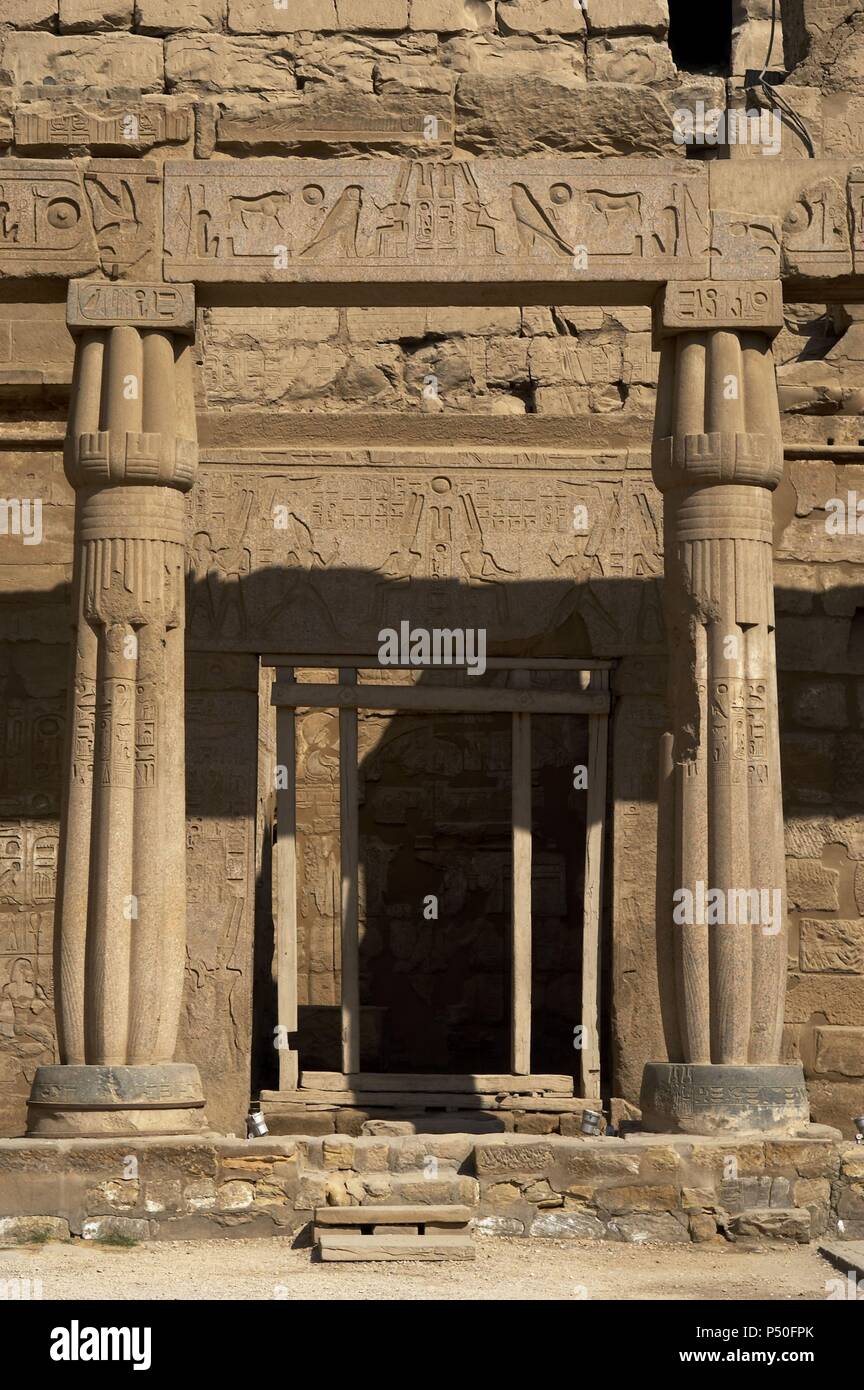 Luxor temple. Chapel dedicated to the Theban triad formed by the gods Amun, Mut and Khonsu. North side of the first court of Ramses II. New Empire. Egypt. Stock Photohttps://www.alamy.com/image-license-details/?v=1https://www.alamy.com/luxor-temple-chapel-dedicated-to-the-theban-triad-formed-by-the-gods-amun-mut-and-khonsu-north-side-of-the-first-court-of-ramses-ii-new-empire-egypt-image209610091.html
Luxor temple. Chapel dedicated to the Theban triad formed by the gods Amun, Mut and Khonsu. North side of the first court of Ramses II. New Empire. Egypt. Stock Photohttps://www.alamy.com/image-license-details/?v=1https://www.alamy.com/luxor-temple-chapel-dedicated-to-the-theban-triad-formed-by-the-gods-amun-mut-and-khonsu-north-side-of-the-first-court-of-ramses-ii-new-empire-egypt-image209610091.htmlRMP50FPK–Luxor temple. Chapel dedicated to the Theban triad formed by the gods Amun, Mut and Khonsu. North side of the first court of Ramses II. New Empire. Egypt.
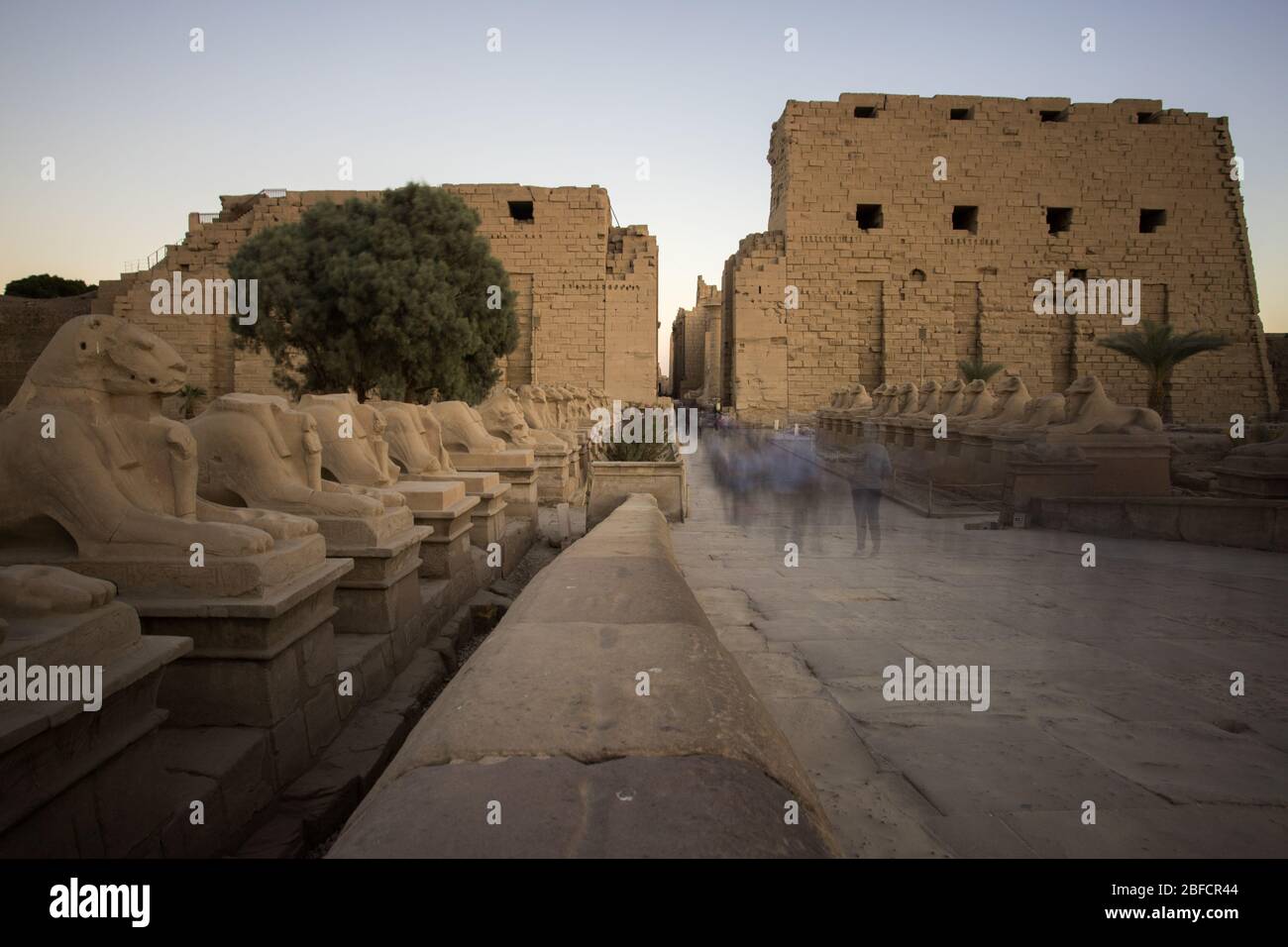 Tourists crowding the entrance of Karnak Temple and the Precinct of Amun-Re on the outskirts of Luxor, Egypt. Stock Photohttps://www.alamy.com/image-license-details/?v=1https://www.alamy.com/tourists-crowding-the-entrance-of-karnak-temple-and-the-precinct-of-amun-re-on-the-outskirts-of-luxor-egypt-image353708772.html
Tourists crowding the entrance of Karnak Temple and the Precinct of Amun-Re on the outskirts of Luxor, Egypt. Stock Photohttps://www.alamy.com/image-license-details/?v=1https://www.alamy.com/tourists-crowding-the-entrance-of-karnak-temple-and-the-precinct-of-amun-re-on-the-outskirts-of-luxor-egypt-image353708772.htmlRF2BFCR44–Tourists crowding the entrance of Karnak Temple and the Precinct of Amun-Re on the outskirts of Luxor, Egypt.
 This is the largest of the precincts of the temple complex, and is dedicated to Amun-Re, the chief deity of the Theban Triad. There are several coloss Stock Photohttps://www.alamy.com/image-license-details/?v=1https://www.alamy.com/this-is-the-largest-of-the-precincts-of-the-temple-complex-and-is-dedicated-to-amun-re-the-chief-deity-of-the-theban-triad-there-are-several-coloss-image384491878.html
This is the largest of the precincts of the temple complex, and is dedicated to Amun-Re, the chief deity of the Theban Triad. There are several coloss Stock Photohttps://www.alamy.com/image-license-details/?v=1https://www.alamy.com/this-is-the-largest-of-the-precincts-of-the-temple-complex-and-is-dedicated-to-amun-re-the-chief-deity-of-the-theban-triad-there-are-several-coloss-image384491878.htmlRM2D9F38P–This is the largest of the precincts of the temple complex, and is dedicated to Amun-Re, the chief deity of the Theban Triad. There are several coloss
 Karnak Temple Complex, in Luxor, Egypt. Construction at the complex began during the reign of Senusret I in the Middle Kingdom and continued into the Ptolemaic period, although most of the extant buildings date from the New Kingdom. The area around Karnak was the main place of worship of the eighteenth dynasty Theban Triad with the god Amun as its head. It is part of the monumental city of Thebes. Stock Photohttps://www.alamy.com/image-license-details/?v=1https://www.alamy.com/karnak-temple-complex-in-luxor-egypt-construction-at-the-complex-began-during-the-reign-of-senusret-i-in-the-middle-kingdom-and-continued-into-the-ptolemaic-period-although-most-of-the-extant-buildings-date-from-the-new-kingdom-the-area-around-karnak-was-the-main-place-of-worship-of-the-eighteenth-dynasty-theban-triad-with-the-god-amun-as-its-head-it-is-part-of-the-monumental-city-of-thebes-image328340280.html
Karnak Temple Complex, in Luxor, Egypt. Construction at the complex began during the reign of Senusret I in the Middle Kingdom and continued into the Ptolemaic period, although most of the extant buildings date from the New Kingdom. The area around Karnak was the main place of worship of the eighteenth dynasty Theban Triad with the god Amun as its head. It is part of the monumental city of Thebes. Stock Photohttps://www.alamy.com/image-license-details/?v=1https://www.alamy.com/karnak-temple-complex-in-luxor-egypt-construction-at-the-complex-began-during-the-reign-of-senusret-i-in-the-middle-kingdom-and-continued-into-the-ptolemaic-period-although-most-of-the-extant-buildings-date-from-the-new-kingdom-the-area-around-karnak-was-the-main-place-of-worship-of-the-eighteenth-dynasty-theban-triad-with-the-god-amun-as-its-head-it-is-part-of-the-monumental-city-of-thebes-image328340280.htmlRM2A255AG–Karnak Temple Complex, in Luxor, Egypt. Construction at the complex began during the reign of Senusret I in the Middle Kingdom and continued into the Ptolemaic period, although most of the extant buildings date from the New Kingdom. The area around Karnak was the main place of worship of the eighteenth dynasty Theban Triad with the god Amun as its head. It is part of the monumental city of Thebes.
 Chapel dedicated to the Theban triad. Luxor temple. Egypt. Stock Photohttps://www.alamy.com/image-license-details/?v=1https://www.alamy.com/stock-photo-chapel-dedicated-to-the-theban-triad-luxor-temple-egypt-27237042.html
Chapel dedicated to the Theban triad. Luxor temple. Egypt. Stock Photohttps://www.alamy.com/image-license-details/?v=1https://www.alamy.com/stock-photo-chapel-dedicated-to-the-theban-triad-luxor-temple-egypt-27237042.htmlRMBG8N3E–Chapel dedicated to the Theban triad. Luxor temple. Egypt.
 . Amun-Re, chief god of the Theban Triad. Relief from the Karnak temple complex. circa 1450BC. Anonymous 42 Amun-Ra Stock Photohttps://www.alamy.com/image-license-details/?v=1https://www.alamy.com/amun-re-chief-god-of-the-theban-triad-relief-from-the-karnak-temple-complex-circa-1450bc-anonymous-42-amun-ra-image187627590.html
. Amun-Re, chief god of the Theban Triad. Relief from the Karnak temple complex. circa 1450BC. Anonymous 42 Amun-Ra Stock Photohttps://www.alamy.com/image-license-details/?v=1https://www.alamy.com/amun-re-chief-god-of-the-theban-triad-relief-from-the-karnak-temple-complex-circa-1450bc-anonymous-42-amun-ra-image187627590.htmlRMMW74WA–. Amun-Re, chief god of the Theban Triad. Relief from the Karnak temple complex. circa 1450BC. Anonymous 42 Amun-Ra
 Cairo, Egypt - November 14 2023: Triad of Menkaure between Hathor and the Theban god displayed in the Egyptian Museum of Cairo near the Tahrir square. Stock Photohttps://www.alamy.com/image-license-details/?v=1https://www.alamy.com/cairo-egypt-november-14-2023-triad-of-menkaure-between-hathor-and-the-theban-god-displayed-in-the-egyptian-museum-of-cairo-near-the-tahrir-square-image593823857.html
Cairo, Egypt - November 14 2023: Triad of Menkaure between Hathor and the Theban god displayed in the Egyptian Museum of Cairo near the Tahrir square. Stock Photohttps://www.alamy.com/image-license-details/?v=1https://www.alamy.com/cairo-egypt-november-14-2023-triad-of-menkaure-between-hathor-and-the-theban-god-displayed-in-the-egyptian-museum-of-cairo-near-the-tahrir-square-image593823857.htmlRF2WE30AW–Cairo, Egypt - November 14 2023: Triad of Menkaure between Hathor and the Theban god displayed in the Egyptian Museum of Cairo near the Tahrir square.
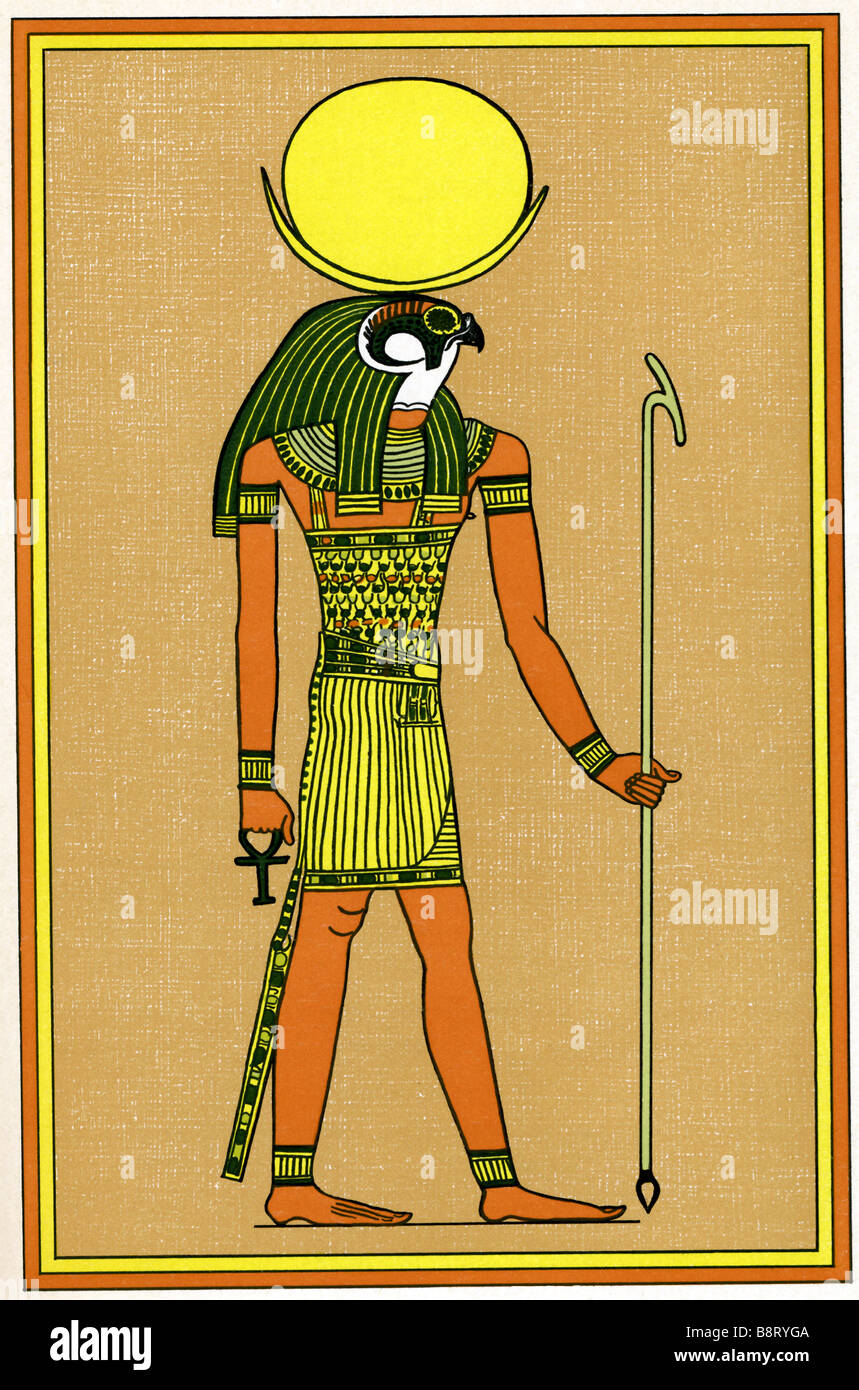 Egyptian God Khonsu, also known as Khensu Stock Photohttps://www.alamy.com/image-license-details/?v=1https://www.alamy.com/stock-photo-egyptian-god-khonsu-also-known-as-khensu-22654138.html
Egyptian God Khonsu, also known as Khensu Stock Photohttps://www.alamy.com/image-license-details/?v=1https://www.alamy.com/stock-photo-egyptian-god-khonsu-also-known-as-khensu-22654138.htmlRFB8RYGA–Egyptian God Khonsu, also known as Khensu
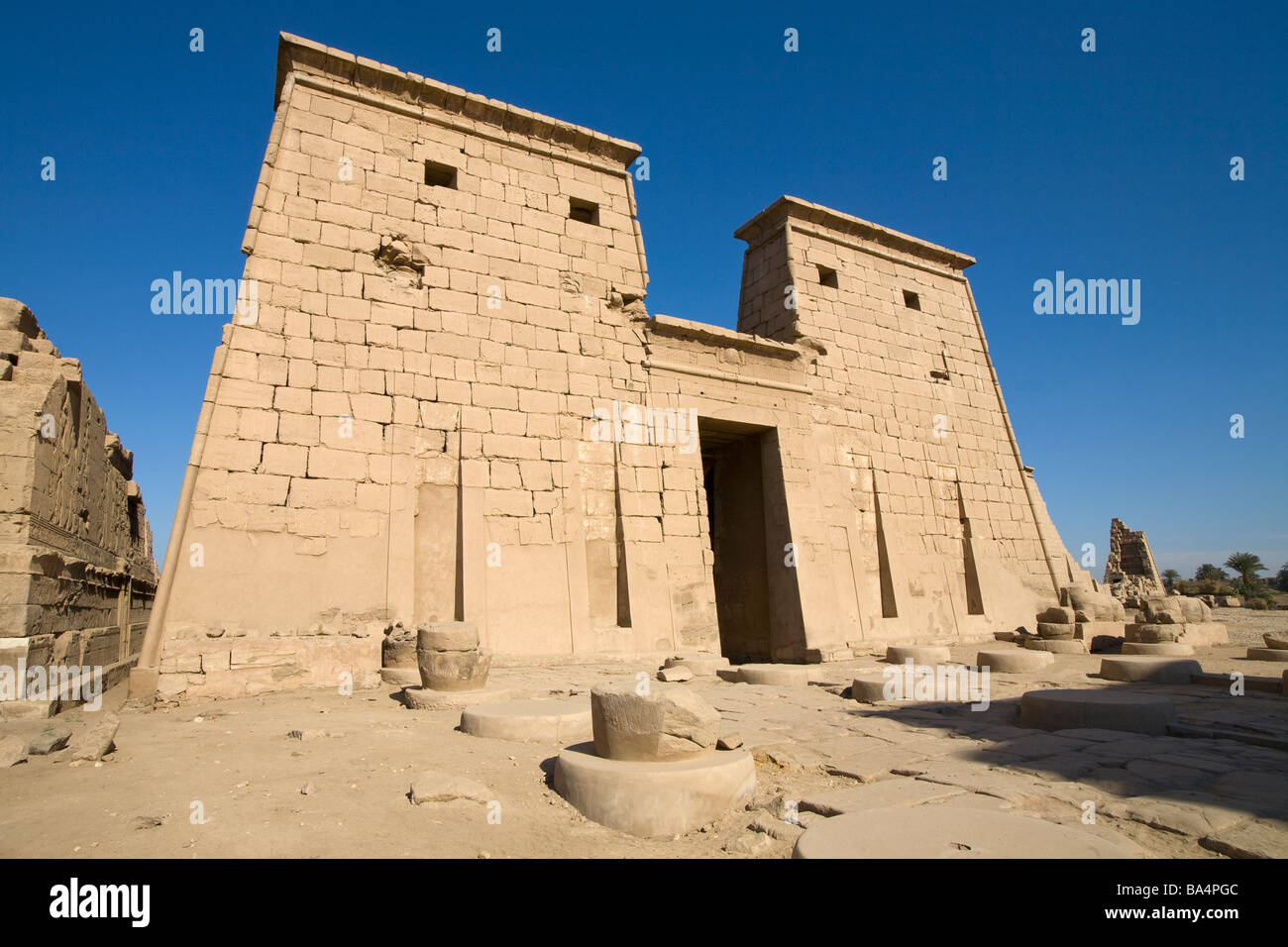 The first pylon of the Temple of Khonsu, Karnak Temple, Luxor, Egypt Stock Photohttps://www.alamy.com/image-license-details/?v=1https://www.alamy.com/stock-photo-the-first-pylon-of-the-temple-of-khonsu-karnak-temple-luxor-egypt-23462444.html
The first pylon of the Temple of Khonsu, Karnak Temple, Luxor, Egypt Stock Photohttps://www.alamy.com/image-license-details/?v=1https://www.alamy.com/stock-photo-the-first-pylon-of-the-temple-of-khonsu-karnak-temple-luxor-egypt-23462444.htmlRFBA4PGC–The first pylon of the Temple of Khonsu, Karnak Temple, Luxor, Egypt
 The Nile : notes for travellers in Egypt . Chonsu, was associated with Amen-Ra TEHUTI. CHONSU. and Mut in the Theban triad. He was the god of the moon,and is represented as hawk-headed and wearing the lunardisk and crescent. His second name was Nefer-hetep, andhe was worshipped with great honour at Thebes. Sebek, ^5, the crocodile-headed god, was worshippedat Kom-Ombos and in the Fayyum. I-em-hetep (Imouthis), li ^^^ ^, was the son of Ptah. ^ I 2 NOTES FOR TRAVELLERS IN EGYPT. ^ 0 ii6 Shu, K <2r^, and Tefnut, ^ r^j? ^^e^e the children of Seb and Nut, and represented sunHght and moisture Stock Photohttps://www.alamy.com/image-license-details/?v=1https://www.alamy.com/the-nile-notes-for-travellers-in-egypt-chonsu-was-associated-with-amen-ra-tehuti-chonsu-and-mut-in-the-theban-triad-he-was-the-god-of-the-moonand-is-represented-as-hawk-headed-and-wearing-the-lunardisk-and-crescent-his-second-name-was-nefer-hetep-andhe-was-worshipped-with-great-honour-at-thebes-sebek-5-the-crocodile-headed-god-was-worshippedat-kom-ombos-and-in-the-fayyum-i-em-hetep-imouthis-li-was-the-son-of-ptah-i-2-notes-for-travellers-in-egypt-0-ii6-shu-k-lt2r-and-tefnut-rj-ee-the-children-of-seb-and-nut-and-represented-sunhght-and-moisture-image338952622.html
The Nile : notes for travellers in Egypt . Chonsu, was associated with Amen-Ra TEHUTI. CHONSU. and Mut in the Theban triad. He was the god of the moon,and is represented as hawk-headed and wearing the lunardisk and crescent. His second name was Nefer-hetep, andhe was worshipped with great honour at Thebes. Sebek, ^5, the crocodile-headed god, was worshippedat Kom-Ombos and in the Fayyum. I-em-hetep (Imouthis), li ^^^ ^, was the son of Ptah. ^ I 2 NOTES FOR TRAVELLERS IN EGYPT. ^ 0 ii6 Shu, K <2r^, and Tefnut, ^ r^j? ^^e^e the children of Seb and Nut, and represented sunHght and moisture Stock Photohttps://www.alamy.com/image-license-details/?v=1https://www.alamy.com/the-nile-notes-for-travellers-in-egypt-chonsu-was-associated-with-amen-ra-tehuti-chonsu-and-mut-in-the-theban-triad-he-was-the-god-of-the-moonand-is-represented-as-hawk-headed-and-wearing-the-lunardisk-and-crescent-his-second-name-was-nefer-hetep-andhe-was-worshipped-with-great-honour-at-thebes-sebek-5-the-crocodile-headed-god-was-worshippedat-kom-ombos-and-in-the-fayyum-i-em-hetep-imouthis-li-was-the-son-of-ptah-i-2-notes-for-travellers-in-egypt-0-ii6-shu-k-lt2r-and-tefnut-rj-ee-the-children-of-seb-and-nut-and-represented-sunhght-and-moisture-image338952622.htmlRM2AKCHEP–The Nile : notes for travellers in Egypt . Chonsu, was associated with Amen-Ra TEHUTI. CHONSU. and Mut in the Theban triad. He was the god of the moon,and is represented as hawk-headed and wearing the lunardisk and crescent. His second name was Nefer-hetep, andhe was worshipped with great honour at Thebes. Sebek, ^5, the crocodile-headed god, was worshippedat Kom-Ombos and in the Fayyum. I-em-hetep (Imouthis), li ^^^ ^, was the son of Ptah. ^ I 2 NOTES FOR TRAVELLERS IN EGYPT. ^ 0 ii6 Shu, K <2r^, and Tefnut, ^ r^j? ^^e^e the children of Seb and Nut, and represented sunHght and moisture
 Ancient Egyptian. Statuette of the Theban Triad, Amun, Mut, and Khonsu. 1069 BC–332 BC. Egypt. Bronze and gold Stock Photohttps://www.alamy.com/image-license-details/?v=1https://www.alamy.com/ancient-egyptian-statuette-of-the-theban-triad-amun-mut-and-khonsu-1069-bc332-bc-egypt-bronze-and-gold-image337937787.html
Ancient Egyptian. Statuette of the Theban Triad, Amun, Mut, and Khonsu. 1069 BC–332 BC. Egypt. Bronze and gold Stock Photohttps://www.alamy.com/image-license-details/?v=1https://www.alamy.com/ancient-egyptian-statuette-of-the-theban-triad-amun-mut-and-khonsu-1069-bc332-bc-egypt-bronze-and-gold-image337937787.htmlRM2AHPB2K–Ancient Egyptian. Statuette of the Theban Triad, Amun, Mut, and Khonsu. 1069 BC–332 BC. Egypt. Bronze and gold
 Luxor, Egypt; January 16, 2024: Egyptian cartouche with the name of Alexander to the Theban triad Amun-Ra, Mut and Jonsu, and where he appears adorned Stock Photohttps://www.alamy.com/image-license-details/?v=1https://www.alamy.com/luxor-egypt-january-16-2024-egyptian-cartouche-with-the-name-of-alexander-to-the-theban-triad-amun-ra-mut-and-jonsu-and-where-he-appears-adorned-image619261187.html
Luxor, Egypt; January 16, 2024: Egyptian cartouche with the name of Alexander to the Theban triad Amun-Ra, Mut and Jonsu, and where he appears adorned Stock Photohttps://www.alamy.com/image-license-details/?v=1https://www.alamy.com/luxor-egypt-january-16-2024-egyptian-cartouche-with-the-name-of-alexander-to-the-theban-triad-amun-ra-mut-and-jonsu-and-where-he-appears-adorned-image619261187.htmlRF2XYDNXY–Luxor, Egypt; January 16, 2024: Egyptian cartouche with the name of Alexander to the Theban triad Amun-Ra, Mut and Jonsu, and where he appears adorned
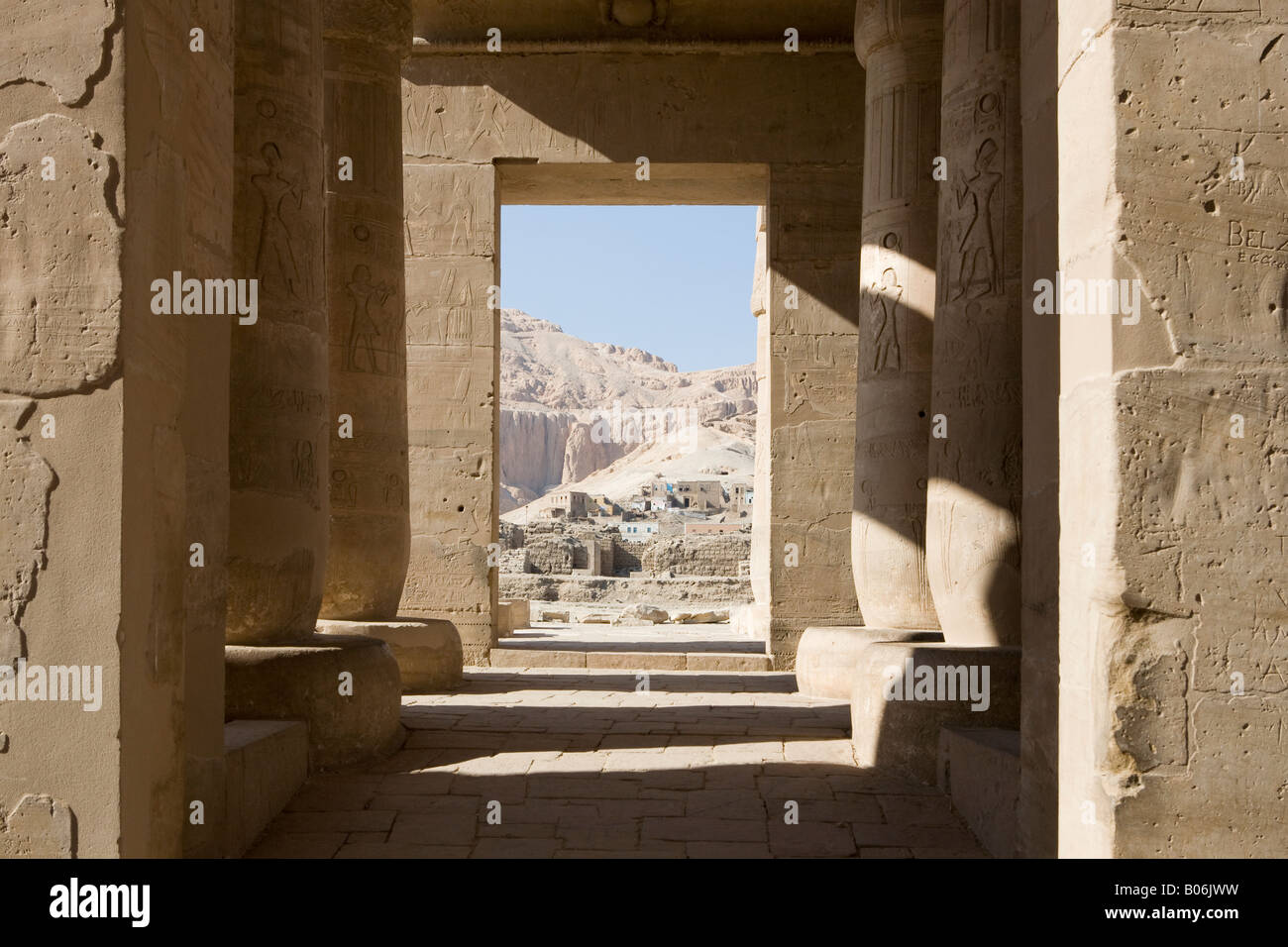 The Ramasseum, Mortuary Temple of Ramesses II on West Bank of the Nile at Luxor, Egypt, North Africa Stock Photohttps://www.alamy.com/image-license-details/?v=1https://www.alamy.com/stock-photo-the-ramasseum-mortuary-temple-of-ramesses-ii-on-west-bank-of-the-nile-17356917.html
The Ramasseum, Mortuary Temple of Ramesses II on West Bank of the Nile at Luxor, Egypt, North Africa Stock Photohttps://www.alamy.com/image-license-details/?v=1https://www.alamy.com/stock-photo-the-ramasseum-mortuary-temple-of-ramesses-ii-on-west-bank-of-the-nile-17356917.htmlRFB06JWW–The Ramasseum, Mortuary Temple of Ramesses II on West Bank of the Nile at Luxor, Egypt, North Africa
![Ramses IV(Ramses III) viene ad offrire i prigioni ad Amon-rê (Amon), Mut e Chons (Khonsu) (Soggetti rappresentati nel cortile di Medinet-Abu) Keywords: Medinet Habu (Egypt); Theban triad; Mut (Egyptian deity); Khonsu (Egyptian deity); Temples -- Egypt -- Medinet Habu.; Ramses IV[Ramses III] viene ad offrire i prigioni ad Amon-rê [Amon], Mut e Chons [Khonsu]. (Soggetti rappresentati nel cortile di Medinet-Abu). Stock Photo Ramses IV(Ramses III) viene ad offrire i prigioni ad Amon-rê (Amon), Mut e Chons (Khonsu) (Soggetti rappresentati nel cortile di Medinet-Abu) Keywords: Medinet Habu (Egypt); Theban triad; Mut (Egyptian deity); Khonsu (Egyptian deity); Temples -- Egypt -- Medinet Habu.; Ramses IV[Ramses III] viene ad offrire i prigioni ad Amon-rê [Amon], Mut e Chons [Khonsu]. (Soggetti rappresentati nel cortile di Medinet-Abu). Stock Photo](https://c8.alamy.com/comp/2AMB6GK/ramses-ivramses-iii-viene-ad-offrire-i-prigioni-ad-amon-re-amon-mut-e-chons-khonsu-soggetti-rappresentati-nel-cortile-di-medinet-abu-keywords-medinet-habu-egypt-theban-triad-mut-egyptian-deity-khonsu-egyptian-deity-temples-egypt-medinet-habu-ramses-iv-ramses-iii-viene-ad-offrire-i-prigioni-ad-amon-r-amon-mut-e-chons-khonsu-soggetti-rappresentati-nel-cortile-di-medinet-abu-2AMB6GK.jpg) Ramses IV(Ramses III) viene ad offrire i prigioni ad Amon-rê (Amon), Mut e Chons (Khonsu) (Soggetti rappresentati nel cortile di Medinet-Abu) Keywords: Medinet Habu (Egypt); Theban triad; Mut (Egyptian deity); Khonsu (Egyptian deity); Temples -- Egypt -- Medinet Habu.; Ramses IV[Ramses III] viene ad offrire i prigioni ad Amon-rê [Amon], Mut e Chons [Khonsu]. (Soggetti rappresentati nel cortile di Medinet-Abu). Stock Photohttps://www.alamy.com/image-license-details/?v=1https://www.alamy.com/ramses-ivramses-iii-viene-ad-offrire-i-prigioni-ad-amon-re-amon-mut-e-chons-khonsu-soggetti-rappresentati-nel-cortile-di-medinet-abu-keywords-medinet-habu-egypt-theban-triad-mut-egyptian-deity-khonsu-egyptian-deity-temples-egypt-medinet-habu-ramses-iv-ramses-iii-viene-ad-offrire-i-prigioni-ad-amon-r-amon-mut-e-chons-khonsu-soggetti-rappresentati-nel-cortile-di-medinet-abu-image339536755.html
Ramses IV(Ramses III) viene ad offrire i prigioni ad Amon-rê (Amon), Mut e Chons (Khonsu) (Soggetti rappresentati nel cortile di Medinet-Abu) Keywords: Medinet Habu (Egypt); Theban triad; Mut (Egyptian deity); Khonsu (Egyptian deity); Temples -- Egypt -- Medinet Habu.; Ramses IV[Ramses III] viene ad offrire i prigioni ad Amon-rê [Amon], Mut e Chons [Khonsu]. (Soggetti rappresentati nel cortile di Medinet-Abu). Stock Photohttps://www.alamy.com/image-license-details/?v=1https://www.alamy.com/ramses-ivramses-iii-viene-ad-offrire-i-prigioni-ad-amon-re-amon-mut-e-chons-khonsu-soggetti-rappresentati-nel-cortile-di-medinet-abu-keywords-medinet-habu-egypt-theban-triad-mut-egyptian-deity-khonsu-egyptian-deity-temples-egypt-medinet-habu-ramses-iv-ramses-iii-viene-ad-offrire-i-prigioni-ad-amon-r-amon-mut-e-chons-khonsu-soggetti-rappresentati-nel-cortile-di-medinet-abu-image339536755.htmlRM2AMB6GK–Ramses IV(Ramses III) viene ad offrire i prigioni ad Amon-rê (Amon), Mut e Chons (Khonsu) (Soggetti rappresentati nel cortile di Medinet-Abu) Keywords: Medinet Habu (Egypt); Theban triad; Mut (Egyptian deity); Khonsu (Egyptian deity); Temples -- Egypt -- Medinet Habu.; Ramses IV[Ramses III] viene ad offrire i prigioni ad Amon-rê [Amon], Mut e Chons [Khonsu]. (Soggetti rappresentati nel cortile di Medinet-Abu).
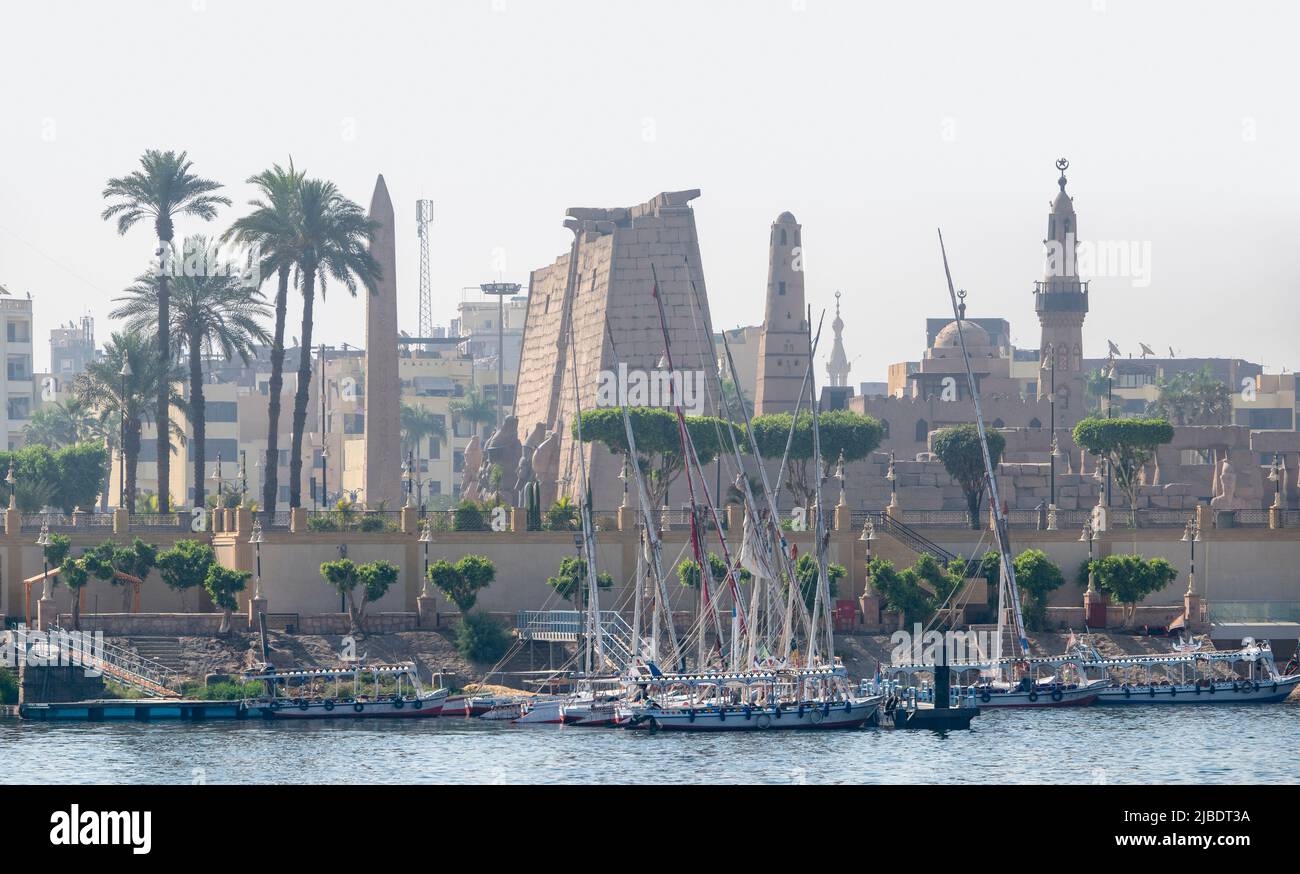 View of Luxor Temple, and Luxor Corniche, taken from the River Nile Stock Photohttps://www.alamy.com/image-license-details/?v=1https://www.alamy.com/view-of-luxor-temple-and-luxor-corniche-taken-from-the-river-nile-image471745438.html
View of Luxor Temple, and Luxor Corniche, taken from the River Nile Stock Photohttps://www.alamy.com/image-license-details/?v=1https://www.alamy.com/view-of-luxor-temple-and-luxor-corniche-taken-from-the-river-nile-image471745438.htmlRF2JBDT3A–View of Luxor Temple, and Luxor Corniche, taken from the River Nile
 Statuette of the Theban Triad, Amun, Mut, and Khonsu, Egypt, Third Intermediate Period-Late Period, Dynasty 21-31 (about 1069-332 BCE). Stock Photohttps://www.alamy.com/image-license-details/?v=1https://www.alamy.com/statuette-of-the-theban-triad-amun-mut-and-khonsu-egypt-third-intermediate-period-late-period-dynasty-21-31-about-1069-332-bce-image449088240.html
Statuette of the Theban Triad, Amun, Mut, and Khonsu, Egypt, Third Intermediate Period-Late Period, Dynasty 21-31 (about 1069-332 BCE). Stock Photohttps://www.alamy.com/image-license-details/?v=1https://www.alamy.com/statuette-of-the-theban-triad-amun-mut-and-khonsu-egypt-third-intermediate-period-late-period-dynasty-21-31-about-1069-332-bce-image449088240.htmlRM2H2HMHM–Statuette of the Theban Triad, Amun, Mut, and Khonsu, Egypt, Third Intermediate Period-Late Period, Dynasty 21-31 (about 1069-332 BCE).
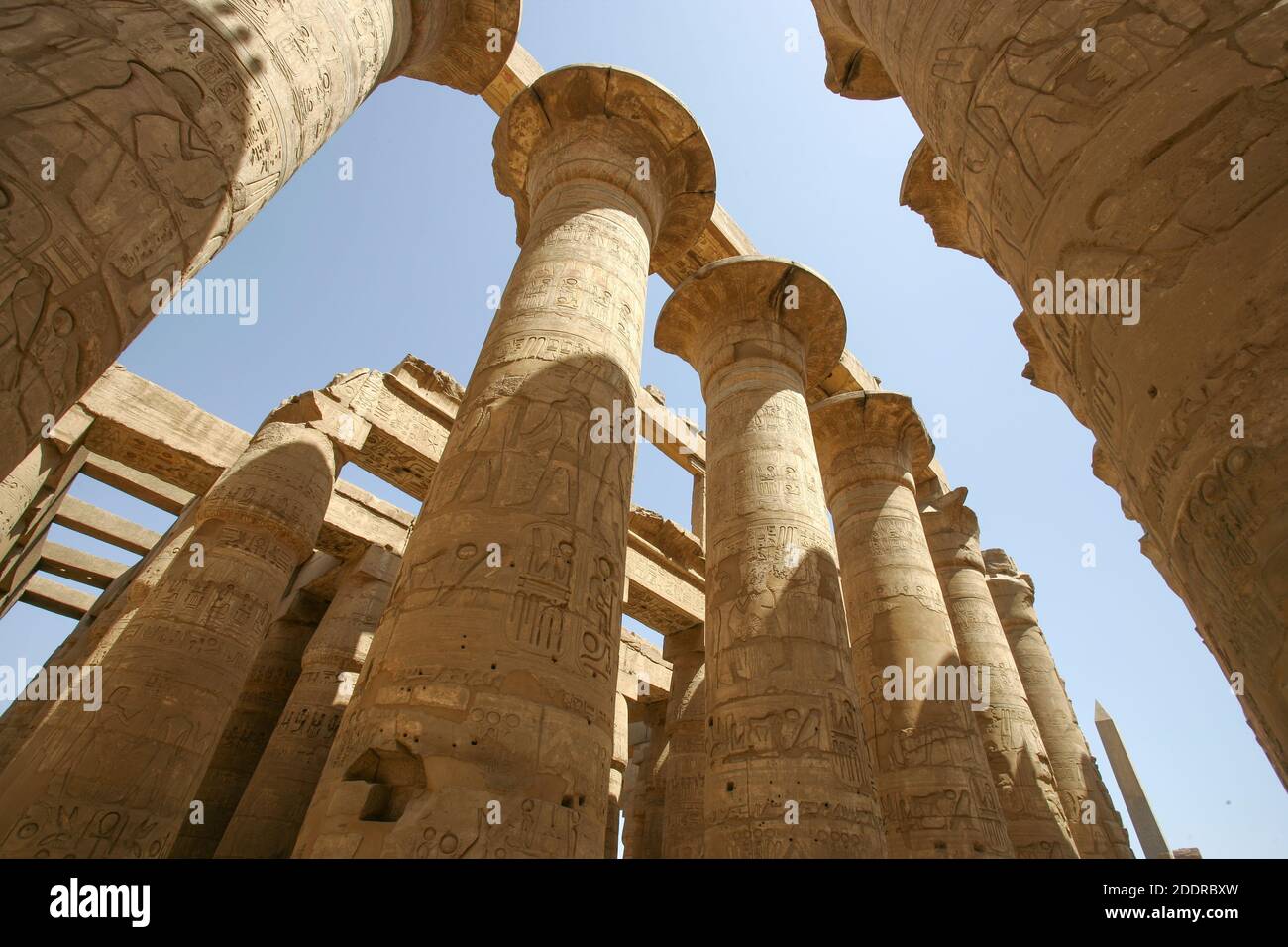 KARNAK TEMPLES IN EGYPT Stock Photohttps://www.alamy.com/image-license-details/?v=1https://www.alamy.com/karnak-temples-in-egypt-image387132897.html
KARNAK TEMPLES IN EGYPT Stock Photohttps://www.alamy.com/image-license-details/?v=1https://www.alamy.com/karnak-temples-in-egypt-image387132897.htmlRF2DDRBXW–KARNAK TEMPLES IN EGYPT
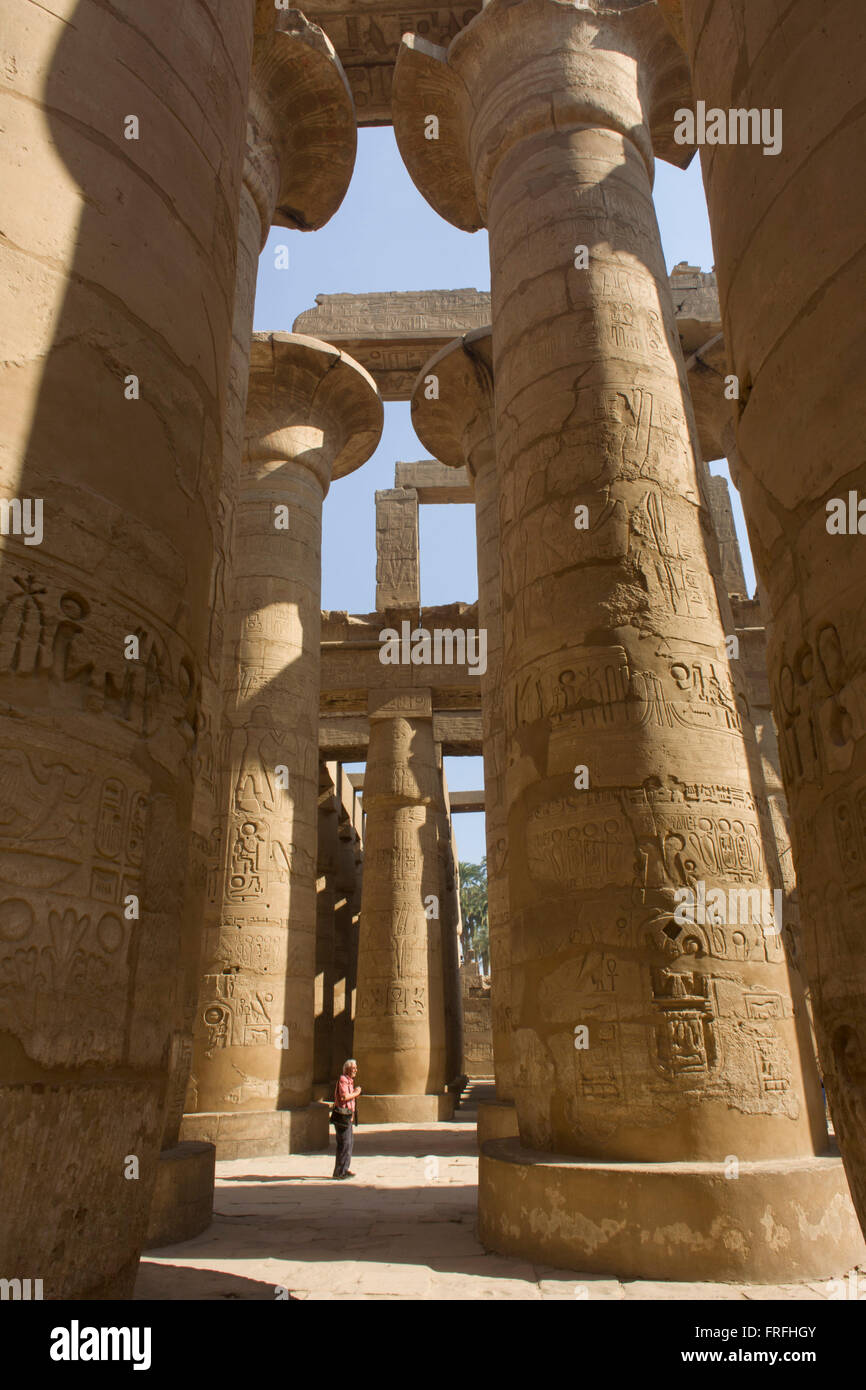 The tall columns in the Hypostyle hall at the Temple of Amun at Karnak, Luxor, Nile Valley, Egypt. The Karnak Temple Complex is the largest religious building ever made, covering about 200 acres. It comprises a vast mix of decayed temples, chapels, pylons, and other buildings built over 2,000 years and dedicated to the Theban triad of Amun, Mut, and Khonsu. The Hypostyle hall, at 54,000 square feet (16,459 meters) and featuring 134 columns, is still the largest room of any religious building in the world. Stock Photohttps://www.alamy.com/image-license-details/?v=1https://www.alamy.com/stock-photo-the-tall-columns-in-the-hypostyle-hall-at-the-temple-of-amun-at-karnak-100532011.html
The tall columns in the Hypostyle hall at the Temple of Amun at Karnak, Luxor, Nile Valley, Egypt. The Karnak Temple Complex is the largest religious building ever made, covering about 200 acres. It comprises a vast mix of decayed temples, chapels, pylons, and other buildings built over 2,000 years and dedicated to the Theban triad of Amun, Mut, and Khonsu. The Hypostyle hall, at 54,000 square feet (16,459 meters) and featuring 134 columns, is still the largest room of any religious building in the world. Stock Photohttps://www.alamy.com/image-license-details/?v=1https://www.alamy.com/stock-photo-the-tall-columns-in-the-hypostyle-hall-at-the-temple-of-amun-at-karnak-100532011.htmlRMFRFHGY–The tall columns in the Hypostyle hall at the Temple of Amun at Karnak, Luxor, Nile Valley, Egypt. The Karnak Temple Complex is the largest religious building ever made, covering about 200 acres. It comprises a vast mix of decayed temples, chapels, pylons, and other buildings built over 2,000 years and dedicated to the Theban triad of Amun, Mut, and Khonsu. The Hypostyle hall, at 54,000 square feet (16,459 meters) and featuring 134 columns, is still the largest room of any religious building in the world.
 Block Statue of Nedjem ca. 1184–1153 B.C. New Kingdom, Ramesside Nedjem held the office of 'god's Father' in the mortuary temple of King Merneptah during the reign of Ramesses III; the cartouches of both rulers are inscribed on his shoulders. His statue bears inscriptions on all four sides; the front panel contians an offering prayer addressed to the Theban triad of Amun, Mut and Khonsu. Depictions of Nedjem's wife and son appear on the right and left sides respectively. Nedjem dedicated this statue in the Eleventh Dynasty temple of Mentuhotpe II at Deir el Bahri so that he might partake of th Stock Photohttps://www.alamy.com/image-license-details/?v=1https://www.alamy.com/block-statue-of-nedjem-ca-11841153-bc-new-kingdom-ramesside-nedjem-held-the-office-of-gods-father-in-the-mortuary-temple-of-king-merneptah-during-the-reign-of-ramesses-iii-the-cartouches-of-both-rulers-are-inscribed-on-his-shoulders-his-statue-bears-inscriptions-on-all-four-sides-the-front-panel-contians-an-offering-prayer-addressed-to-the-theban-triad-of-amun-mut-and-khonsu-depictions-of-nedjems-wife-and-son-appear-on-the-right-and-left-sides-respectively-nedjem-dedicated-this-statue-in-the-eleventh-dynasty-temple-of-mentuhotpe-ii-at-deir-el-bahri-so-that-he-might-partake-of-th-image457771449.html
Block Statue of Nedjem ca. 1184–1153 B.C. New Kingdom, Ramesside Nedjem held the office of 'god's Father' in the mortuary temple of King Merneptah during the reign of Ramesses III; the cartouches of both rulers are inscribed on his shoulders. His statue bears inscriptions on all four sides; the front panel contians an offering prayer addressed to the Theban triad of Amun, Mut and Khonsu. Depictions of Nedjem's wife and son appear on the right and left sides respectively. Nedjem dedicated this statue in the Eleventh Dynasty temple of Mentuhotpe II at Deir el Bahri so that he might partake of th Stock Photohttps://www.alamy.com/image-license-details/?v=1https://www.alamy.com/block-statue-of-nedjem-ca-11841153-bc-new-kingdom-ramesside-nedjem-held-the-office-of-gods-father-in-the-mortuary-temple-of-king-merneptah-during-the-reign-of-ramesses-iii-the-cartouches-of-both-rulers-are-inscribed-on-his-shoulders-his-statue-bears-inscriptions-on-all-four-sides-the-front-panel-contians-an-offering-prayer-addressed-to-the-theban-triad-of-amun-mut-and-khonsu-depictions-of-nedjems-wife-and-son-appear-on-the-right-and-left-sides-respectively-nedjem-dedicated-this-statue-in-the-eleventh-dynasty-temple-of-mentuhotpe-ii-at-deir-el-bahri-so-that-he-might-partake-of-th-image457771449.htmlRM2HGN849–Block Statue of Nedjem ca. 1184–1153 B.C. New Kingdom, Ramesside Nedjem held the office of 'god's Father' in the mortuary temple of King Merneptah during the reign of Ramesses III; the cartouches of both rulers are inscribed on his shoulders. His statue bears inscriptions on all four sides; the front panel contians an offering prayer addressed to the Theban triad of Amun, Mut and Khonsu. Depictions of Nedjem's wife and son appear on the right and left sides respectively. Nedjem dedicated this statue in the Eleventh Dynasty temple of Mentuhotpe II at Deir el Bahri so that he might partake of th
 Khonsu. Dimensions: H. 11.3 cm (4 7/6 in.); W. 2.9 cm (1 1/8 in.); D. 2 cm (13/16 in.). Date: 664-30 B.C.. This figure represents a child deity standing and holding a scepter. The moon disk, sidelock, and close-fitting mummiform garment identifies him as Khonsu the Child, the son of the deities Amun and Mut, who together formed the great Theban triad. The sidelock worn just below the moon disk marks him as a child god. Child gods grew to great prominence in the first millennium BC, and many statuettes of such gods were produced beginning in the Third Intermediate Period through the Ptolemaic Stock Photohttps://www.alamy.com/image-license-details/?v=1https://www.alamy.com/khonsu-dimensions-h-113-cm-4-76-in-w-29-cm-1-18-in-d-2-cm-1316-in-date-664-30-bc-this-figure-represents-a-child-deity-standing-and-holding-a-scepter-the-moon-disk-sidelock-and-close-fitting-mummiform-garment-identifies-him-as-khonsu-the-child-the-son-of-the-deities-amun-and-mut-who-together-formed-the-great-theban-triad-the-sidelock-worn-just-below-the-moon-disk-marks-him-as-a-child-god-child-gods-grew-to-great-prominence-in-the-first-millennium-bc-and-many-statuettes-of-such-gods-were-produced-beginning-in-the-third-intermediate-period-through-the-ptolemaic-image213371798.html
Khonsu. Dimensions: H. 11.3 cm (4 7/6 in.); W. 2.9 cm (1 1/8 in.); D. 2 cm (13/16 in.). Date: 664-30 B.C.. This figure represents a child deity standing and holding a scepter. The moon disk, sidelock, and close-fitting mummiform garment identifies him as Khonsu the Child, the son of the deities Amun and Mut, who together formed the great Theban triad. The sidelock worn just below the moon disk marks him as a child god. Child gods grew to great prominence in the first millennium BC, and many statuettes of such gods were produced beginning in the Third Intermediate Period through the Ptolemaic Stock Photohttps://www.alamy.com/image-license-details/?v=1https://www.alamy.com/khonsu-dimensions-h-113-cm-4-76-in-w-29-cm-1-18-in-d-2-cm-1316-in-date-664-30-bc-this-figure-represents-a-child-deity-standing-and-holding-a-scepter-the-moon-disk-sidelock-and-close-fitting-mummiform-garment-identifies-him-as-khonsu-the-child-the-son-of-the-deities-amun-and-mut-who-together-formed-the-great-theban-triad-the-sidelock-worn-just-below-the-moon-disk-marks-him-as-a-child-god-child-gods-grew-to-great-prominence-in-the-first-millennium-bc-and-many-statuettes-of-such-gods-were-produced-beginning-in-the-third-intermediate-period-through-the-ptolemaic-image213371798.htmlRMPB3WWA–Khonsu. Dimensions: H. 11.3 cm (4 7/6 in.); W. 2.9 cm (1 1/8 in.); D. 2 cm (13/16 in.). Date: 664-30 B.C.. This figure represents a child deity standing and holding a scepter. The moon disk, sidelock, and close-fitting mummiform garment identifies him as Khonsu the Child, the son of the deities Amun and Mut, who together formed the great Theban triad. The sidelock worn just below the moon disk marks him as a child god. Child gods grew to great prominence in the first millennium BC, and many statuettes of such gods were produced beginning in the Third Intermediate Period through the Ptolemaic
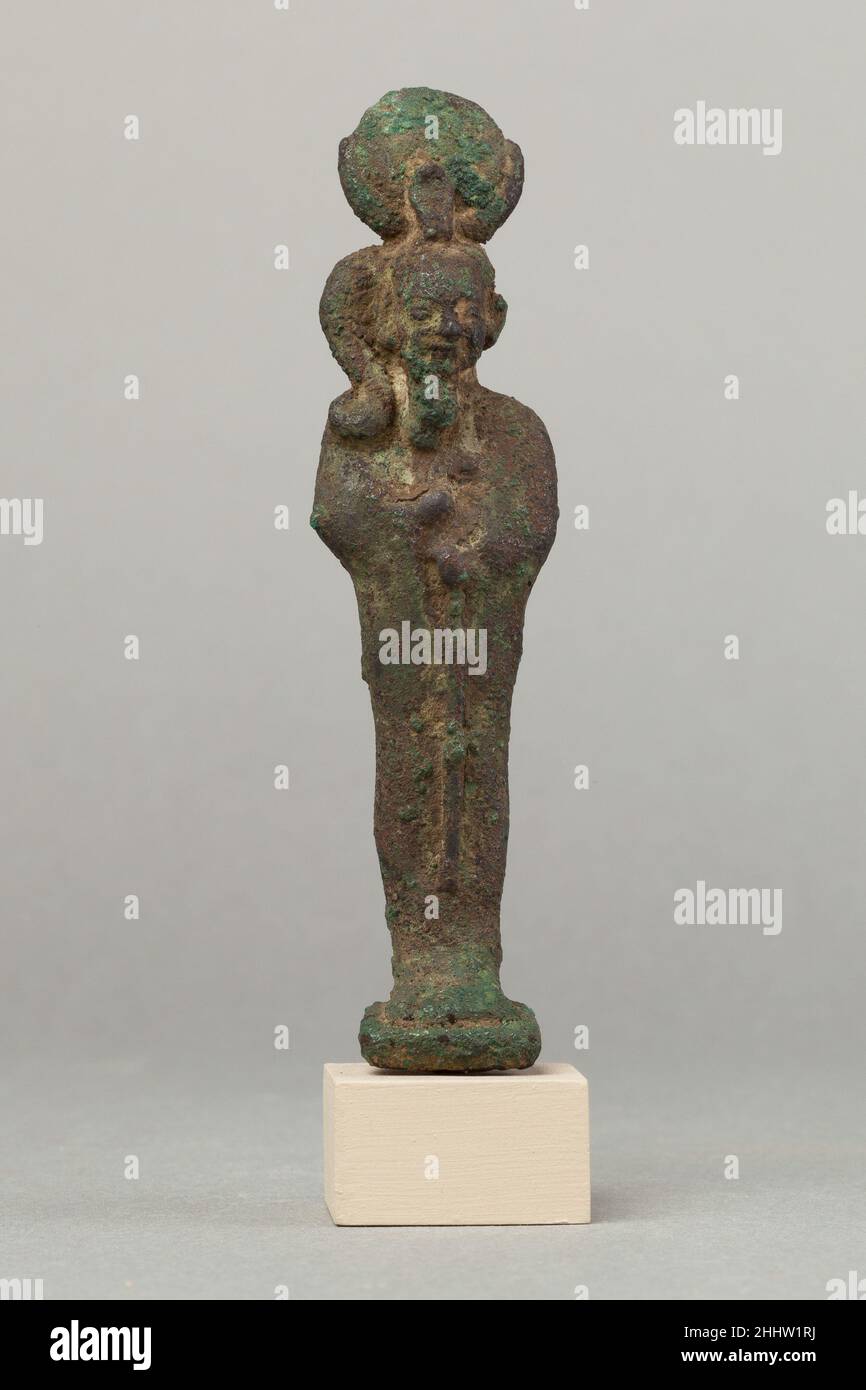 Khonsu 664–30 B.C. Late Period–Ptolemaic Period This figure represents a child deity standing and holding a scepter. The moon disk, sidelock, and close-fitting mummiform garment identifies him as Khonsu the Child, the son of the deities Amun and Mut, who together formed the great Theban triad. The sidelock worn just below the moon disk marks him as a child god. Child gods grew to great prominence in the first millennium BC, and many statuettes of such gods were produced beginning in the Third Intermediate Period through the Ptolemaic Period. After Horus the Child (Harpokrates), the son of Isis Stock Photohttps://www.alamy.com/image-license-details/?v=1https://www.alamy.com/khonsu-66430-bc-late-periodptolemaic-period-this-figure-represents-a-child-deity-standing-and-holding-a-scepter-the-moon-disk-sidelock-and-close-fitting-mummiform-garment-identifies-him-as-khonsu-the-child-the-son-of-the-deities-amun-and-mut-who-together-formed-the-great-theban-triad-the-sidelock-worn-just-below-the-moon-disk-marks-him-as-a-child-god-child-gods-grew-to-great-prominence-in-the-first-millennium-bc-and-many-statuettes-of-such-gods-were-produced-beginning-in-the-third-intermediate-period-through-the-ptolemaic-period-after-horus-the-child-harpokrates-the-son-of-isis-image458468966.html
Khonsu 664–30 B.C. Late Period–Ptolemaic Period This figure represents a child deity standing and holding a scepter. The moon disk, sidelock, and close-fitting mummiform garment identifies him as Khonsu the Child, the son of the deities Amun and Mut, who together formed the great Theban triad. The sidelock worn just below the moon disk marks him as a child god. Child gods grew to great prominence in the first millennium BC, and many statuettes of such gods were produced beginning in the Third Intermediate Period through the Ptolemaic Period. After Horus the Child (Harpokrates), the son of Isis Stock Photohttps://www.alamy.com/image-license-details/?v=1https://www.alamy.com/khonsu-66430-bc-late-periodptolemaic-period-this-figure-represents-a-child-deity-standing-and-holding-a-scepter-the-moon-disk-sidelock-and-close-fitting-mummiform-garment-identifies-him-as-khonsu-the-child-the-son-of-the-deities-amun-and-mut-who-together-formed-the-great-theban-triad-the-sidelock-worn-just-below-the-moon-disk-marks-him-as-a-child-god-child-gods-grew-to-great-prominence-in-the-first-millennium-bc-and-many-statuettes-of-such-gods-were-produced-beginning-in-the-third-intermediate-period-through-the-ptolemaic-period-after-horus-the-child-harpokrates-the-son-of-isis-image458468966.htmlRM2HHW1RJ–Khonsu 664–30 B.C. Late Period–Ptolemaic Period This figure represents a child deity standing and holding a scepter. The moon disk, sidelock, and close-fitting mummiform garment identifies him as Khonsu the Child, the son of the deities Amun and Mut, who together formed the great Theban triad. The sidelock worn just below the moon disk marks him as a child god. Child gods grew to great prominence in the first millennium BC, and many statuettes of such gods were produced beginning in the Third Intermediate Period through the Ptolemaic Period. After Horus the Child (Harpokrates), the son of Isis
 This is the largest of the precincts of the temple complex, and is dedicated to Amun-Re, the chief deity of the Theban Triad. There are several coloss Stock Photohttps://www.alamy.com/image-license-details/?v=1https://www.alamy.com/this-is-the-largest-of-the-precincts-of-the-temple-complex-and-is-dedicated-to-amun-re-the-chief-deity-of-the-theban-triad-there-are-several-coloss-image384491880.html
This is the largest of the precincts of the temple complex, and is dedicated to Amun-Re, the chief deity of the Theban Triad. There are several coloss Stock Photohttps://www.alamy.com/image-license-details/?v=1https://www.alamy.com/this-is-the-largest-of-the-precincts-of-the-temple-complex-and-is-dedicated-to-amun-re-the-chief-deity-of-the-theban-triad-there-are-several-coloss-image384491880.htmlRM2D9F38T–This is the largest of the precincts of the temple complex, and is dedicated to Amun-Re, the chief deity of the Theban Triad. There are several coloss
 Karnak Temple Complex, in Luxor, Egypt. Construction at the complex began during the reign of Senusret I in the Middle Kingdom and continued into the Ptolemaic period, although most of the extant buildings date from the New Kingdom. The area around Karnak was the main place of worship of the eighteenth dynasty Theban Triad with the god Amun as its head. It is part of the monumental city of Thebes. Stock Photohttps://www.alamy.com/image-license-details/?v=1https://www.alamy.com/karnak-temple-complex-in-luxor-egypt-construction-at-the-complex-began-during-the-reign-of-senusret-i-in-the-middle-kingdom-and-continued-into-the-ptolemaic-period-although-most-of-the-extant-buildings-date-from-the-new-kingdom-the-area-around-karnak-was-the-main-place-of-worship-of-the-eighteenth-dynasty-theban-triad-with-the-god-amun-as-its-head-it-is-part-of-the-monumental-city-of-thebes-image328340260.html
Karnak Temple Complex, in Luxor, Egypt. Construction at the complex began during the reign of Senusret I in the Middle Kingdom and continued into the Ptolemaic period, although most of the extant buildings date from the New Kingdom. The area around Karnak was the main place of worship of the eighteenth dynasty Theban Triad with the god Amun as its head. It is part of the monumental city of Thebes. Stock Photohttps://www.alamy.com/image-license-details/?v=1https://www.alamy.com/karnak-temple-complex-in-luxor-egypt-construction-at-the-complex-began-during-the-reign-of-senusret-i-in-the-middle-kingdom-and-continued-into-the-ptolemaic-period-although-most-of-the-extant-buildings-date-from-the-new-kingdom-the-area-around-karnak-was-the-main-place-of-worship-of-the-eighteenth-dynasty-theban-triad-with-the-god-amun-as-its-head-it-is-part-of-the-monumental-city-of-thebes-image328340260.htmlRM2A2559T–Karnak Temple Complex, in Luxor, Egypt. Construction at the complex began during the reign of Senusret I in the Middle Kingdom and continued into the Ptolemaic period, although most of the extant buildings date from the New Kingdom. The area around Karnak was the main place of worship of the eighteenth dynasty Theban Triad with the god Amun as its head. It is part of the monumental city of Thebes.
 Relief depicting god Amun with great helmet covered with two large feathers and beard sitting on the throne. Luxor. Stock Photohttps://www.alamy.com/image-license-details/?v=1https://www.alamy.com/stock-photo-relief-depicting-god-amun-with-great-helmet-covered-with-two-large-27234793.html
Relief depicting god Amun with great helmet covered with two large feathers and beard sitting on the throne. Luxor. Stock Photohttps://www.alamy.com/image-license-details/?v=1https://www.alamy.com/stock-photo-relief-depicting-god-amun-with-great-helmet-covered-with-two-large-27234793.htmlRMBG8J75–Relief depicting god Amun with great helmet covered with two large feathers and beard sitting on the throne. Luxor.
 . Amun-Re, chief god of the Theban Triad. Relief from the Karnak temple complex. circa 1450BC. Anonymous 37 Amun-Ra Stock Photohttps://www.alamy.com/image-license-details/?v=1https://www.alamy.com/amun-re-chief-god-of-the-theban-triad-relief-from-the-karnak-temple-complex-circa-1450bc-anonymous-37-amun-ra-image188905538.html
. Amun-Re, chief god of the Theban Triad. Relief from the Karnak temple complex. circa 1450BC. Anonymous 37 Amun-Ra Stock Photohttps://www.alamy.com/image-license-details/?v=1https://www.alamy.com/amun-re-chief-god-of-the-theban-triad-relief-from-the-karnak-temple-complex-circa-1450bc-anonymous-37-amun-ra-image188905538.htmlRMMY9AXA–. Amun-Re, chief god of the Theban Triad. Relief from the Karnak temple complex. circa 1450BC. Anonymous 37 Amun-Ra
 Cairo, Egypt - November 14 2023: Triad of Menkaure between Hathor and the Theban god displayed in the Egyptian Museum of Cairo near the Tahrir square. Stock Photohttps://www.alamy.com/image-license-details/?v=1https://www.alamy.com/cairo-egypt-november-14-2023-triad-of-menkaure-between-hathor-and-the-theban-god-displayed-in-the-egyptian-museum-of-cairo-near-the-tahrir-square-image593823947.html
Cairo, Egypt - November 14 2023: Triad of Menkaure between Hathor and the Theban god displayed in the Egyptian Museum of Cairo near the Tahrir square. Stock Photohttps://www.alamy.com/image-license-details/?v=1https://www.alamy.com/cairo-egypt-november-14-2023-triad-of-menkaure-between-hathor-and-the-theban-god-displayed-in-the-egyptian-museum-of-cairo-near-the-tahrir-square-image593823947.htmlRF2WE30E3–Cairo, Egypt - November 14 2023: Triad of Menkaure between Hathor and the Theban god displayed in the Egyptian Museum of Cairo near the Tahrir square.
![Fig 1 Offerte di Menphtah II (Merneptah) figlio e successore di Ramses III (II), alle deità di Silsilis Fig 2 Offerta del medesimo ad Atmu, Mandu, e Amenôf I, capo della dinastia XVIII Keywords: Theban triad; Mut (Egyptian deity); Khonsu (Egyptian deity); Montu (Egyptian deity); Hapy-Nile; Haroeris; Gebel el-Silsila.; Fig. 1. Offerte di Menphtah II [Merneptah] figlio e successore di Ramses III [II], alle deità di Silsilis. Fig. 2. Offerta del medesimo ad Atmu, Mandu, e Amenôf I, capo della dinastia XVIII. Fig. 3. Due immagini simboliche del Nilo vengono a recar doni Stock Photo Fig 1 Offerte di Menphtah II (Merneptah) figlio e successore di Ramses III (II), alle deità di Silsilis Fig 2 Offerta del medesimo ad Atmu, Mandu, e Amenôf I, capo della dinastia XVIII Keywords: Theban triad; Mut (Egyptian deity); Khonsu (Egyptian deity); Montu (Egyptian deity); Hapy-Nile; Haroeris; Gebel el-Silsila.; Fig. 1. Offerte di Menphtah II [Merneptah] figlio e successore di Ramses III [II], alle deità di Silsilis. Fig. 2. Offerta del medesimo ad Atmu, Mandu, e Amenôf I, capo della dinastia XVIII. Fig. 3. Due immagini simboliche del Nilo vengono a recar doni Stock Photo](https://c8.alamy.com/comp/2AAXMDC/fig-1-offerte-di-menphtah-ii-merneptah-figlio-e-successore-di-ramses-iii-ii-alle-deita-di-silsilis-fig-2-offerta-del-medesimo-ad-atmu-mandu-e-amenof-i-capo-della-dinastia-xviii-keywords-theban-triad-mut-egyptian-deity-khonsu-egyptian-deity-montu-egyptian-deity-hapy-nile-haroeris-gebel-el-silsila-fig-1-offerte-di-menphtah-ii-merneptah-figlio-e-successore-di-ramses-iii-ii-alle-deit-di-silsilis-fig-2-offerta-del-medesimo-ad-atmu-mandu-e-amenf-i-capo-della-dinastia-xviii-fig-3-due-immagini-simboliche-del-nilo-vengono-a-recar-doni-2AAXMDC.jpg) Fig 1 Offerte di Menphtah II (Merneptah) figlio e successore di Ramses III (II), alle deità di Silsilis Fig 2 Offerta del medesimo ad Atmu, Mandu, e Amenôf I, capo della dinastia XVIII Keywords: Theban triad; Mut (Egyptian deity); Khonsu (Egyptian deity); Montu (Egyptian deity); Hapy-Nile; Haroeris; Gebel el-Silsila.; Fig. 1. Offerte di Menphtah II [Merneptah] figlio e successore di Ramses III [II], alle deità di Silsilis. Fig. 2. Offerta del medesimo ad Atmu, Mandu, e Amenôf I, capo della dinastia XVIII. Fig. 3. Due immagini simboliche del Nilo vengono a recar doni Stock Photohttps://www.alamy.com/image-license-details/?v=1https://www.alamy.com/fig-1-offerte-di-menphtah-ii-merneptah-figlio-e-successore-di-ramses-iii-ii-alle-deita-di-silsilis-fig-2-offerta-del-medesimo-ad-atmu-mandu-e-amenof-i-capo-della-dinastia-xviii-keywords-theban-triad-mut-egyptian-deity-khonsu-egyptian-deity-montu-egyptian-deity-hapy-nile-haroeris-gebel-el-silsila-fig-1-offerte-di-menphtah-ii-merneptah-figlio-e-successore-di-ramses-iii-ii-alle-deit-di-silsilis-fig-2-offerta-del-medesimo-ad-atmu-mandu-e-amenf-i-capo-della-dinastia-xviii-fig-3-due-immagini-simboliche-del-nilo-vengono-a-recar-doni-image333730360.html
Fig 1 Offerte di Menphtah II (Merneptah) figlio e successore di Ramses III (II), alle deità di Silsilis Fig 2 Offerta del medesimo ad Atmu, Mandu, e Amenôf I, capo della dinastia XVIII Keywords: Theban triad; Mut (Egyptian deity); Khonsu (Egyptian deity); Montu (Egyptian deity); Hapy-Nile; Haroeris; Gebel el-Silsila.; Fig. 1. Offerte di Menphtah II [Merneptah] figlio e successore di Ramses III [II], alle deità di Silsilis. Fig. 2. Offerta del medesimo ad Atmu, Mandu, e Amenôf I, capo della dinastia XVIII. Fig. 3. Due immagini simboliche del Nilo vengono a recar doni Stock Photohttps://www.alamy.com/image-license-details/?v=1https://www.alamy.com/fig-1-offerte-di-menphtah-ii-merneptah-figlio-e-successore-di-ramses-iii-ii-alle-deita-di-silsilis-fig-2-offerta-del-medesimo-ad-atmu-mandu-e-amenof-i-capo-della-dinastia-xviii-keywords-theban-triad-mut-egyptian-deity-khonsu-egyptian-deity-montu-egyptian-deity-hapy-nile-haroeris-gebel-el-silsila-fig-1-offerte-di-menphtah-ii-merneptah-figlio-e-successore-di-ramses-iii-ii-alle-deit-di-silsilis-fig-2-offerta-del-medesimo-ad-atmu-mandu-e-amenf-i-capo-della-dinastia-xviii-fig-3-due-immagini-simboliche-del-nilo-vengono-a-recar-doni-image333730360.htmlRM2AAXMDC–Fig 1 Offerte di Menphtah II (Merneptah) figlio e successore di Ramses III (II), alle deità di Silsilis Fig 2 Offerta del medesimo ad Atmu, Mandu, e Amenôf I, capo della dinastia XVIII Keywords: Theban triad; Mut (Egyptian deity); Khonsu (Egyptian deity); Montu (Egyptian deity); Hapy-Nile; Haroeris; Gebel el-Silsila.; Fig. 1. Offerte di Menphtah II [Merneptah] figlio e successore di Ramses III [II], alle deità di Silsilis. Fig. 2. Offerta del medesimo ad Atmu, Mandu, e Amenôf I, capo della dinastia XVIII. Fig. 3. Due immagini simboliche del Nilo vengono a recar doni
 EGYPT - CIRCA 1987: stamp printed by Egypt, shows Temple of Theban Triad, Luxor, circa 1987 Stock Photohttps://www.alamy.com/image-license-details/?v=1https://www.alamy.com/egypt-circa-1987-stamp-printed-by-egypt-shows-temple-of-theban-triad-luxor-circa-1987-image448955939.html
EGYPT - CIRCA 1987: stamp printed by Egypt, shows Temple of Theban Triad, Luxor, circa 1987 Stock Photohttps://www.alamy.com/image-license-details/?v=1https://www.alamy.com/egypt-circa-1987-stamp-printed-by-egypt-shows-temple-of-theban-triad-luxor-circa-1987-image448955939.htmlRF2H2BKTK–EGYPT - CIRCA 1987: stamp printed by Egypt, shows Temple of Theban Triad, Luxor, circa 1987
 Gallery of antiquities, selected from the British Museum . r, from Mr. Burtons collection (lot 24).There is a bronze figure, of indilierent execution, in the collection. THEBAN TRIAD. This jwrcelain object {fig. 10) represents the three deities of the triad^ united, surmountedby liie head of an uncertain deity. Khons is hawk-headed. The inscription behind contains Amuun-ia, lord of the luurld, regidalor of the. guds. Champ. Paiitli. Etj.• Mm. ch. X. p. 8. Wilkinson, Mat. Hicr. Ibid. Man. *c Gust. Ser. II. pi. xlvi.* Cliaiiip, Gr. K{^. Lepaius, Sur IAlph. p. K). His name may be the Goptic wordK Stock Photohttps://www.alamy.com/image-license-details/?v=1https://www.alamy.com/gallery-of-antiquities-selected-from-the-british-museum-r-from-mr-burtons-collection-lot-24there-is-a-bronze-figure-of-indilierent-execution-in-the-collection-theban-triad-this-jwrcelain-object-fig-10-represents-the-three-deities-of-the-triad-united-surmountedby-liie-head-of-an-uncertain-deity-khons-is-hawk-headed-the-inscription-behind-contains-amuun-ia-lord-of-the-luurld-regidalor-of-the-guds-champ-paiitli-etj-mm-ch-x-p-8-wilkinson-mat-hicr-ibid-man-c-gust-ser-ii-pi-xlvi-cliaiiip-gr-k-lepaius-sur-ialph-p-k-his-name-may-be-the-goptic-wordk-image342752974.html
Gallery of antiquities, selected from the British Museum . r, from Mr. Burtons collection (lot 24).There is a bronze figure, of indilierent execution, in the collection. THEBAN TRIAD. This jwrcelain object {fig. 10) represents the three deities of the triad^ united, surmountedby liie head of an uncertain deity. Khons is hawk-headed. The inscription behind contains Amuun-ia, lord of the luurld, regidalor of the. guds. Champ. Paiitli. Etj.• Mm. ch. X. p. 8. Wilkinson, Mat. Hicr. Ibid. Man. *c Gust. Ser. II. pi. xlvi.* Cliaiiip, Gr. K{^. Lepaius, Sur IAlph. p. K). His name may be the Goptic wordK Stock Photohttps://www.alamy.com/image-license-details/?v=1https://www.alamy.com/gallery-of-antiquities-selected-from-the-british-museum-r-from-mr-burtons-collection-lot-24there-is-a-bronze-figure-of-indilierent-execution-in-the-collection-theban-triad-this-jwrcelain-object-fig-10-represents-the-three-deities-of-the-triad-united-surmountedby-liie-head-of-an-uncertain-deity-khons-is-hawk-headed-the-inscription-behind-contains-amuun-ia-lord-of-the-luurld-regidalor-of-the-guds-champ-paiitli-etj-mm-ch-x-p-8-wilkinson-mat-hicr-ibid-man-c-gust-ser-ii-pi-xlvi-cliaiiip-gr-k-lepaius-sur-ialph-p-k-his-name-may-be-the-goptic-wordk-image342752974.htmlRM2AWHMWJ–Gallery of antiquities, selected from the British Museum . r, from Mr. Burtons collection (lot 24).There is a bronze figure, of indilierent execution, in the collection. THEBAN TRIAD. This jwrcelain object {fig. 10) represents the three deities of the triad^ united, surmountedby liie head of an uncertain deity. Khons is hawk-headed. The inscription behind contains Amuun-ia, lord of the luurld, regidalor of the. guds. Champ. Paiitli. Etj.• Mm. ch. X. p. 8. Wilkinson, Mat. Hicr. Ibid. Man. *c Gust. Ser. II. pi. xlvi.* Cliaiiip, Gr. K{^. Lepaius, Sur IAlph. p. K). His name may be the Goptic wordK
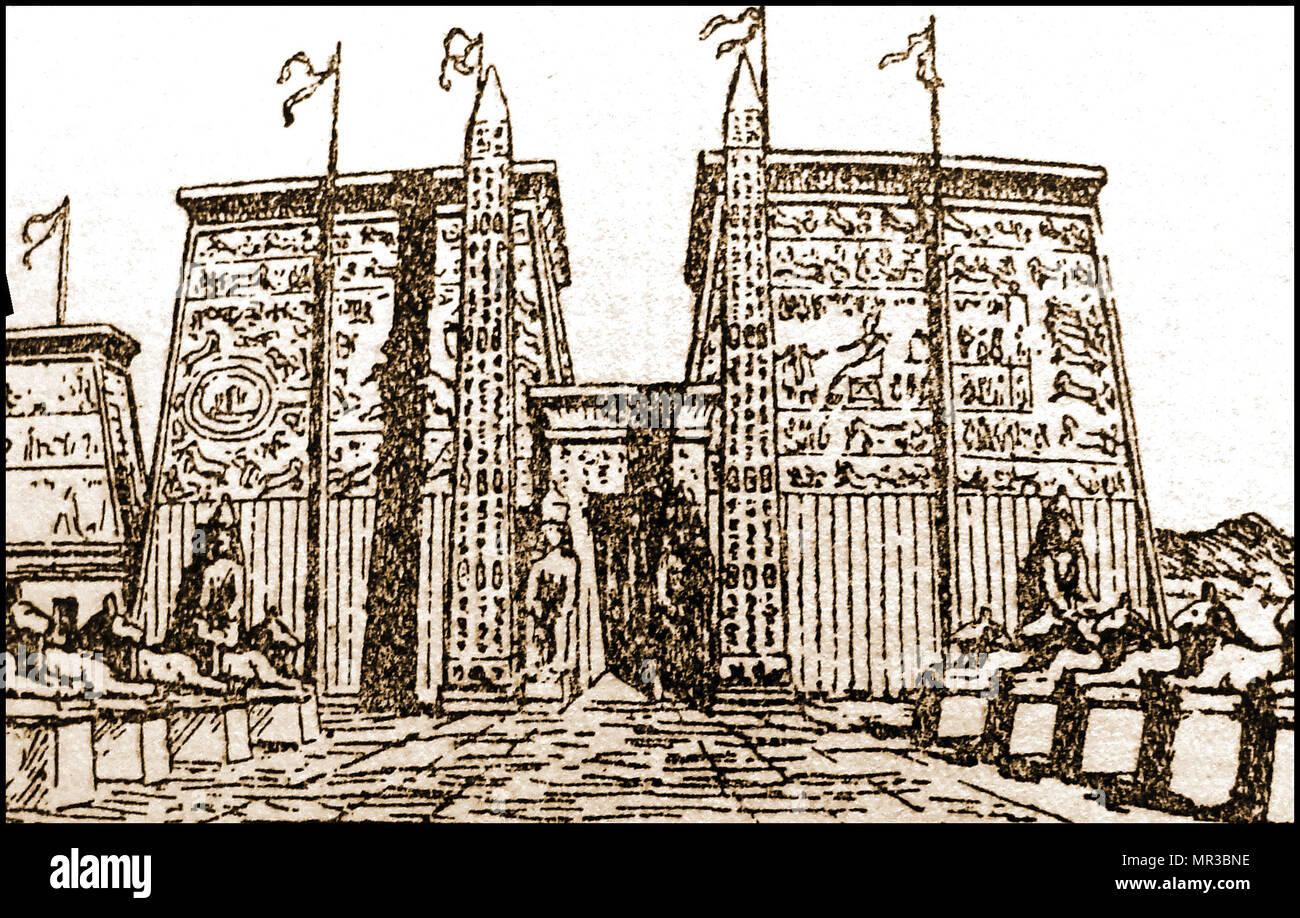 1933. An artist's impression of the Temple of Luxor. Egypt restored. Stock Photohttps://www.alamy.com/image-license-details/?v=1https://www.alamy.com/1933-an-artists-impression-of-the-temple-of-luxor-egypt-restored-image186315850.html
1933. An artist's impression of the Temple of Luxor. Egypt restored. Stock Photohttps://www.alamy.com/image-license-details/?v=1https://www.alamy.com/1933-an-artists-impression-of-the-temple-of-luxor-egypt-restored-image186315850.htmlRMMR3BNE–1933. An artist's impression of the Temple of Luxor. Egypt restored.
 Luxor; Egypt; January 16, 2024: The Sacred Boat of the Theban Triad was a ceremonial boat used in ancient Egyptian processions along the Avenue of the Stock Photohttps://www.alamy.com/image-license-details/?v=1https://www.alamy.com/luxor-egypt-january-16-2024-the-sacred-boat-of-the-theban-triad-was-a-ceremonial-boat-used-in-ancient-egyptian-processions-along-the-avenue-of-the-image624418038.html
Luxor; Egypt; January 16, 2024: The Sacred Boat of the Theban Triad was a ceremonial boat used in ancient Egyptian processions along the Avenue of the Stock Photohttps://www.alamy.com/image-license-details/?v=1https://www.alamy.com/luxor-egypt-january-16-2024-the-sacred-boat-of-the-theban-triad-was-a-ceremonial-boat-used-in-ancient-egyptian-processions-along-the-avenue-of-the-image624418038.htmlRF2Y7TKG6–Luxor; Egypt; January 16, 2024: The Sacred Boat of the Theban Triad was a ceremonial boat used in ancient Egyptian processions along the Avenue of the
 A relief depicting the God Thoth, Ramses II and the Theban family triad of Amun, Mut and Khonsu at the Ramesseum on the West Bank of Luxor, Egypt Stock Photohttps://www.alamy.com/image-license-details/?v=1https://www.alamy.com/a-relief-depicting-the-god-thoth-ramses-ii-and-the-theban-family-triad-of-amun-mut-and-khonsu-at-the-ramesseum-on-the-west-bank-of-luxor-egypt-image604630509.html
A relief depicting the God Thoth, Ramses II and the Theban family triad of Amun, Mut and Khonsu at the Ramesseum on the West Bank of Luxor, Egypt Stock Photohttps://www.alamy.com/image-license-details/?v=1https://www.alamy.com/a-relief-depicting-the-god-thoth-ramses-ii-and-the-theban-family-triad-of-amun-mut-and-khonsu-at-the-ramesseum-on-the-west-bank-of-luxor-egypt-image604630509.htmlRM2X3K8AN–A relief depicting the God Thoth, Ramses II and the Theban family triad of Amun, Mut and Khonsu at the Ramesseum on the West Bank of Luxor, Egypt
 Khonsu, Late Period–Ptolemaic Period, 664–30 B.C., From Egypt, Cupreous metal, H. 11.3 cm (4 7/6 in.); W. 2.9 cm (1 1/8 in.); D Stock Photohttps://www.alamy.com/image-license-details/?v=1https://www.alamy.com/stock-image-khonsu-late-periodptolemaic-period-66430-bc-from-egypt-cupreous-metal-162385046.html
Khonsu, Late Period–Ptolemaic Period, 664–30 B.C., From Egypt, Cupreous metal, H. 11.3 cm (4 7/6 in.); W. 2.9 cm (1 1/8 in.); D Stock Photohttps://www.alamy.com/image-license-details/?v=1https://www.alamy.com/stock-image-khonsu-late-periodptolemaic-period-66430-bc-from-egypt-cupreous-metal-162385046.htmlRMKC57NX–Khonsu, Late Period–Ptolemaic Period, 664–30 B.C., From Egypt, Cupreous metal, H. 11.3 cm (4 7/6 in.); W. 2.9 cm (1 1/8 in.); D
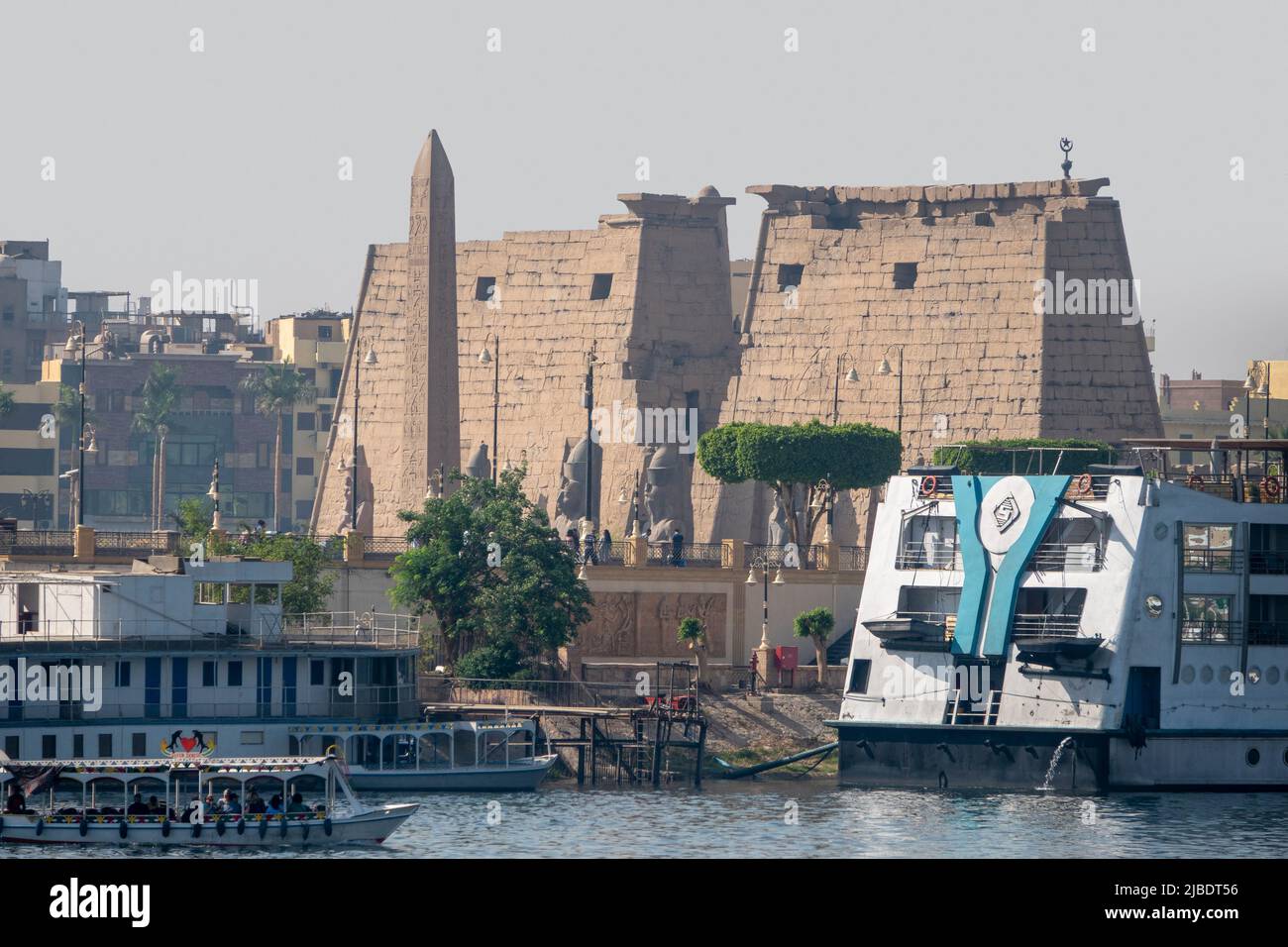 View of Luxor Temple, and Luxor Corniche, taken from the River Nile Stock Photohttps://www.alamy.com/image-license-details/?v=1https://www.alamy.com/view-of-luxor-temple-and-luxor-corniche-taken-from-the-river-nile-image471745490.html
View of Luxor Temple, and Luxor Corniche, taken from the River Nile Stock Photohttps://www.alamy.com/image-license-details/?v=1https://www.alamy.com/view-of-luxor-temple-and-luxor-corniche-taken-from-the-river-nile-image471745490.htmlRM2JBDT56–View of Luxor Temple, and Luxor Corniche, taken from the River Nile
 Part of the Karnak temple (Ancient Thebes with its Necropolis), the main place of worship of the eighteenth dynasty Theban Triad with the god Amun as Stock Photohttps://www.alamy.com/image-license-details/?v=1https://www.alamy.com/part-of-the-karnak-temple-ancient-thebes-with-its-necropolis-the-main-place-of-worship-of-the-eighteenth-dynasty-theban-triad-with-the-god-amun-as-image182738766.html
Part of the Karnak temple (Ancient Thebes with its Necropolis), the main place of worship of the eighteenth dynasty Theban Triad with the god Amun as Stock Photohttps://www.alamy.com/image-license-details/?v=1https://www.alamy.com/part-of-the-karnak-temple-ancient-thebes-with-its-necropolis-the-main-place-of-worship-of-the-eighteenth-dynasty-theban-triad-with-the-god-amun-as-image182738766.htmlRFMH8D4E–Part of the Karnak temple (Ancient Thebes with its Necropolis), the main place of worship of the eighteenth dynasty Theban Triad with the god Amun as
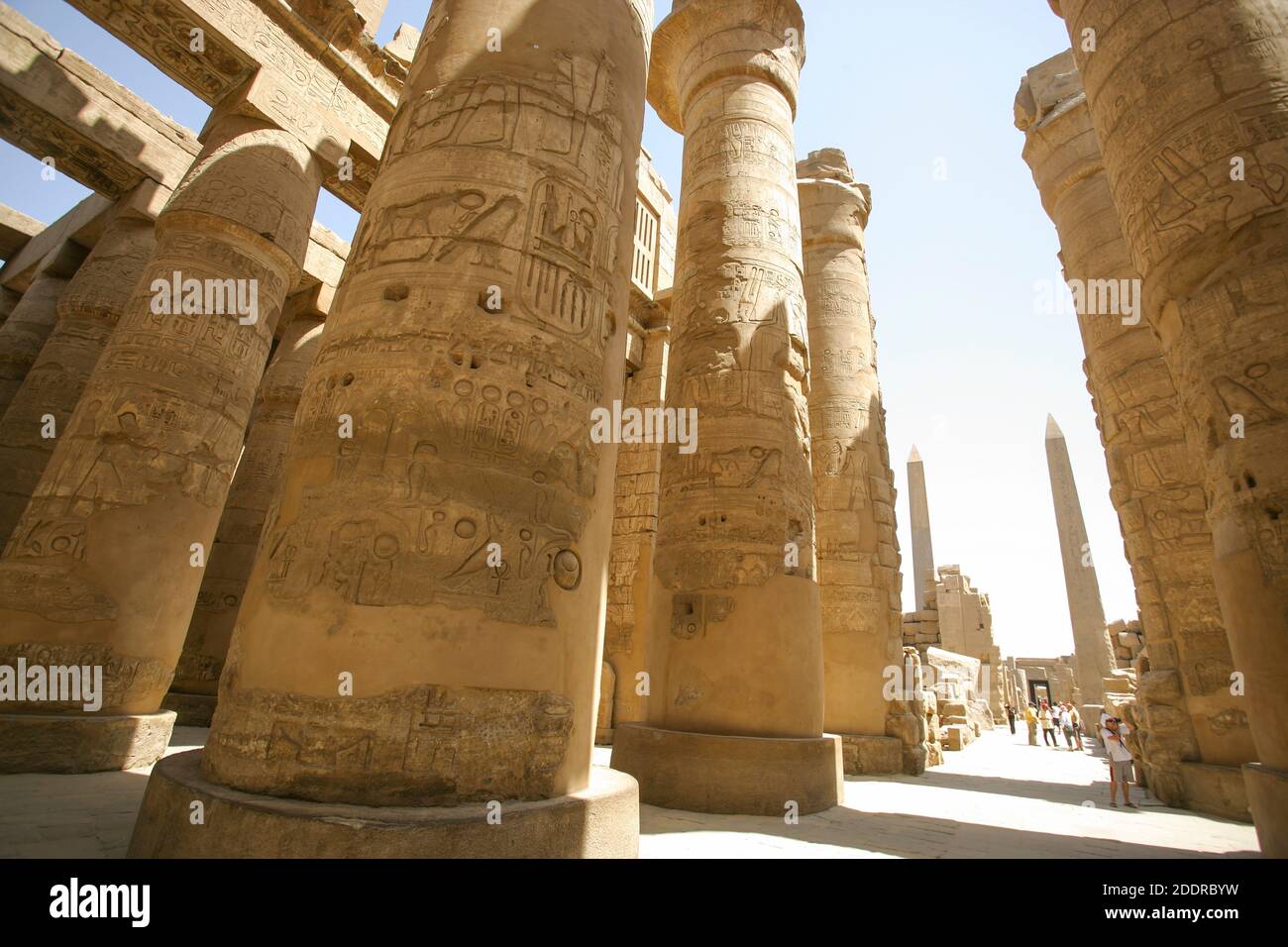 KARNAK TEMPLES IN EGYPT Stock Photohttps://www.alamy.com/image-license-details/?v=1https://www.alamy.com/karnak-temples-in-egypt-image387132925.html
KARNAK TEMPLES IN EGYPT Stock Photohttps://www.alamy.com/image-license-details/?v=1https://www.alamy.com/karnak-temples-in-egypt-image387132925.htmlRF2DDRBYW–KARNAK TEMPLES IN EGYPT
 The tall columns in the Hypostyle hall at the Temple of Amun at Karnak, Luxor, Nile Valley, Egypt. The Karnak Temple Complex is the largest religious building ever made, covering about 200 acres. It comprises a vast mix of decayed temples, chapels, pylons, and other buildings built over 2,000 years and dedicated to the Theban triad of Amun, Mut, and Khonsu. The Hypostyle hall, at 54,000 square feet (16,459 meters) and featuring 134 columns, is still the largest room of any religious building in the world. Stock Photohttps://www.alamy.com/image-license-details/?v=1https://www.alamy.com/stock-photo-the-tall-columns-in-the-hypostyle-hall-at-the-temple-of-amun-at-karnak-100532020.html
The tall columns in the Hypostyle hall at the Temple of Amun at Karnak, Luxor, Nile Valley, Egypt. The Karnak Temple Complex is the largest religious building ever made, covering about 200 acres. It comprises a vast mix of decayed temples, chapels, pylons, and other buildings built over 2,000 years and dedicated to the Theban triad of Amun, Mut, and Khonsu. The Hypostyle hall, at 54,000 square feet (16,459 meters) and featuring 134 columns, is still the largest room of any religious building in the world. Stock Photohttps://www.alamy.com/image-license-details/?v=1https://www.alamy.com/stock-photo-the-tall-columns-in-the-hypostyle-hall-at-the-temple-of-amun-at-karnak-100532020.htmlRMFRFHH8–The tall columns in the Hypostyle hall at the Temple of Amun at Karnak, Luxor, Nile Valley, Egypt. The Karnak Temple Complex is the largest religious building ever made, covering about 200 acres. It comprises a vast mix of decayed temples, chapels, pylons, and other buildings built over 2,000 years and dedicated to the Theban triad of Amun, Mut, and Khonsu. The Hypostyle hall, at 54,000 square feet (16,459 meters) and featuring 134 columns, is still the largest room of any religious building in the world.
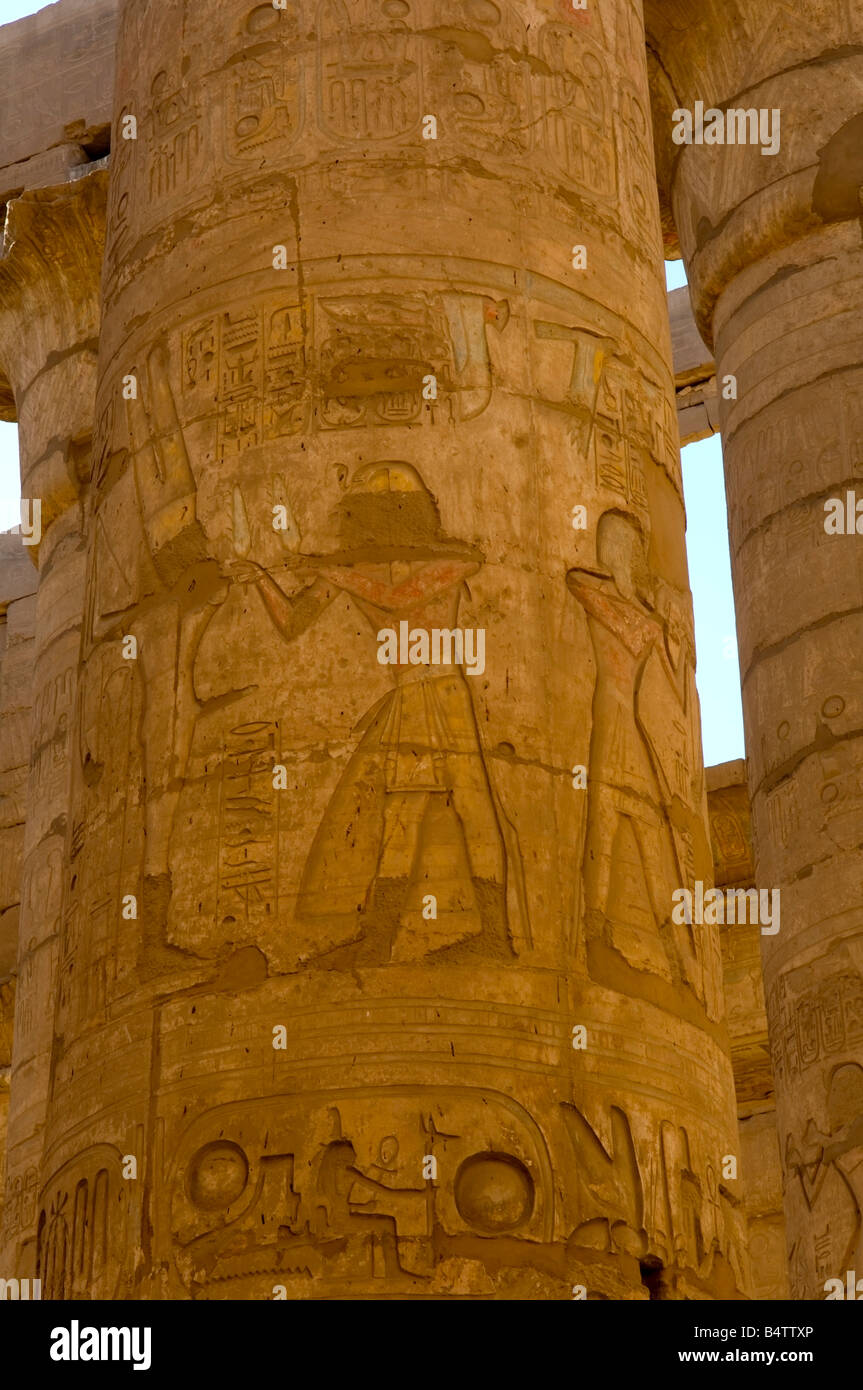 Columns showing remnants of colour Great Hypostyle Hall, Karnak Temple Complex, UNESCO World Heritage Site, Luxor, Egypt Stock Photohttps://www.alamy.com/image-license-details/?v=1https://www.alamy.com/stock-photo-columns-showing-remnants-of-colour-great-hypostyle-hall-karnak-temple-20215406.html
Columns showing remnants of colour Great Hypostyle Hall, Karnak Temple Complex, UNESCO World Heritage Site, Luxor, Egypt Stock Photohttps://www.alamy.com/image-license-details/?v=1https://www.alamy.com/stock-photo-columns-showing-remnants-of-colour-great-hypostyle-hall-karnak-temple-20215406.htmlRMB4TTXP–Columns showing remnants of colour Great Hypostyle Hall, Karnak Temple Complex, UNESCO World Heritage Site, Luxor, Egypt
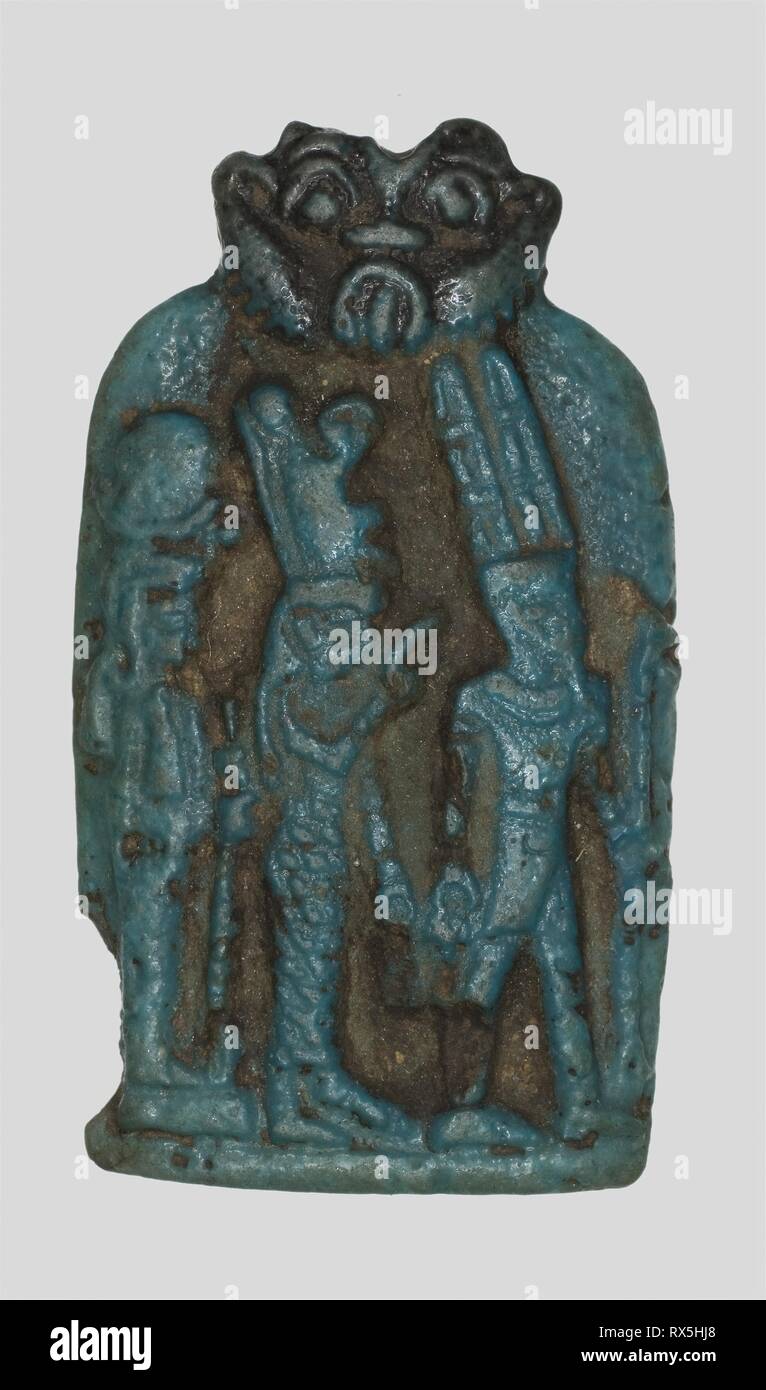 Amulet of the Theban Triad, Amun, Mut, and Khonsu. Egyptian. Date: 664 BC-332 BC. Dimensions: 4.4 × 2.5 × 0.3 cm (1 3/4 × 1 × 1/8 in.). Faience. Origin: Egypt. Museum: The Chicago Art Institute. Author: Ancient Egyptian. Stock Photohttps://www.alamy.com/image-license-details/?v=1https://www.alamy.com/amulet-of-the-theban-triad-amun-mut-and-khonsu-egyptian-date-664-bc-332-bc-dimensions-44-25-03-cm-1-34-1-18-in-faience-origin-egypt-museum-the-chicago-art-institute-author-ancient-egyptian-image239839440.html
Amulet of the Theban Triad, Amun, Mut, and Khonsu. Egyptian. Date: 664 BC-332 BC. Dimensions: 4.4 × 2.5 × 0.3 cm (1 3/4 × 1 × 1/8 in.). Faience. Origin: Egypt. Museum: The Chicago Art Institute. Author: Ancient Egyptian. Stock Photohttps://www.alamy.com/image-license-details/?v=1https://www.alamy.com/amulet-of-the-theban-triad-amun-mut-and-khonsu-egyptian-date-664-bc-332-bc-dimensions-44-25-03-cm-1-34-1-18-in-faience-origin-egypt-museum-the-chicago-art-institute-author-ancient-egyptian-image239839440.htmlRMRX5HJ8–Amulet of the Theban Triad, Amun, Mut, and Khonsu. Egyptian. Date: 664 BC-332 BC. Dimensions: 4.4 × 2.5 × 0.3 cm (1 3/4 × 1 × 1/8 in.). Faience. Origin: Egypt. Museum: The Chicago Art Institute. Author: Ancient Egyptian.
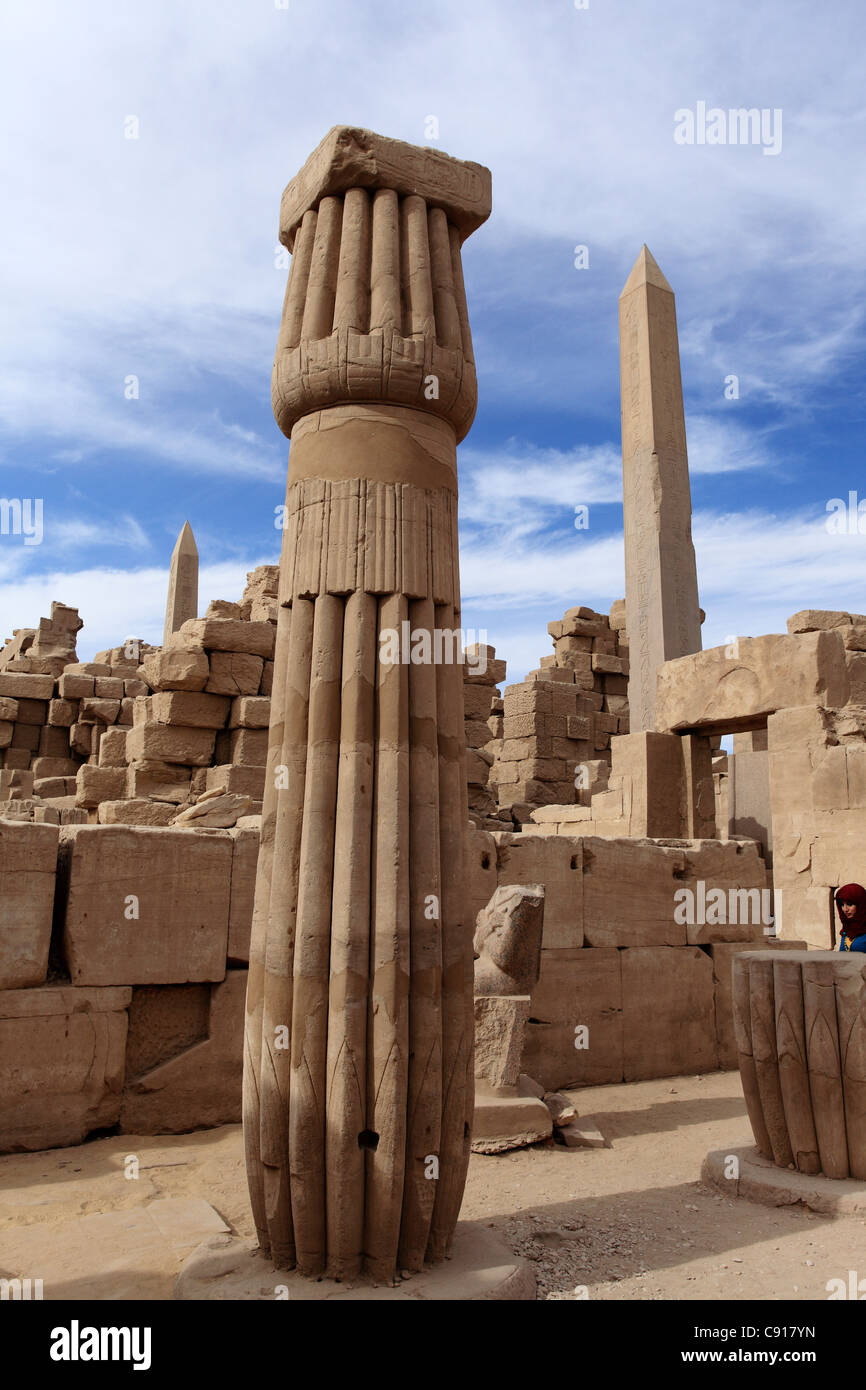 Karnak temple is a huge pharonic temple and open-air museum and the largest ancient religious site in the world. It was the Stock Photohttps://www.alamy.com/image-license-details/?v=1https://www.alamy.com/stock-photo-karnak-temple-is-a-huge-pharonic-temple-and-open-air-museum-and-the-39980857.html
Karnak temple is a huge pharonic temple and open-air museum and the largest ancient religious site in the world. It was the Stock Photohttps://www.alamy.com/image-license-details/?v=1https://www.alamy.com/stock-photo-karnak-temple-is-a-huge-pharonic-temple-and-open-air-museum-and-the-39980857.htmlRMC917YN–Karnak temple is a huge pharonic temple and open-air museum and the largest ancient religious site in the world. It was the
 This is the largest of the precincts of the temple complex, and is dedicated to Amun-Re, the chief deity of the Theban Triad. There are several coloss Stock Photohttps://www.alamy.com/image-license-details/?v=1https://www.alamy.com/this-is-the-largest-of-the-precincts-of-the-temple-complex-and-is-dedicated-to-amun-re-the-chief-deity-of-the-theban-triad-there-are-several-coloss-image384534367.html
This is the largest of the precincts of the temple complex, and is dedicated to Amun-Re, the chief deity of the Theban Triad. There are several coloss Stock Photohttps://www.alamy.com/image-license-details/?v=1https://www.alamy.com/this-is-the-largest-of-the-precincts-of-the-temple-complex-and-is-dedicated-to-amun-re-the-chief-deity-of-the-theban-triad-there-are-several-coloss-image384534367.htmlRM2D9H1E7–This is the largest of the precincts of the temple complex, and is dedicated to Amun-Re, the chief deity of the Theban Triad. There are several coloss
 Karnak Temple Complex, in Luxor, Egypt. Construction at the complex began during the reign of Senusret I in the Middle Kingdom and continued into the Ptolemaic period, although most of the extant buildings date from the New Kingdom. The area around Karnak was the main place of worship of the eighteenth dynasty Theban Triad with the god Amun as its head. It is part of the monumental city of Thebes. Stock Photohttps://www.alamy.com/image-license-details/?v=1https://www.alamy.com/karnak-temple-complex-in-luxor-egypt-construction-at-the-complex-began-during-the-reign-of-senusret-i-in-the-middle-kingdom-and-continued-into-the-ptolemaic-period-although-most-of-the-extant-buildings-date-from-the-new-kingdom-the-area-around-karnak-was-the-main-place-of-worship-of-the-eighteenth-dynasty-theban-triad-with-the-god-amun-as-its-head-it-is-part-of-the-monumental-city-of-thebes-image328340284.html
Karnak Temple Complex, in Luxor, Egypt. Construction at the complex began during the reign of Senusret I in the Middle Kingdom and continued into the Ptolemaic period, although most of the extant buildings date from the New Kingdom. The area around Karnak was the main place of worship of the eighteenth dynasty Theban Triad with the god Amun as its head. It is part of the monumental city of Thebes. Stock Photohttps://www.alamy.com/image-license-details/?v=1https://www.alamy.com/karnak-temple-complex-in-luxor-egypt-construction-at-the-complex-began-during-the-reign-of-senusret-i-in-the-middle-kingdom-and-continued-into-the-ptolemaic-period-although-most-of-the-extant-buildings-date-from-the-new-kingdom-the-area-around-karnak-was-the-main-place-of-worship-of-the-eighteenth-dynasty-theban-triad-with-the-god-amun-as-its-head-it-is-part-of-the-monumental-city-of-thebes-image328340284.htmlRM2A255AM–Karnak Temple Complex, in Luxor, Egypt. Construction at the complex began during the reign of Senusret I in the Middle Kingdom and continued into the Ptolemaic period, although most of the extant buildings date from the New Kingdom. The area around Karnak was the main place of worship of the eighteenth dynasty Theban Triad with the god Amun as its head. It is part of the monumental city of Thebes.
 Relief depicting god Amun with great helmet covered with two large feathers and beard sitting on the throne. Luxor. Stock Photohttps://www.alamy.com/image-license-details/?v=1https://www.alamy.com/stock-photo-relief-depicting-god-amun-with-great-helmet-covered-with-two-large-27234800.html
Relief depicting god Amun with great helmet covered with two large feathers and beard sitting on the throne. Luxor. Stock Photohttps://www.alamy.com/image-license-details/?v=1https://www.alamy.com/stock-photo-relief-depicting-god-amun-with-great-helmet-covered-with-two-large-27234800.htmlRMBG8J7C–Relief depicting god Amun with great helmet covered with two large feathers and beard sitting on the throne. Luxor.
 . Amun-Re, chief god of the Theban Triad. Relief from the Karnak temple complex. circa 1450BC. Anonymous 43 Amun-Ra Stock Photohttps://www.alamy.com/image-license-details/?v=1https://www.alamy.com/amun-re-chief-god-of-the-theban-triad-relief-from-the-karnak-temple-complex-circa-1450bc-anonymous-43-amun-ra-image188179183.html
. Amun-Re, chief god of the Theban Triad. Relief from the Karnak temple complex. circa 1450BC. Anonymous 43 Amun-Ra Stock Photohttps://www.alamy.com/image-license-details/?v=1https://www.alamy.com/amun-re-chief-god-of-the-theban-triad-relief-from-the-karnak-temple-complex-circa-1450bc-anonymous-43-amun-ra-image188179183.htmlRMMX48D3–. Amun-Re, chief god of the Theban Triad. Relief from the Karnak temple complex. circa 1450BC. Anonymous 43 Amun-Ra
 Ruins of Temple 500, Naqa, northern Sudan Stock Photohttps://www.alamy.com/image-license-details/?v=1https://www.alamy.com/stock-photo-ruins-of-temple-500-naqa-northern-sudan-71173424.html
Ruins of Temple 500, Naqa, northern Sudan Stock Photohttps://www.alamy.com/image-license-details/?v=1https://www.alamy.com/stock-photo-ruins-of-temple-500-naqa-northern-sudan-71173424.htmlRME3P6C0–Ruins of Temple 500, Naqa, northern Sudan
RF2GAADYW–Ancient Egyptian God, Goddess, and deities in stick figure icons. Vector illustration set of popular Egypt deities Amon, Osiris, Isis, Horus, Anubis,
 Carved hieroglyphs on a wall in the temple of Karnak, Luxor, Egypt. Stock Photohttps://www.alamy.com/image-license-details/?v=1https://www.alamy.com/stock-photo-carved-hieroglyphs-on-a-wall-in-the-temple-of-karnak-luxor-egypt-28210038.html
Carved hieroglyphs on a wall in the temple of Karnak, Luxor, Egypt. Stock Photohttps://www.alamy.com/image-license-details/?v=1https://www.alamy.com/stock-photo-carved-hieroglyphs-on-a-wall-in-the-temple-of-karnak-luxor-egypt-28210038.htmlRFBHW25A–Carved hieroglyphs on a wall in the temple of Karnak, Luxor, Egypt.
 . The Nile. Notes for travellers in Egypt . ATMU, 96 NOTES FOR TRAVELLERS IN EGYPT. Mut jN* J), the Mother,was one of the divinities of the Theban triad ; she was supposed to represent Nature,the mother of all things. Chepera OO, the Creator, was associated with Ptah, and was supposed to be the god who caused himselfto come into existence. He is represented with a beetlefor his head. In later days he was supposed to be the fatherof the gods and creator of the universe, and the attributeswhich had been applied to Ra during the Middle Empirewere transferred to him. {See pp. 200-202.) Bast |7 ^ Stock Photohttps://www.alamy.com/image-license-details/?v=1https://www.alamy.com/the-nile-notes-for-travellers-in-egypt-atmu-96-notes-for-travellers-in-egypt-mut-jn-j-the-motherwas-one-of-the-divinities-of-the-theban-triad-she-was-supposed-to-represent-naturethe-mother-of-all-things-chepera-oo-the-creator-was-associated-with-ptah-and-was-supposed-to-be-the-god-who-caused-himselfto-come-into-existence-he-is-represented-with-a-beetlefor-his-head-in-later-days-he-was-supposed-to-be-the-fatherof-the-gods-and-creator-of-the-universe-and-the-attributeswhich-had-been-applied-to-ra-during-the-middle-empirewere-transferred-to-him-see-pp-200-202-bast-7-image372575420.html
. The Nile. Notes for travellers in Egypt . ATMU, 96 NOTES FOR TRAVELLERS IN EGYPT. Mut jN* J), the Mother,was one of the divinities of the Theban triad ; she was supposed to represent Nature,the mother of all things. Chepera OO, the Creator, was associated with Ptah, and was supposed to be the god who caused himselfto come into existence. He is represented with a beetlefor his head. In later days he was supposed to be the fatherof the gods and creator of the universe, and the attributeswhich had been applied to Ra during the Middle Empirewere transferred to him. {See pp. 200-202.) Bast |7 ^ Stock Photohttps://www.alamy.com/image-license-details/?v=1https://www.alamy.com/the-nile-notes-for-travellers-in-egypt-atmu-96-notes-for-travellers-in-egypt-mut-jn-j-the-motherwas-one-of-the-divinities-of-the-theban-triad-she-was-supposed-to-represent-naturethe-mother-of-all-things-chepera-oo-the-creator-was-associated-with-ptah-and-was-supposed-to-be-the-god-who-caused-himselfto-come-into-existence-he-is-represented-with-a-beetlefor-his-head-in-later-days-he-was-supposed-to-be-the-fatherof-the-gods-and-creator-of-the-universe-and-the-attributeswhich-had-been-applied-to-ra-during-the-middle-empirewere-transferred-to-him-see-pp-200-202-bast-7-image372575420.htmlRM2CJ47N0–. The Nile. Notes for travellers in Egypt . ATMU, 96 NOTES FOR TRAVELLERS IN EGYPT. Mut jN* J), the Mother,was one of the divinities of the Theban triad ; she was supposed to represent Nature,the mother of all things. Chepera OO, the Creator, was associated with Ptah, and was supposed to be the god who caused himselfto come into existence. He is represented with a beetlefor his head. In later days he was supposed to be the fatherof the gods and creator of the universe, and the attributeswhich had been applied to Ra during the Middle Empirewere transferred to him. {See pp. 200-202.) Bast |7 ^
 Ruins of Deir al-Hagar Temple, western desert of Egypt Stock Photohttps://www.alamy.com/image-license-details/?v=1https://www.alamy.com/stock-photo-ruins-of-deir-al-hagar-temple-western-desert-of-egypt-27190061.html
Ruins of Deir al-Hagar Temple, western desert of Egypt Stock Photohttps://www.alamy.com/image-license-details/?v=1https://www.alamy.com/stock-photo-ruins-of-deir-al-hagar-temple-western-desert-of-egypt-27190061.htmlRFBG6H5H–Ruins of Deir al-Hagar Temple, western desert of Egypt
 Art inspired by Khonsu, Late Period–Ptolemaic Period, 664–30 B.C., From Egypt, Cupreous metal, H. 11.3 cm (4 7/6 in.); W. 2.9 cm (1 1/8 in.); D. 2 cm (13/16 in.), This figure represents a child deity standing and holding a scepter. The moon disk, sidelock, and close-fitting mummiform, Classic works modernized by Artotop with a splash of modernity. Shapes, color and value, eye-catching visual impact on art. Emotions through freedom of artworks in a contemporary way. A timeless message pursuing a wildly creative new direction. Artists turning to the digital medium and creating the Artotop NFT Stock Photohttps://www.alamy.com/image-license-details/?v=1https://www.alamy.com/art-inspired-by-khonsu-late-periodptolemaic-period-66430-bc-from-egypt-cupreous-metal-h-113-cm-4-76-in-w-29-cm-1-18-in-d-2-cm-1316-in-this-figure-represents-a-child-deity-standing-and-holding-a-scepter-the-moon-disk-sidelock-and-close-fitting-mummiform-classic-works-modernized-by-artotop-with-a-splash-of-modernity-shapes-color-and-value-eye-catching-visual-impact-on-art-emotions-through-freedom-of-artworks-in-a-contemporary-way-a-timeless-message-pursuing-a-wildly-creative-new-direction-artists-turning-to-the-digital-medium-and-creating-the-artotop-nft-image462862059.html
Art inspired by Khonsu, Late Period–Ptolemaic Period, 664–30 B.C., From Egypt, Cupreous metal, H. 11.3 cm (4 7/6 in.); W. 2.9 cm (1 1/8 in.); D. 2 cm (13/16 in.), This figure represents a child deity standing and holding a scepter. The moon disk, sidelock, and close-fitting mummiform, Classic works modernized by Artotop with a splash of modernity. Shapes, color and value, eye-catching visual impact on art. Emotions through freedom of artworks in a contemporary way. A timeless message pursuing a wildly creative new direction. Artists turning to the digital medium and creating the Artotop NFT Stock Photohttps://www.alamy.com/image-license-details/?v=1https://www.alamy.com/art-inspired-by-khonsu-late-periodptolemaic-period-66430-bc-from-egypt-cupreous-metal-h-113-cm-4-76-in-w-29-cm-1-18-in-d-2-cm-1316-in-this-figure-represents-a-child-deity-standing-and-holding-a-scepter-the-moon-disk-sidelock-and-close-fitting-mummiform-classic-works-modernized-by-artotop-with-a-splash-of-modernity-shapes-color-and-value-eye-catching-visual-impact-on-art-emotions-through-freedom-of-artworks-in-a-contemporary-way-a-timeless-message-pursuing-a-wildly-creative-new-direction-artists-turning-to-the-digital-medium-and-creating-the-artotop-nft-image462862059.htmlRF2HW157R–Art inspired by Khonsu, Late Period–Ptolemaic Period, 664–30 B.C., From Egypt, Cupreous metal, H. 11.3 cm (4 7/6 in.); W. 2.9 cm (1 1/8 in.); D. 2 cm (13/16 in.), This figure represents a child deity standing and holding a scepter. The moon disk, sidelock, and close-fitting mummiform, Classic works modernized by Artotop with a splash of modernity. Shapes, color and value, eye-catching visual impact on art. Emotions through freedom of artworks in a contemporary way. A timeless message pursuing a wildly creative new direction. Artists turning to the digital medium and creating the Artotop NFT
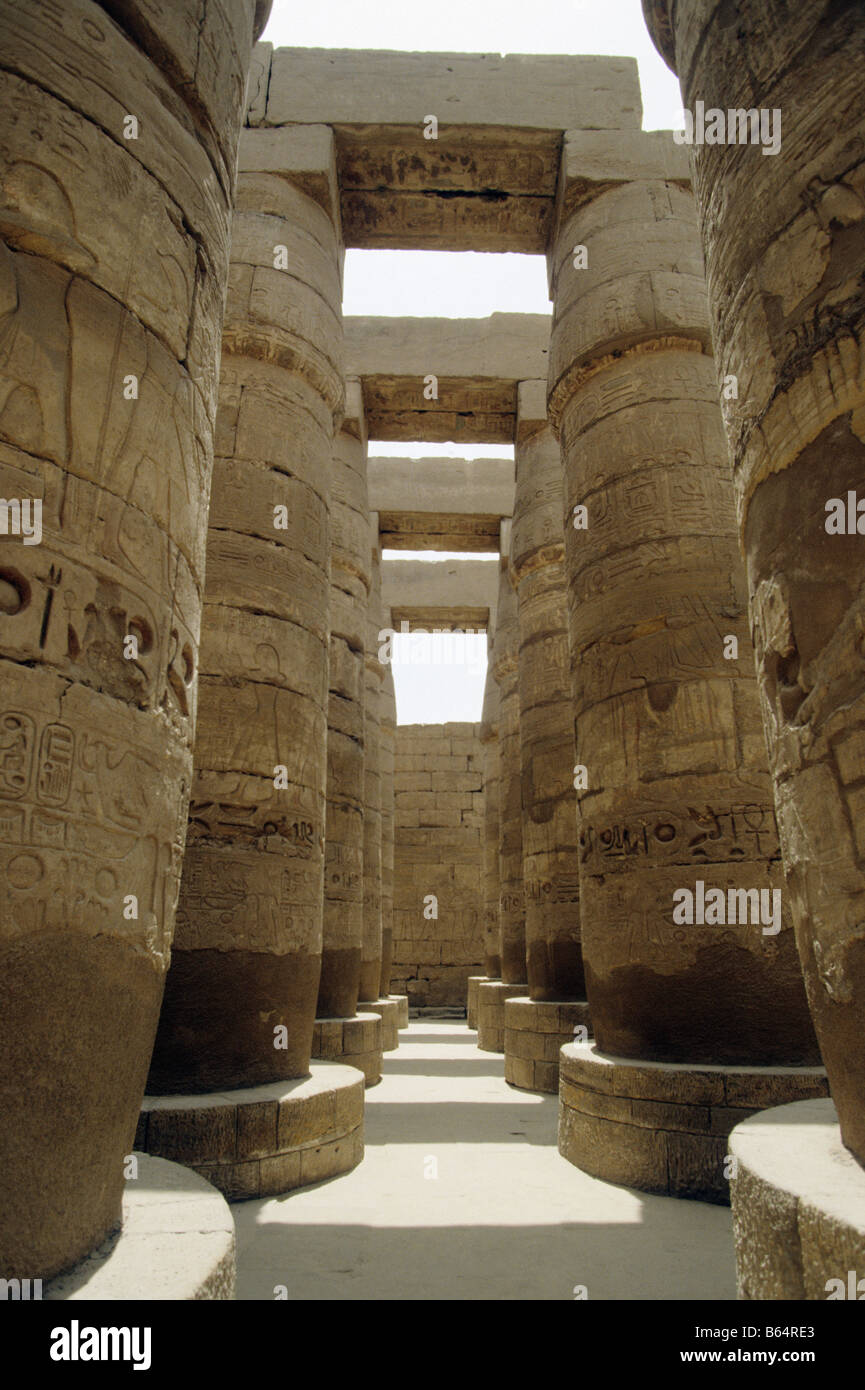 Pillars at the Karnak Temple in the monumental city of Thebes near Luxor Egypt. Stock Photohttps://www.alamy.com/image-license-details/?v=1https://www.alamy.com/stock-photo-pillars-at-the-karnak-temple-in-the-monumental-city-of-thebes-near-21004539.html
Pillars at the Karnak Temple in the monumental city of Thebes near Luxor Egypt. Stock Photohttps://www.alamy.com/image-license-details/?v=1https://www.alamy.com/stock-photo-pillars-at-the-karnak-temple-in-the-monumental-city-of-thebes-near-21004539.htmlRMB64RE3–Pillars at the Karnak Temple in the monumental city of Thebes near Luxor Egypt.
 The Temple of Khonsu at Karnak Stock Photohttps://www.alamy.com/image-license-details/?v=1https://www.alamy.com/the-temple-of-khonsu-at-karnak-image496750746.html
The Temple of Khonsu at Karnak Stock Photohttps://www.alamy.com/image-license-details/?v=1https://www.alamy.com/the-temple-of-khonsu-at-karnak-image496750746.htmlRF2KT4XJ2–The Temple of Khonsu at Karnak
 View of Luxor Temple, and Luxor Corniche, taken from the River Nile Stock Photohttps://www.alamy.com/image-license-details/?v=1https://www.alamy.com/view-of-luxor-temple-and-luxor-corniche-taken-from-the-river-nile-image471745497.html
View of Luxor Temple, and Luxor Corniche, taken from the River Nile Stock Photohttps://www.alamy.com/image-license-details/?v=1https://www.alamy.com/view-of-luxor-temple-and-luxor-corniche-taken-from-the-river-nile-image471745497.htmlRF2JBDT5D–View of Luxor Temple, and Luxor Corniche, taken from the River Nile
 Part of the Karnak temple (Ancient Thebes with its Necropolis), the main place of worship of the eighteenth dynasty Theban Triad with the god Amun as Stock Photohttps://www.alamy.com/image-license-details/?v=1https://www.alamy.com/part-of-the-karnak-temple-ancient-thebes-with-its-necropolis-the-main-place-of-worship-of-the-eighteenth-dynasty-theban-triad-with-the-god-amun-as-image182738775.html
Part of the Karnak temple (Ancient Thebes with its Necropolis), the main place of worship of the eighteenth dynasty Theban Triad with the god Amun as Stock Photohttps://www.alamy.com/image-license-details/?v=1https://www.alamy.com/part-of-the-karnak-temple-ancient-thebes-with-its-necropolis-the-main-place-of-worship-of-the-eighteenth-dynasty-theban-triad-with-the-god-amun-as-image182738775.htmlRFMH8D4R–Part of the Karnak temple (Ancient Thebes with its Necropolis), the main place of worship of the eighteenth dynasty Theban Triad with the god Amun as
 KARNAK TEMPLES IN EGYPT Stock Photohttps://www.alamy.com/image-license-details/?v=1https://www.alamy.com/karnak-temples-in-egypt-image387133038.html
KARNAK TEMPLES IN EGYPT Stock Photohttps://www.alamy.com/image-license-details/?v=1https://www.alamy.com/karnak-temples-in-egypt-image387133038.htmlRF2DDRC3X–KARNAK TEMPLES IN EGYPT
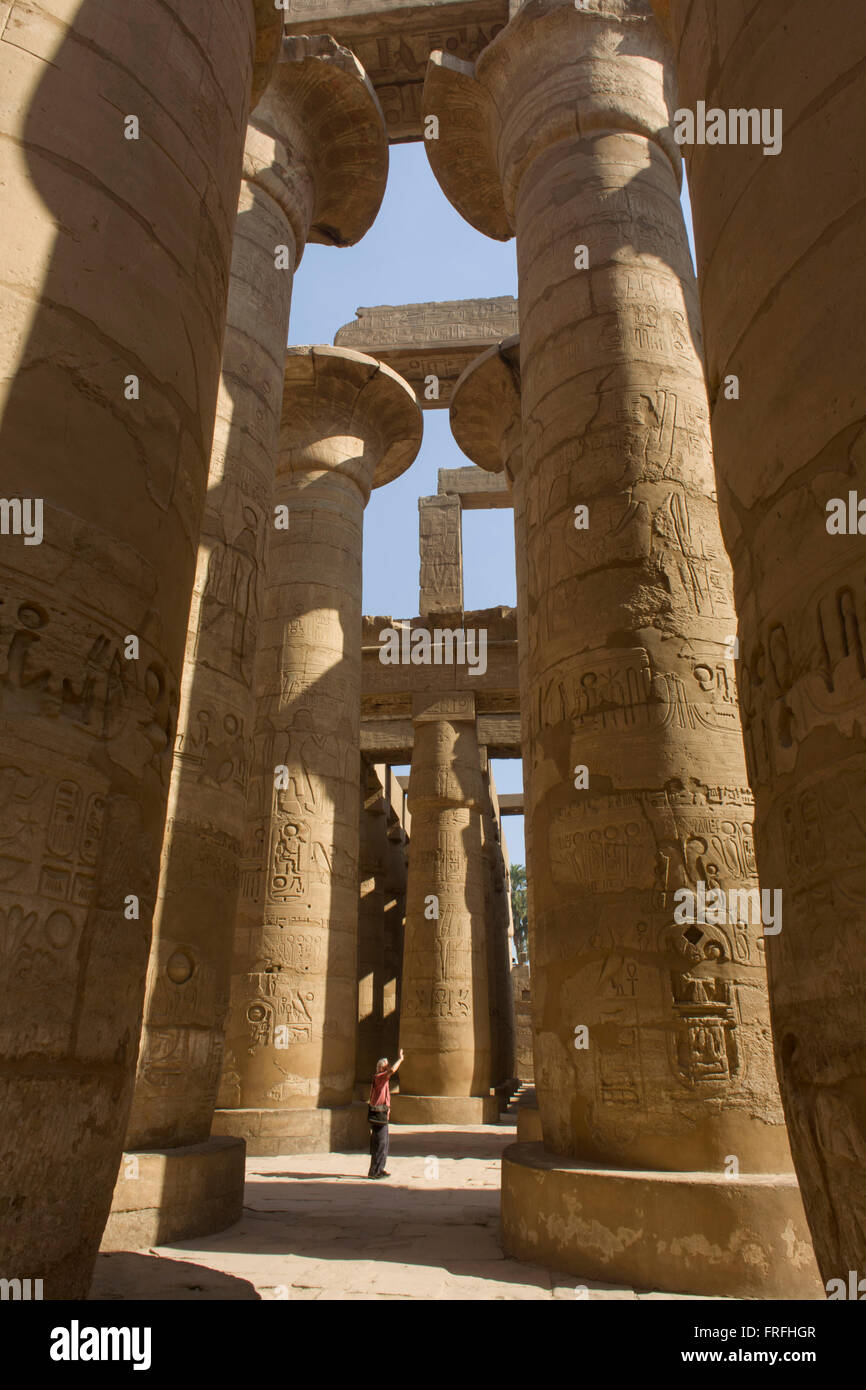 The tall columns in the Hypostyle hall at the Temple of Amun at Karnak, Luxor, Nile Valley, Egypt. The Karnak Temple Complex is the largest religious building ever made, covering about 200 acres. It comprises a vast mix of decayed temples, chapels, pylons, and other buildings built over 2,000 years and dedicated to the Theban triad of Amun, Mut, and Khonsu. The Hypostyle hall, at 54,000 square feet (16,459 meters) and featuring 134 columns, is still the largest room of any religious building in the world. Stock Photohttps://www.alamy.com/image-license-details/?v=1https://www.alamy.com/stock-photo-the-tall-columns-in-the-hypostyle-hall-at-the-temple-of-amun-at-karnak-100532007.html
The tall columns in the Hypostyle hall at the Temple of Amun at Karnak, Luxor, Nile Valley, Egypt. The Karnak Temple Complex is the largest religious building ever made, covering about 200 acres. It comprises a vast mix of decayed temples, chapels, pylons, and other buildings built over 2,000 years and dedicated to the Theban triad of Amun, Mut, and Khonsu. The Hypostyle hall, at 54,000 square feet (16,459 meters) and featuring 134 columns, is still the largest room of any religious building in the world. Stock Photohttps://www.alamy.com/image-license-details/?v=1https://www.alamy.com/stock-photo-the-tall-columns-in-the-hypostyle-hall-at-the-temple-of-amun-at-karnak-100532007.htmlRMFRFHGR–The tall columns in the Hypostyle hall at the Temple of Amun at Karnak, Luxor, Nile Valley, Egypt. The Karnak Temple Complex is the largest religious building ever made, covering about 200 acres. It comprises a vast mix of decayed temples, chapels, pylons, and other buildings built over 2,000 years and dedicated to the Theban triad of Amun, Mut, and Khonsu. The Hypostyle hall, at 54,000 square feet (16,459 meters) and featuring 134 columns, is still the largest room of any religious building in the world.
 Tourists visit the pillars at the Karnak Temple in the monumental city of Thebes near Luxor, Egypt. Egyptian hieroglyphics decorate the walls of the t Stock Photohttps://www.alamy.com/image-license-details/?v=1https://www.alamy.com/tourists-visit-the-pillars-at-the-karnak-temple-in-the-monumental-city-of-thebes-near-luxor-egypt-egyptian-hieroglyphics-decorate-the-walls-of-the-t-image355955300.html
Tourists visit the pillars at the Karnak Temple in the monumental city of Thebes near Luxor, Egypt. Egyptian hieroglyphics decorate the walls of the t Stock Photohttps://www.alamy.com/image-license-details/?v=1https://www.alamy.com/tourists-visit-the-pillars-at-the-karnak-temple-in-the-monumental-city-of-thebes-near-luxor-egypt-egyptian-hieroglyphics-decorate-the-walls-of-the-t-image355955300.htmlRM2BK34H8–Tourists visit the pillars at the Karnak Temple in the monumental city of Thebes near Luxor, Egypt. Egyptian hieroglyphics decorate the walls of the t
![Infographic of the religious complex of Karnak in Egypt, located in Thebes and considered a World Heritage Site; the structure and construction of the temple of Khonsu. [Adobe InDesign (.indd); 5078x3248]. Stock Photo Infographic of the religious complex of Karnak in Egypt, located in Thebes and considered a World Heritage Site; the structure and construction of the temple of Khonsu. [Adobe InDesign (.indd); 5078x3248]. Stock Photo](https://c8.alamy.com/comp/2NEC8G4/infographic-of-the-religious-complex-of-karnak-in-egypt-located-in-thebes-and-considered-a-world-heritage-site-the-structure-and-construction-of-the-temple-of-khonsu-adobe-indesign-indd-5078x3248-2NEC8G4.jpg) Infographic of the religious complex of Karnak in Egypt, located in Thebes and considered a World Heritage Site; the structure and construction of the temple of Khonsu. [Adobe InDesign (.indd); 5078x3248]. Stock Photohttps://www.alamy.com/image-license-details/?v=1https://www.alamy.com/infographic-of-the-religious-complex-of-karnak-in-egypt-located-in-thebes-and-considered-a-world-heritage-site-the-structure-and-construction-of-the-temple-of-khonsu-adobe-indesign-indd-5078x3248-image525186372.html
Infographic of the religious complex of Karnak in Egypt, located in Thebes and considered a World Heritage Site; the structure and construction of the temple of Khonsu. [Adobe InDesign (.indd); 5078x3248]. Stock Photohttps://www.alamy.com/image-license-details/?v=1https://www.alamy.com/infographic-of-the-religious-complex-of-karnak-in-egypt-located-in-thebes-and-considered-a-world-heritage-site-the-structure-and-construction-of-the-temple-of-khonsu-adobe-indesign-indd-5078x3248-image525186372.htmlRM2NEC8G4–Infographic of the religious complex of Karnak in Egypt, located in Thebes and considered a World Heritage Site; the structure and construction of the temple of Khonsu. [Adobe InDesign (.indd); 5078x3248].
 Old Egyptian statue which is made by stone in The Karnak Temple Complex, Luxor, Egypt (ancient Thebes). Stock Photohttps://www.alamy.com/image-license-details/?v=1https://www.alamy.com/old-egyptian-statue-which-is-made-by-stone-in-the-karnak-temple-complex-luxor-egypt-ancient-thebes-image471809482.html
Old Egyptian statue which is made by stone in The Karnak Temple Complex, Luxor, Egypt (ancient Thebes). Stock Photohttps://www.alamy.com/image-license-details/?v=1https://www.alamy.com/old-egyptian-statue-which-is-made-by-stone-in-the-karnak-temple-complex-luxor-egypt-ancient-thebes-image471809482.htmlRF2JBGNPJ–Old Egyptian statue which is made by stone in The Karnak Temple Complex, Luxor, Egypt (ancient Thebes).
 The Karnak Temple Complex, Egypt Stock Photohttps://www.alamy.com/image-license-details/?v=1https://www.alamy.com/stock-photo-the-karnak-temple-complex-egypt-148235110.html
The Karnak Temple Complex, Egypt Stock Photohttps://www.alamy.com/image-license-details/?v=1https://www.alamy.com/stock-photo-the-karnak-temple-complex-egypt-148235110.htmlRFJH4KB2–The Karnak Temple Complex, Egypt
 Karnak Temple Complex, in Luxor, Egypt. Construction at the complex began during the reign of Senusret I in the Middle Kingdom and continued into the Ptolemaic period, although most of the extant buildings date from the New Kingdom. The area around Karnak was the main place of worship of the eighteenth dynasty Theban Triad with the god Amun as its head. It is part of the monumental city of Thebes. Stock Photohttps://www.alamy.com/image-license-details/?v=1https://www.alamy.com/karnak-temple-complex-in-luxor-egypt-construction-at-the-complex-began-during-the-reign-of-senusret-i-in-the-middle-kingdom-and-continued-into-the-ptolemaic-period-although-most-of-the-extant-buildings-date-from-the-new-kingdom-the-area-around-karnak-was-the-main-place-of-worship-of-the-eighteenth-dynasty-theban-triad-with-the-god-amun-as-its-head-it-is-part-of-the-monumental-city-of-thebes-image328340274.html
Karnak Temple Complex, in Luxor, Egypt. Construction at the complex began during the reign of Senusret I in the Middle Kingdom and continued into the Ptolemaic period, although most of the extant buildings date from the New Kingdom. The area around Karnak was the main place of worship of the eighteenth dynasty Theban Triad with the god Amun as its head. It is part of the monumental city of Thebes. Stock Photohttps://www.alamy.com/image-license-details/?v=1https://www.alamy.com/karnak-temple-complex-in-luxor-egypt-construction-at-the-complex-began-during-the-reign-of-senusret-i-in-the-middle-kingdom-and-continued-into-the-ptolemaic-period-although-most-of-the-extant-buildings-date-from-the-new-kingdom-the-area-around-karnak-was-the-main-place-of-worship-of-the-eighteenth-dynasty-theban-triad-with-the-god-amun-as-its-head-it-is-part-of-the-monumental-city-of-thebes-image328340274.htmlRM2A255AA–Karnak Temple Complex, in Luxor, Egypt. Construction at the complex began during the reign of Senusret I in the Middle Kingdom and continued into the Ptolemaic period, although most of the extant buildings date from the New Kingdom. The area around Karnak was the main place of worship of the eighteenth dynasty Theban Triad with the god Amun as its head. It is part of the monumental city of Thebes.
 Relief depicting god Amun with great helmet covered with two large feathers and beard sitting on the throne. Luxor. Stock Photohttps://www.alamy.com/image-license-details/?v=1https://www.alamy.com/stock-photo-relief-depicting-god-amun-with-great-helmet-covered-with-two-large-27234791.html
Relief depicting god Amun with great helmet covered with two large feathers and beard sitting on the throne. Luxor. Stock Photohttps://www.alamy.com/image-license-details/?v=1https://www.alamy.com/stock-photo-relief-depicting-god-amun-with-great-helmet-covered-with-two-large-27234791.htmlRMBG8J73–Relief depicting god Amun with great helmet covered with two large feathers and beard sitting on the throne. Luxor.
 . English: The Great Harris Papyrus, frame 2. Full colour vignette of Ramses III before Theban Triad; Discourse to the Gods; Thebes. British Museum. — Image extracted/scanned from the Taiwanese edition of The Search for Ancient Egypt by Jean Vercoutter, “Abrams Discoveries” and ‘New Horizons’ series, Abrams Books and Thames & Hudson, 1992. 中文(繁體): 「拉美西斯三世與卡納克諸神交談,三位神祇分別爲阿蒙( Amon )、穆特( Mout )和孔蘇( Khonsou )。哈里斯紙莎草紙抄本繪畫。倫敦大英博物館。」——圖片來自「發現之旅」第2冊《古埃及探祕:尼羅河畔的金字塔世界》第91頁,插圖說明位於此書第210頁。 Jean Vercoutter /著,時報出版,1994年5月31日。 . circa 1150 BC. Anonymous 42 Great Harris Papyrus, Sheet 2 Stock Photohttps://www.alamy.com/image-license-details/?v=1https://www.alamy.com/english-the-great-harris-papyrus-frame-2-full-colour-vignette-of-ramses-iii-before-theban-triad-discourse-to-the-gods-thebes-british-museum-image-extractedscanned-from-the-taiwanese-edition-of-the-search-for-ancient-egypt-by-jean-vercoutter-abrams-discoveries-and-new-horizons-series-abrams-books-and-thames-hudson-1992-amon-mout-khonsou-291210-jean-vercoutter-1994531-circa-1150-bc-anonymous-42-great-harris-papyrus-sheet-2-image189286761.html
. English: The Great Harris Papyrus, frame 2. Full colour vignette of Ramses III before Theban Triad; Discourse to the Gods; Thebes. British Museum. — Image extracted/scanned from the Taiwanese edition of The Search for Ancient Egypt by Jean Vercoutter, “Abrams Discoveries” and ‘New Horizons’ series, Abrams Books and Thames & Hudson, 1992. 中文(繁體): 「拉美西斯三世與卡納克諸神交談,三位神祇分別爲阿蒙( Amon )、穆特( Mout )和孔蘇( Khonsou )。哈里斯紙莎草紙抄本繪畫。倫敦大英博物館。」——圖片來自「發現之旅」第2冊《古埃及探祕:尼羅河畔的金字塔世界》第91頁,插圖說明位於此書第210頁。 Jean Vercoutter /著,時報出版,1994年5月31日。 . circa 1150 BC. Anonymous 42 Great Harris Papyrus, Sheet 2 Stock Photohttps://www.alamy.com/image-license-details/?v=1https://www.alamy.com/english-the-great-harris-papyrus-frame-2-full-colour-vignette-of-ramses-iii-before-theban-triad-discourse-to-the-gods-thebes-british-museum-image-extractedscanned-from-the-taiwanese-edition-of-the-search-for-ancient-egypt-by-jean-vercoutter-abrams-discoveries-and-new-horizons-series-abrams-books-and-thames-hudson-1992-amon-mout-khonsou-291210-jean-vercoutter-1994531-circa-1150-bc-anonymous-42-great-harris-papyrus-sheet-2-image189286761.htmlRMMYXN5D–. English: The Great Harris Papyrus, frame 2. Full colour vignette of Ramses III before Theban Triad; Discourse to the Gods; Thebes. British Museum. — Image extracted/scanned from the Taiwanese edition of The Search for Ancient Egypt by Jean Vercoutter, “Abrams Discoveries” and ‘New Horizons’ series, Abrams Books and Thames & Hudson, 1992. 中文(繁體): 「拉美西斯三世與卡納克諸神交談,三位神祇分別爲阿蒙( Amon )、穆特( Mout )和孔蘇( Khonsou )。哈里斯紙莎草紙抄本繪畫。倫敦大英博物館。」——圖片來自「發現之旅」第2冊《古埃及探祕:尼羅河畔的金字塔世界》第91頁,插圖說明位於此書第210頁。 Jean Vercoutter /著,時報出版,1994年5月31日。 . circa 1150 BC. Anonymous 42 Great Harris Papyrus, Sheet 2
 Luxor, Egypt; January 16, 2024: Travel back in time to ancient Thebes and discover the mysteries of the Temple of Karnak. Witness the grandeur of the Stock Photohttps://www.alamy.com/image-license-details/?v=1https://www.alamy.com/luxor-egypt-january-16-2024-travel-back-in-time-to-ancient-thebes-and-discover-the-mysteries-of-the-temple-of-karnak-witness-the-grandeur-of-the-image627634954.html
Luxor, Egypt; January 16, 2024: Travel back in time to ancient Thebes and discover the mysteries of the Temple of Karnak. Witness the grandeur of the Stock Photohttps://www.alamy.com/image-license-details/?v=1https://www.alamy.com/luxor-egypt-january-16-2024-travel-back-in-time-to-ancient-thebes-and-discover-the-mysteries-of-the-temple-of-karnak-witness-the-grandeur-of-the-image627634954.htmlRF2YD36P2–Luxor, Egypt; January 16, 2024: Travel back in time to ancient Thebes and discover the mysteries of the Temple of Karnak. Witness the grandeur of the
 Hieroglyph pillar at Karnak Luxor Egypt Africa Stock Photohttps://www.alamy.com/image-license-details/?v=1https://www.alamy.com/stock-photo-hieroglyph-pillar-at-karnak-luxor-egypt-africa-23820175.html
Hieroglyph pillar at Karnak Luxor Egypt Africa Stock Photohttps://www.alamy.com/image-license-details/?v=1https://www.alamy.com/stock-photo-hieroglyph-pillar-at-karnak-luxor-egypt-africa-23820175.htmlRFBAN2TF–Hieroglyph pillar at Karnak Luxor Egypt Africa
 Ram statues at the temple of Karnak in Luxor, Egypt. Stock Photohttps://www.alamy.com/image-license-details/?v=1https://www.alamy.com/stock-photo-ram-statues-at-the-temple-of-karnak-in-luxor-egypt-28210017.html
Ram statues at the temple of Karnak in Luxor, Egypt. Stock Photohttps://www.alamy.com/image-license-details/?v=1https://www.alamy.com/stock-photo-ram-statues-at-the-temple-of-karnak-in-luxor-egypt-28210017.htmlRFBHW24H–Ram statues at the temple of Karnak in Luxor, Egypt.
 . A history of art in ancient Egypt . er by walls which run from front to back of the naos. Themost important and elaborate of the three compartments is themiddle one. Its entrance doorway opens directly upon a hallwhich is the largest in the whole temple. It is eighteen metreslong, its roof is supported by six columns similar to those of theportico already mentioned, and ranged around it are nine smallchambers, the pictures in which illustrate the apotheosis ofSeti, who, often indued with the attributes of Osiris, is sometimesshown doing homage to the Theban triad of gods, and moreespecially Stock Photohttps://www.alamy.com/image-license-details/?v=1https://www.alamy.com/a-history-of-art-in-ancient-egypt-er-by-walls-which-run-from-front-to-back-of-the-naos-themost-important-and-elaborate-of-the-three-compartments-is-themiddle-one-its-entrance-doorway-opens-directly-upon-a-hallwhich-is-the-largest-in-the-whole-temple-it-is-eighteen-metreslong-its-roof-is-supported-by-six-columns-similar-to-those-of-theportico-already-mentioned-and-ranged-around-it-are-nine-smallchambers-the-pictures-in-which-illustrate-the-apotheosis-ofseti-who-often-indued-with-the-attributes-of-osiris-is-sometimesshown-doing-homage-to-the-theban-triad-of-gods-and-moreespecially-image370043963.html
. A history of art in ancient Egypt . er by walls which run from front to back of the naos. Themost important and elaborate of the three compartments is themiddle one. Its entrance doorway opens directly upon a hallwhich is the largest in the whole temple. It is eighteen metreslong, its roof is supported by six columns similar to those of theportico already mentioned, and ranged around it are nine smallchambers, the pictures in which illustrate the apotheosis ofSeti, who, often indued with the attributes of Osiris, is sometimesshown doing homage to the Theban triad of gods, and moreespecially Stock Photohttps://www.alamy.com/image-license-details/?v=1https://www.alamy.com/a-history-of-art-in-ancient-egypt-er-by-walls-which-run-from-front-to-back-of-the-naos-themost-important-and-elaborate-of-the-three-compartments-is-themiddle-one-its-entrance-doorway-opens-directly-upon-a-hallwhich-is-the-largest-in-the-whole-temple-it-is-eighteen-metreslong-its-roof-is-supported-by-six-columns-similar-to-those-of-theportico-already-mentioned-and-ranged-around-it-are-nine-smallchambers-the-pictures-in-which-illustrate-the-apotheosis-ofseti-who-often-indued-with-the-attributes-of-osiris-is-sometimesshown-doing-homage-to-the-theban-triad-of-gods-and-moreespecially-image370043963.htmlRM2CE0XRR–. A history of art in ancient Egypt . er by walls which run from front to back of the naos. Themost important and elaborate of the three compartments is themiddle one. Its entrance doorway opens directly upon a hallwhich is the largest in the whole temple. It is eighteen metreslong, its roof is supported by six columns similar to those of theportico already mentioned, and ranged around it are nine smallchambers, the pictures in which illustrate the apotheosis ofSeti, who, often indued with the attributes of Osiris, is sometimesshown doing homage to the Theban triad of gods, and moreespecially
 Ruins of Deir al-Hagar Temple, western desert of Egypt Stock Photohttps://www.alamy.com/image-license-details/?v=1https://www.alamy.com/stock-photo-ruins-of-deir-al-hagar-temple-western-desert-of-egypt-27190083.html
Ruins of Deir al-Hagar Temple, western desert of Egypt Stock Photohttps://www.alamy.com/image-license-details/?v=1https://www.alamy.com/stock-photo-ruins-of-deir-al-hagar-temple-western-desert-of-egypt-27190083.htmlRFBG6H6B–Ruins of Deir al-Hagar Temple, western desert of Egypt
 karnak temple luxor egypt Stock Photohttps://www.alamy.com/image-license-details/?v=1https://www.alamy.com/stock-photo-karnak-temple-luxor-egypt-23820116.html
karnak temple luxor egypt Stock Photohttps://www.alamy.com/image-license-details/?v=1https://www.alamy.com/stock-photo-karnak-temple-luxor-egypt-23820116.htmlRMBAN2PC–karnak temple luxor egypt
 Hypostyle Hall and Sun Court Of Amenhotep III by night at Luxor Temple in Luxor, Egypt Stock Photohttps://www.alamy.com/image-license-details/?v=1https://www.alamy.com/stock-photo-hypostyle-hall-and-sun-court-of-amenhotep-iii-by-night-at-luxor-temple-28199532.html
Hypostyle Hall and Sun Court Of Amenhotep III by night at Luxor Temple in Luxor, Egypt Stock Photohttps://www.alamy.com/image-license-details/?v=1https://www.alamy.com/stock-photo-hypostyle-hall-and-sun-court-of-amenhotep-iii-by-night-at-luxor-temple-28199532.htmlRMBHTGP4–Hypostyle Hall and Sun Court Of Amenhotep III by night at Luxor Temple in Luxor, Egypt
 The Temple of Khonsu at Karnak Stock Photohttps://www.alamy.com/image-license-details/?v=1https://www.alamy.com/the-temple-of-khonsu-at-karnak-image496750060.html
The Temple of Khonsu at Karnak Stock Photohttps://www.alamy.com/image-license-details/?v=1https://www.alamy.com/the-temple-of-khonsu-at-karnak-image496750060.htmlRF2KT4WNG–The Temple of Khonsu at Karnak
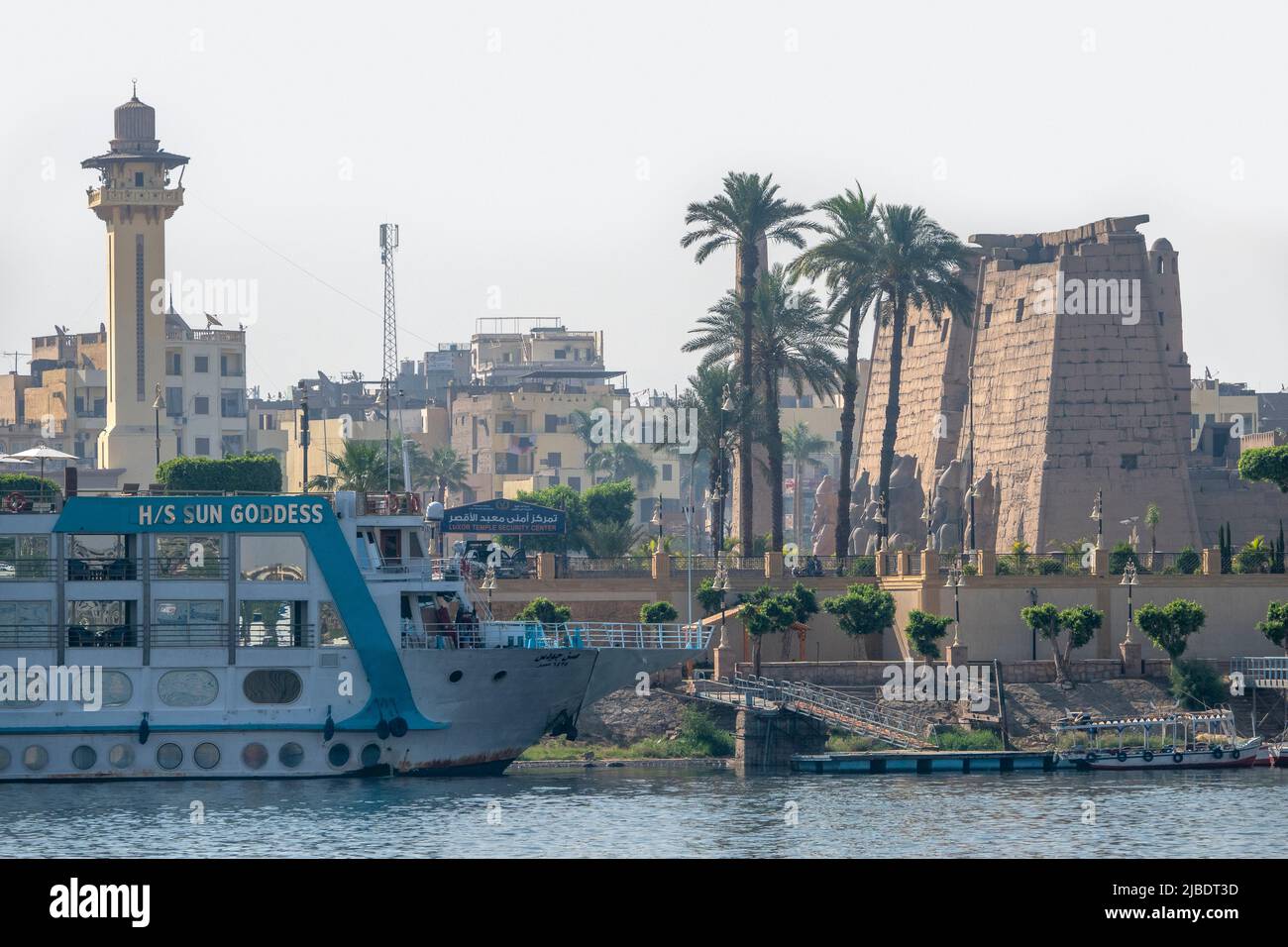 View of Luxor Temple, and Luxor Corniche, taken from the River Nile Stock Photohttps://www.alamy.com/image-license-details/?v=1https://www.alamy.com/view-of-luxor-temple-and-luxor-corniche-taken-from-the-river-nile-image471745441.html
View of Luxor Temple, and Luxor Corniche, taken from the River Nile Stock Photohttps://www.alamy.com/image-license-details/?v=1https://www.alamy.com/view-of-luxor-temple-and-luxor-corniche-taken-from-the-river-nile-image471745441.htmlRM2JBDT3D–View of Luxor Temple, and Luxor Corniche, taken from the River Nile
 Part of the Karnak temple (Ancient Thebes with its Necropolis), the main place of worship of the eighteenth dynasty Theban Triad with the god Amun as Stock Photohttps://www.alamy.com/image-license-details/?v=1https://www.alamy.com/part-of-the-karnak-temple-ancient-thebes-with-its-necropolis-the-main-place-of-worship-of-the-eighteenth-dynasty-theban-triad-with-the-god-amun-as-image182738804.html
Part of the Karnak temple (Ancient Thebes with its Necropolis), the main place of worship of the eighteenth dynasty Theban Triad with the god Amun as Stock Photohttps://www.alamy.com/image-license-details/?v=1https://www.alamy.com/part-of-the-karnak-temple-ancient-thebes-with-its-necropolis-the-main-place-of-worship-of-the-eighteenth-dynasty-theban-triad-with-the-god-amun-as-image182738804.htmlRFMH8D5T–Part of the Karnak temple (Ancient Thebes with its Necropolis), the main place of worship of the eighteenth dynasty Theban Triad with the god Amun as
 KARNAK TEMPLES IN EGYPT Stock Photohttps://www.alamy.com/image-license-details/?v=1https://www.alamy.com/karnak-temples-in-egypt-image387132922.html
KARNAK TEMPLES IN EGYPT Stock Photohttps://www.alamy.com/image-license-details/?v=1https://www.alamy.com/karnak-temples-in-egypt-image387132922.htmlRF2DDRBYP–KARNAK TEMPLES IN EGYPT
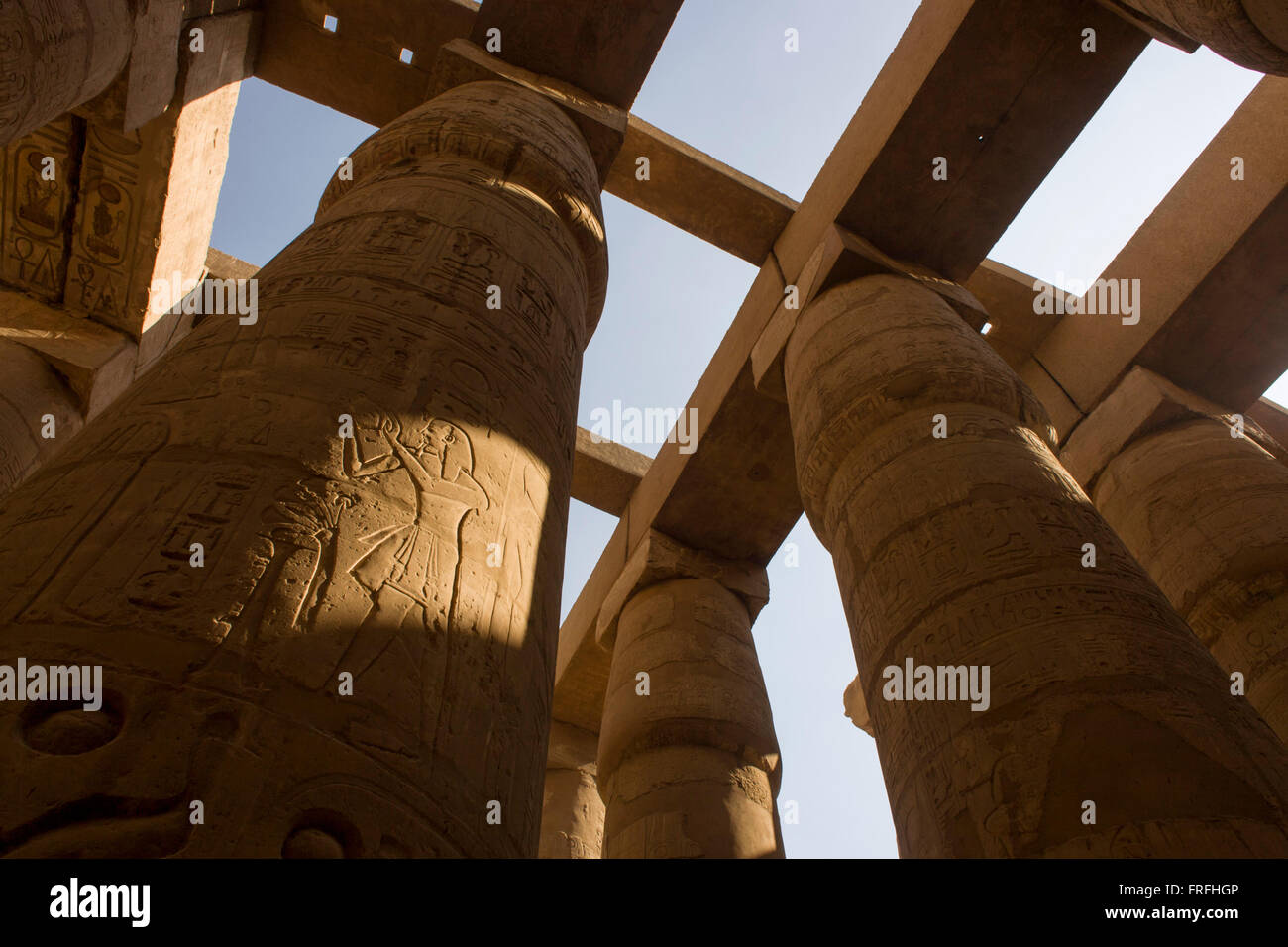 The tall columns in the Hypostyle hall at the Temple of Amun at Karnak, Luxor, Nile Valley, Egypt. The Karnak Temple Complex is the largest religious building ever made, covering about 200 acres. It comprises a vast mix of decayed temples, chapels, pylons, and other buildings built over 2,000 years and dedicated to the Theban triad of Amun, Mut, and Khonsu. The Hypostyle hall, at 54,000 square feet (16,459 meters) and featuring 134 columns, is still the largest room of any religious building in the world. Stock Photohttps://www.alamy.com/image-license-details/?v=1https://www.alamy.com/stock-photo-the-tall-columns-in-the-hypostyle-hall-at-the-temple-of-amun-at-karnak-100532006.html
The tall columns in the Hypostyle hall at the Temple of Amun at Karnak, Luxor, Nile Valley, Egypt. The Karnak Temple Complex is the largest religious building ever made, covering about 200 acres. It comprises a vast mix of decayed temples, chapels, pylons, and other buildings built over 2,000 years and dedicated to the Theban triad of Amun, Mut, and Khonsu. The Hypostyle hall, at 54,000 square feet (16,459 meters) and featuring 134 columns, is still the largest room of any religious building in the world. Stock Photohttps://www.alamy.com/image-license-details/?v=1https://www.alamy.com/stock-photo-the-tall-columns-in-the-hypostyle-hall-at-the-temple-of-amun-at-karnak-100532006.htmlRMFRFHGP–The tall columns in the Hypostyle hall at the Temple of Amun at Karnak, Luxor, Nile Valley, Egypt. The Karnak Temple Complex is the largest religious building ever made, covering about 200 acres. It comprises a vast mix of decayed temples, chapels, pylons, and other buildings built over 2,000 years and dedicated to the Theban triad of Amun, Mut, and Khonsu. The Hypostyle hall, at 54,000 square feet (16,459 meters) and featuring 134 columns, is still the largest room of any religious building in the world.
 Close up of relief work on some of the broken blocks in magazines at the Temple at Karnak, Luxor Egypt Stock Photohttps://www.alamy.com/image-license-details/?v=1https://www.alamy.com/stock-photo-close-up-of-relief-work-on-some-of-the-broken-blocks-in-magazines-79882515.html
Close up of relief work on some of the broken blocks in magazines at the Temple at Karnak, Luxor Egypt Stock Photohttps://www.alamy.com/image-license-details/?v=1https://www.alamy.com/stock-photo-close-up-of-relief-work-on-some-of-the-broken-blocks-in-magazines-79882515.htmlRFEHXXXY–Close up of relief work on some of the broken blocks in magazines at the Temple at Karnak, Luxor Egypt
 Relief depicting god Amun with great helmet covered with two large feathers and beard sitting on the throne. First court of Ramses II. New Empire. Temple of Luxor. Egypt. Stock Photohttps://www.alamy.com/image-license-details/?v=1https://www.alamy.com/relief-depicting-god-amun-with-great-helmet-covered-with-two-large-feathers-and-beard-sitting-on-the-throne-first-court-of-ramses-ii-new-empire-temple-of-luxor-egypt-image209619162.html
Relief depicting god Amun with great helmet covered with two large feathers and beard sitting on the throne. First court of Ramses II. New Empire. Temple of Luxor. Egypt. Stock Photohttps://www.alamy.com/image-license-details/?v=1https://www.alamy.com/relief-depicting-god-amun-with-great-helmet-covered-with-two-large-feathers-and-beard-sitting-on-the-throne-first-court-of-ramses-ii-new-empire-temple-of-luxor-egypt-image209619162.htmlRMP50YAJ–Relief depicting god Amun with great helmet covered with two large feathers and beard sitting on the throne. First court of Ramses II. New Empire. Temple of Luxor. Egypt.
 Tourists visit the pillars at the Karnak Temple in the monumental city of Thebes near Luxor, Egypt. Egyptian hieroglyphics decorate the walls of the t Stock Photohttps://www.alamy.com/image-license-details/?v=1https://www.alamy.com/tourists-visit-the-pillars-at-the-karnak-temple-in-the-monumental-city-of-thebes-near-luxor-egypt-egyptian-hieroglyphics-decorate-the-walls-of-the-t-image355955251.html
Tourists visit the pillars at the Karnak Temple in the monumental city of Thebes near Luxor, Egypt. Egyptian hieroglyphics decorate the walls of the t Stock Photohttps://www.alamy.com/image-license-details/?v=1https://www.alamy.com/tourists-visit-the-pillars-at-the-karnak-temple-in-the-monumental-city-of-thebes-near-luxor-egypt-egyptian-hieroglyphics-decorate-the-walls-of-the-t-image355955251.htmlRM2BK34FF–Tourists visit the pillars at the Karnak Temple in the monumental city of Thebes near Luxor, Egypt. Egyptian hieroglyphics decorate the walls of the t
 Old Egypt hieroglyphs carved on the stone wall in The Karnak Temple Complex, Luxor, Egypt (ancient Thebes). Stock Photohttps://www.alamy.com/image-license-details/?v=1https://www.alamy.com/old-egypt-hieroglyphs-carved-on-the-stone-wall-in-the-karnak-temple-complex-luxor-egypt-ancient-thebes-image471803478.html
Old Egypt hieroglyphs carved on the stone wall in The Karnak Temple Complex, Luxor, Egypt (ancient Thebes). Stock Photohttps://www.alamy.com/image-license-details/?v=1https://www.alamy.com/old-egypt-hieroglyphs-carved-on-the-stone-wall-in-the-karnak-temple-complex-luxor-egypt-ancient-thebes-image471803478.htmlRF2JBGE46–Old Egypt hieroglyphs carved on the stone wall in The Karnak Temple Complex, Luxor, Egypt (ancient Thebes).
 Karnak Temple Complex, in Luxor, Egypt. Construction at the complex began during the reign of Senusret I in the Middle Kingdom and continued into the Ptolemaic period, although most of the extant buildings date from the New Kingdom. The area around Karnak was the main place of worship of the eighteenth dynasty Theban Triad with the god Amun as its head. It is part of the monumental city of Thebes. Stock Photohttps://www.alamy.com/image-license-details/?v=1https://www.alamy.com/karnak-temple-complex-in-luxor-egypt-construction-at-the-complex-began-during-the-reign-of-senusret-i-in-the-middle-kingdom-and-continued-into-the-ptolemaic-period-although-most-of-the-extant-buildings-date-from-the-new-kingdom-the-area-around-karnak-was-the-main-place-of-worship-of-the-eighteenth-dynasty-theban-triad-with-the-god-amun-as-its-head-it-is-part-of-the-monumental-city-of-thebes-image328340285.html
Karnak Temple Complex, in Luxor, Egypt. Construction at the complex began during the reign of Senusret I in the Middle Kingdom and continued into the Ptolemaic period, although most of the extant buildings date from the New Kingdom. The area around Karnak was the main place of worship of the eighteenth dynasty Theban Triad with the god Amun as its head. It is part of the monumental city of Thebes. Stock Photohttps://www.alamy.com/image-license-details/?v=1https://www.alamy.com/karnak-temple-complex-in-luxor-egypt-construction-at-the-complex-began-during-the-reign-of-senusret-i-in-the-middle-kingdom-and-continued-into-the-ptolemaic-period-although-most-of-the-extant-buildings-date-from-the-new-kingdom-the-area-around-karnak-was-the-main-place-of-worship-of-the-eighteenth-dynasty-theban-triad-with-the-god-amun-as-its-head-it-is-part-of-the-monumental-city-of-thebes-image328340285.htmlRM2A255AN–Karnak Temple Complex, in Luxor, Egypt. Construction at the complex began during the reign of Senusret I in the Middle Kingdom and continued into the Ptolemaic period, although most of the extant buildings date from the New Kingdom. The area around Karnak was the main place of worship of the eighteenth dynasty Theban Triad with the god Amun as its head. It is part of the monumental city of Thebes.
 Relief depicting god Amun with great helmet covered with two large feathers and beard sitting on the throne. Luxor. Stock Photohttps://www.alamy.com/image-license-details/?v=1https://www.alamy.com/stock-photo-relief-depicting-god-amun-with-great-helmet-covered-with-two-large-27234802.html
Relief depicting god Amun with great helmet covered with two large feathers and beard sitting on the throne. Luxor. Stock Photohttps://www.alamy.com/image-license-details/?v=1https://www.alamy.com/stock-photo-relief-depicting-god-amun-with-great-helmet-covered-with-two-large-27234802.htmlRMBG8J7E–Relief depicting god Amun with great helmet covered with two large feathers and beard sitting on the throne. Luxor.